-
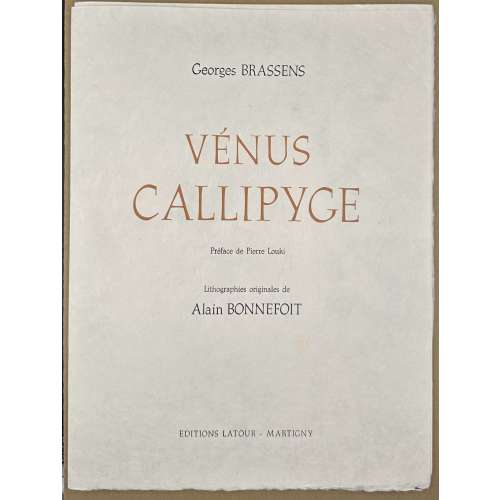 NEWUnbound, unpaginated volume in illustrated French flapped wrappers, 360 x 270 mm, printed on mother-of-pearl Japanese paper, collated 154 + 142, 60+28, 44 leaves in-folio, folded in half, profusely illustrated with original colour lithograph, in a grey cloth clamshell box (390 x 290 x 90 mm) with inside pocket for CD (lacking), embossed vignette to front; limited edition of 284 copies, signed copy № 59 of 50 copies printed on Japon Nacré paper numbered 30-80. Includes 13 double-page colour plates signed by the artist, enriched with an original watercolour drawing on the back of the title-page, with autograph dedication "A Monsieur et Madame Kuhn Amicalement A Bonnefoit". Title-page (black and sanguine): GEORGES BRASSENS | VÉNUS | CALLIPYGE | Préface de Pierre Louki | Lithographies originales de | Alain BONNEFOIT | ÉDITIONS LATOUR – MARTIGNY || Colophon : Achevé d'imprimer | le 8 novembre 1993 | sur les presses de Pierre Jean Mathan | Boulogne-sur-Seine. | Les lithographies ont été tirées | dans les ateliers de Jean-Claude Perrin | Arts-Litho à Paris. | L'emboitage est de Piero Dallai | à Forence. || Deluxe edition of a collection of 13 songs by Brassens, illustrated with more than thirty original lithographs by Alain Bonnefoit, Contributors: Alain Bonnefoit (French, b. 1937) – artist Georges Brassens (French, 1821 – 1981) – author poetry Louki, Pierre (French, 1920 – 2006) – author preface Éditions Latour (Martigny) – publisher Pierre Jean Mathan (Boulogne-sur-Seine) – printer Jean-Claude Perrin, Arts-Litho (Paris) – lithorgapher Piero Dallai (Forence) – slipcase
NEWUnbound, unpaginated volume in illustrated French flapped wrappers, 360 x 270 mm, printed on mother-of-pearl Japanese paper, collated 154 + 142, 60+28, 44 leaves in-folio, folded in half, profusely illustrated with original colour lithograph, in a grey cloth clamshell box (390 x 290 x 90 mm) with inside pocket for CD (lacking), embossed vignette to front; limited edition of 284 copies, signed copy № 59 of 50 copies printed on Japon Nacré paper numbered 30-80. Includes 13 double-page colour plates signed by the artist, enriched with an original watercolour drawing on the back of the title-page, with autograph dedication "A Monsieur et Madame Kuhn Amicalement A Bonnefoit". Title-page (black and sanguine): GEORGES BRASSENS | VÉNUS | CALLIPYGE | Préface de Pierre Louki | Lithographies originales de | Alain BONNEFOIT | ÉDITIONS LATOUR – MARTIGNY || Colophon : Achevé d'imprimer | le 8 novembre 1993 | sur les presses de Pierre Jean Mathan | Boulogne-sur-Seine. | Les lithographies ont été tirées | dans les ateliers de Jean-Claude Perrin | Arts-Litho à Paris. | L'emboitage est de Piero Dallai | à Forence. || Deluxe edition of a collection of 13 songs by Brassens, illustrated with more than thirty original lithographs by Alain Bonnefoit, Contributors: Alain Bonnefoit (French, b. 1937) – artist Georges Brassens (French, 1821 – 1981) – author poetry Louki, Pierre (French, 1920 – 2006) – author preface Éditions Latour (Martigny) – publisher Pierre Jean Mathan (Boulogne-sur-Seine) – printer Jean-Claude Perrin, Arts-Litho (Paris) – lithorgapher Piero Dallai (Forence) – slipcase -
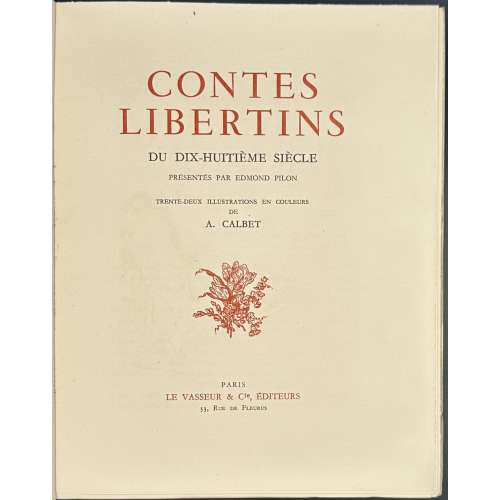 NEWSoftcover, cream French flapped wrappers, 242 x 192 mm, glassine dust jacket, lower and outer margins untrimmed, red lettering to front wrapper CONTES LIBERTINS | DU | DIX-HUITIÈME SIÈCLE; in a double slipcase; 10 full-page colour intaglio prints, incl. frontispiece, and 10 half-page coloured prints after Antoine Calbet; pp.: [1-8] 9-223 [224] [6], total 115 leaves plus ten plates with tissue guards extraneous to collation. Copy enhanced with a full suite of 32 uncoloured intaglio prints, and 12 refused plates:
NEWSoftcover, cream French flapped wrappers, 242 x 192 mm, glassine dust jacket, lower and outer margins untrimmed, red lettering to front wrapper CONTES LIBERTINS | DU | DIX-HUITIÈME SIÈCLE; in a double slipcase; 10 full-page colour intaglio prints, incl. frontispiece, and 10 half-page coloured prints after Antoine Calbet; pp.: [1-8] 9-223 [224] [6], total 115 leaves plus ten plates with tissue guards extraneous to collation. Copy enhanced with a full suite of 32 uncoloured intaglio prints, and 12 refused plates: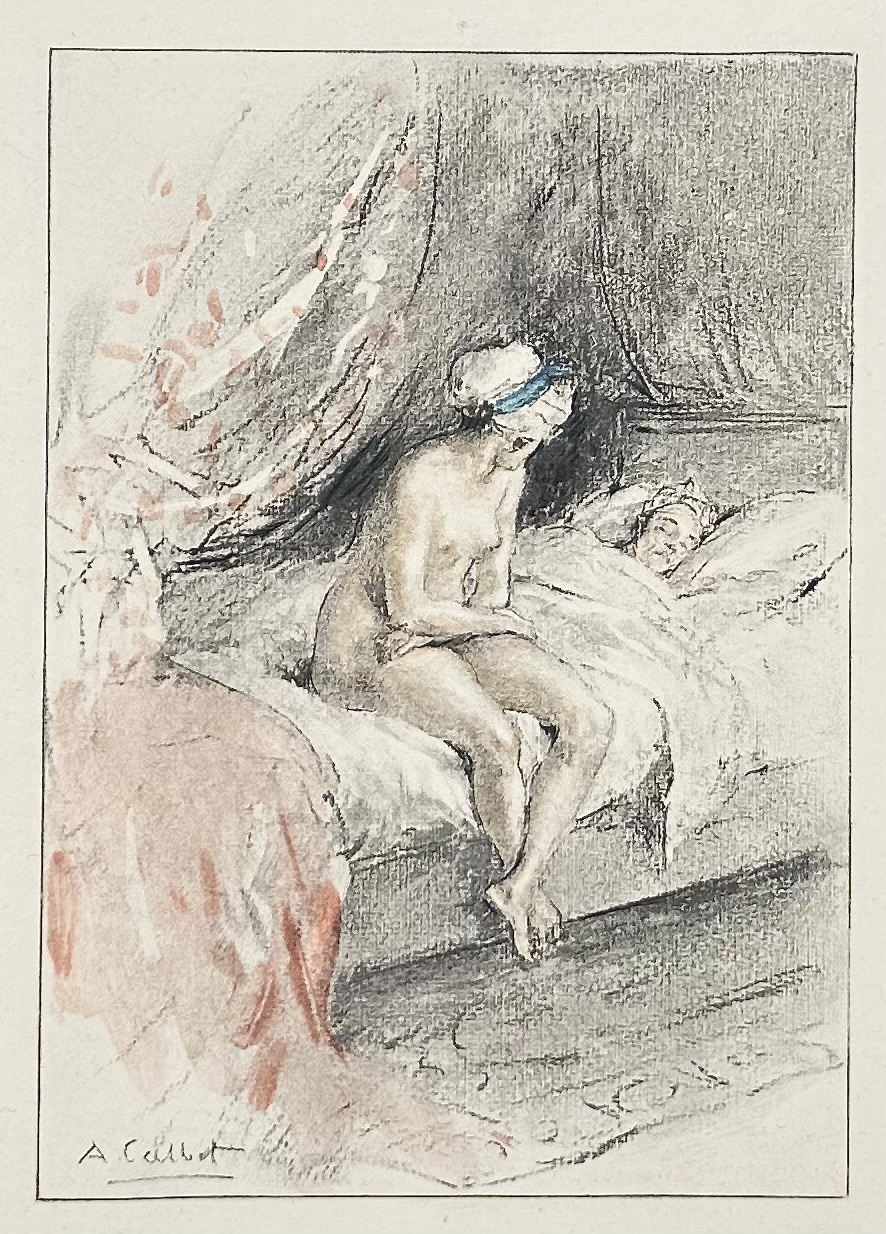
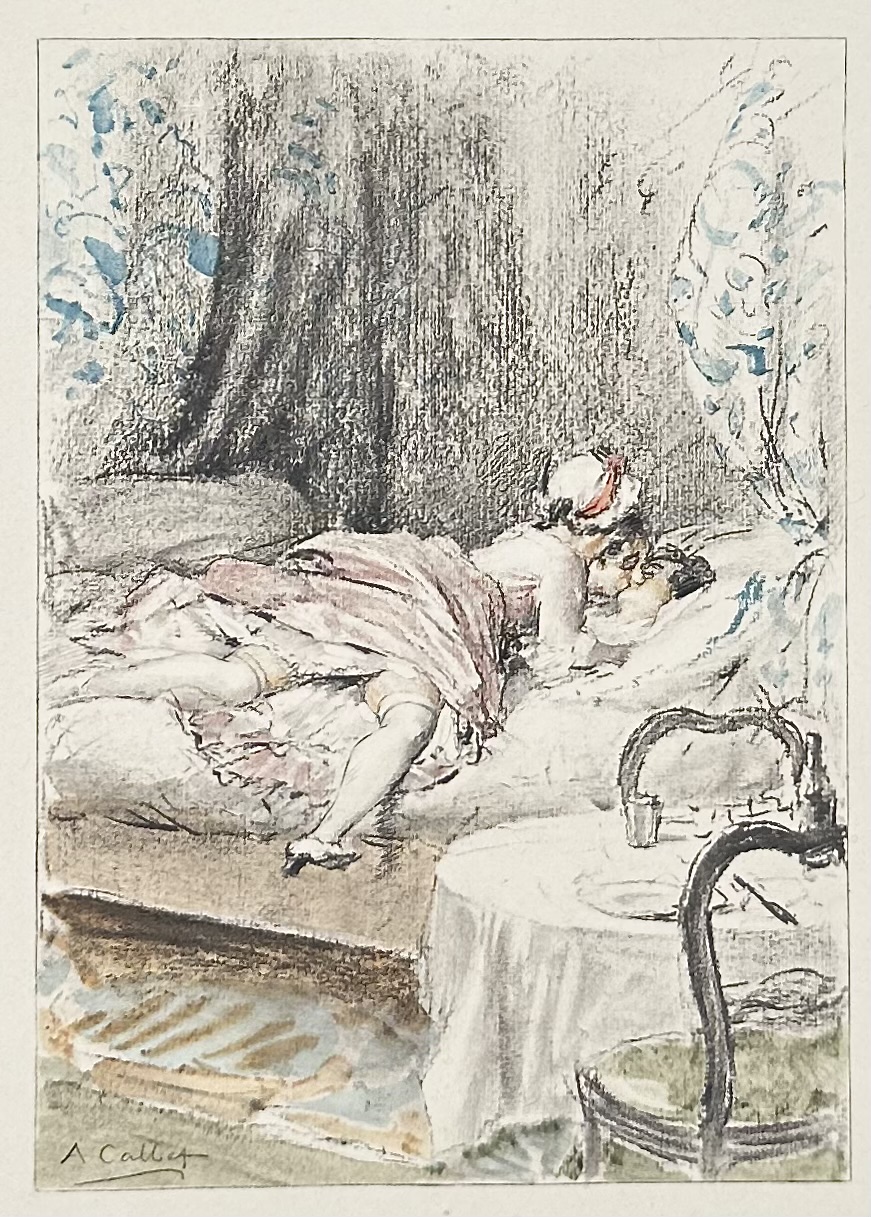
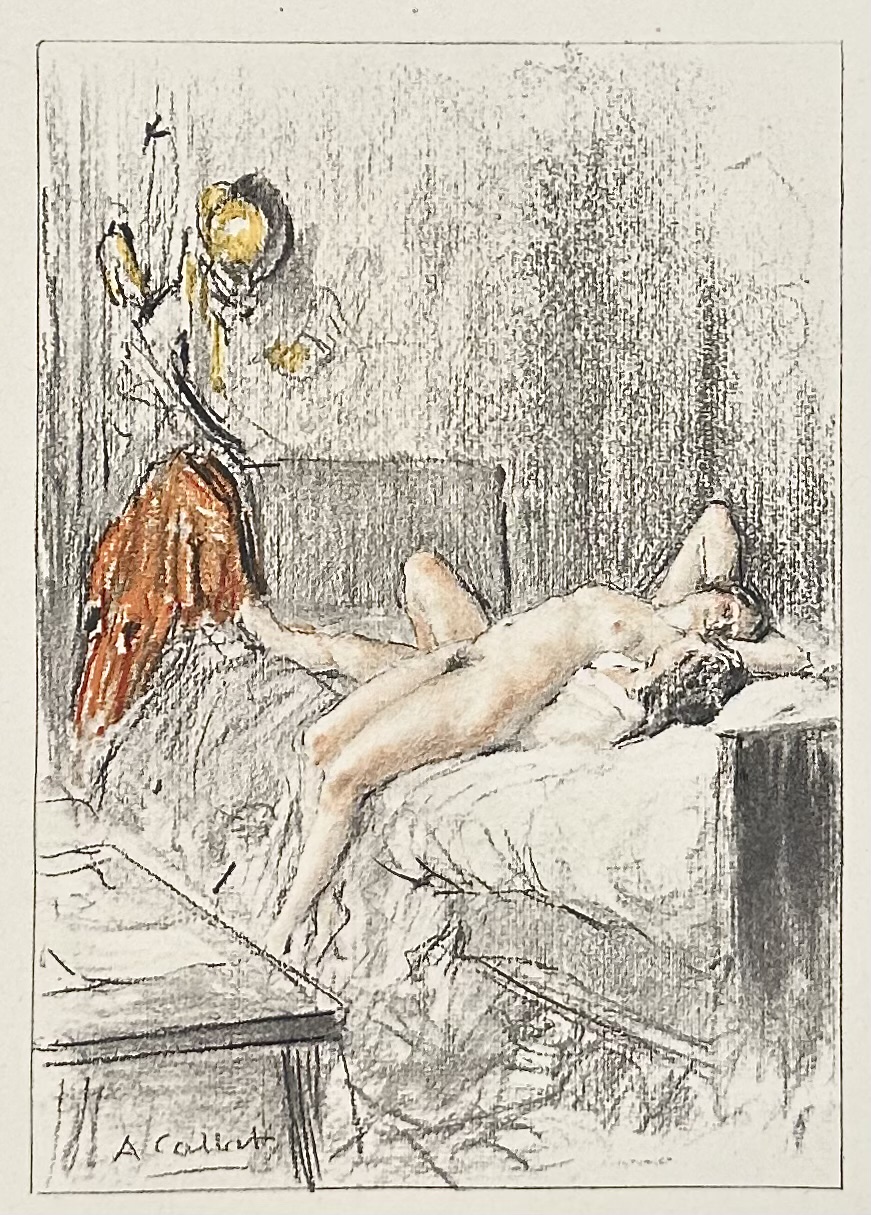
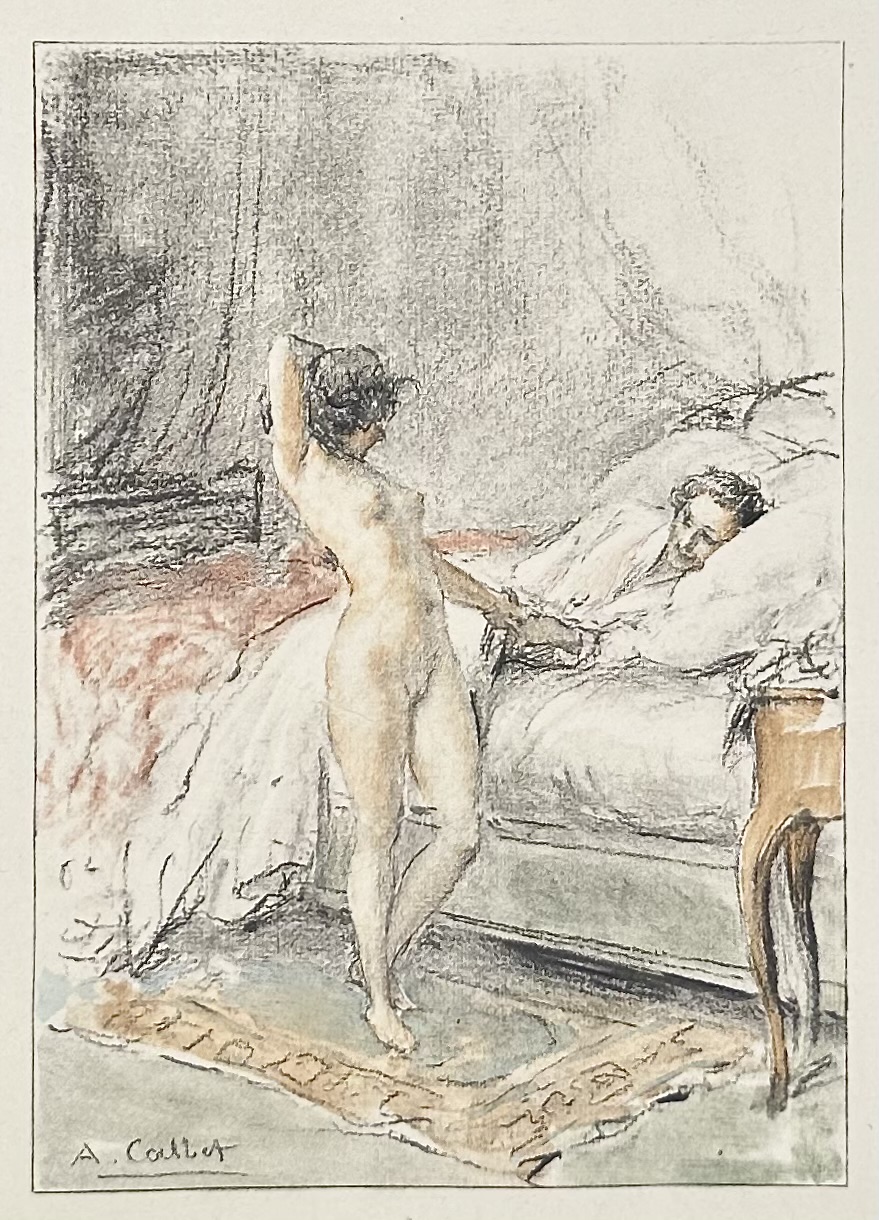
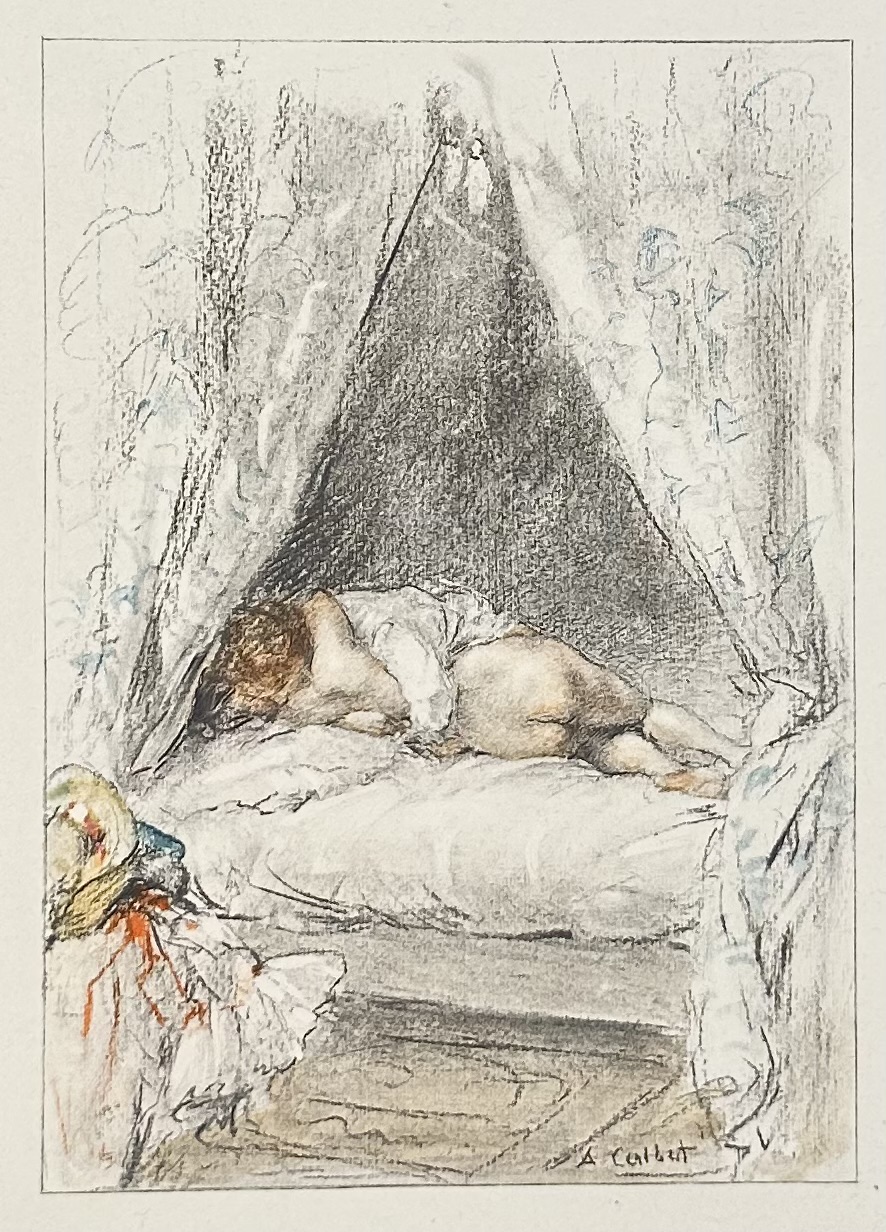
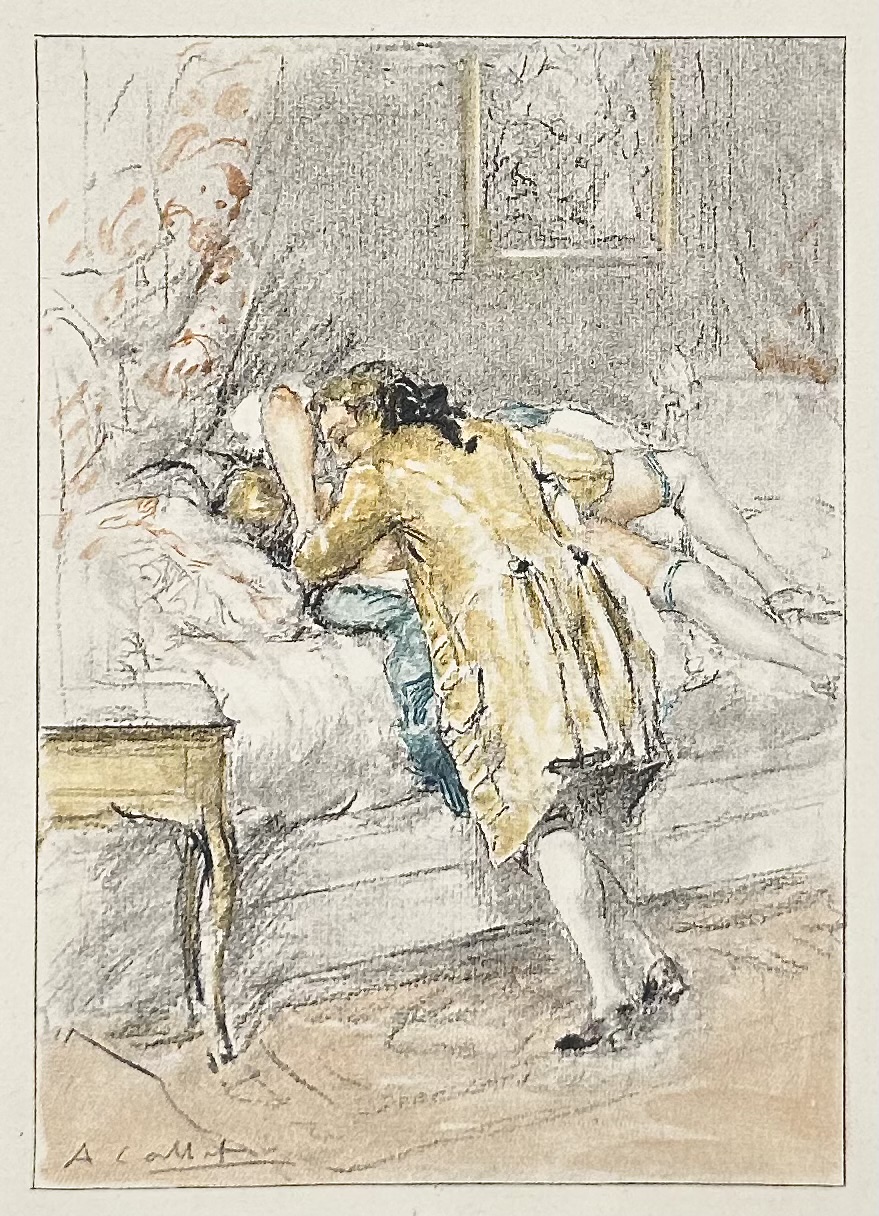
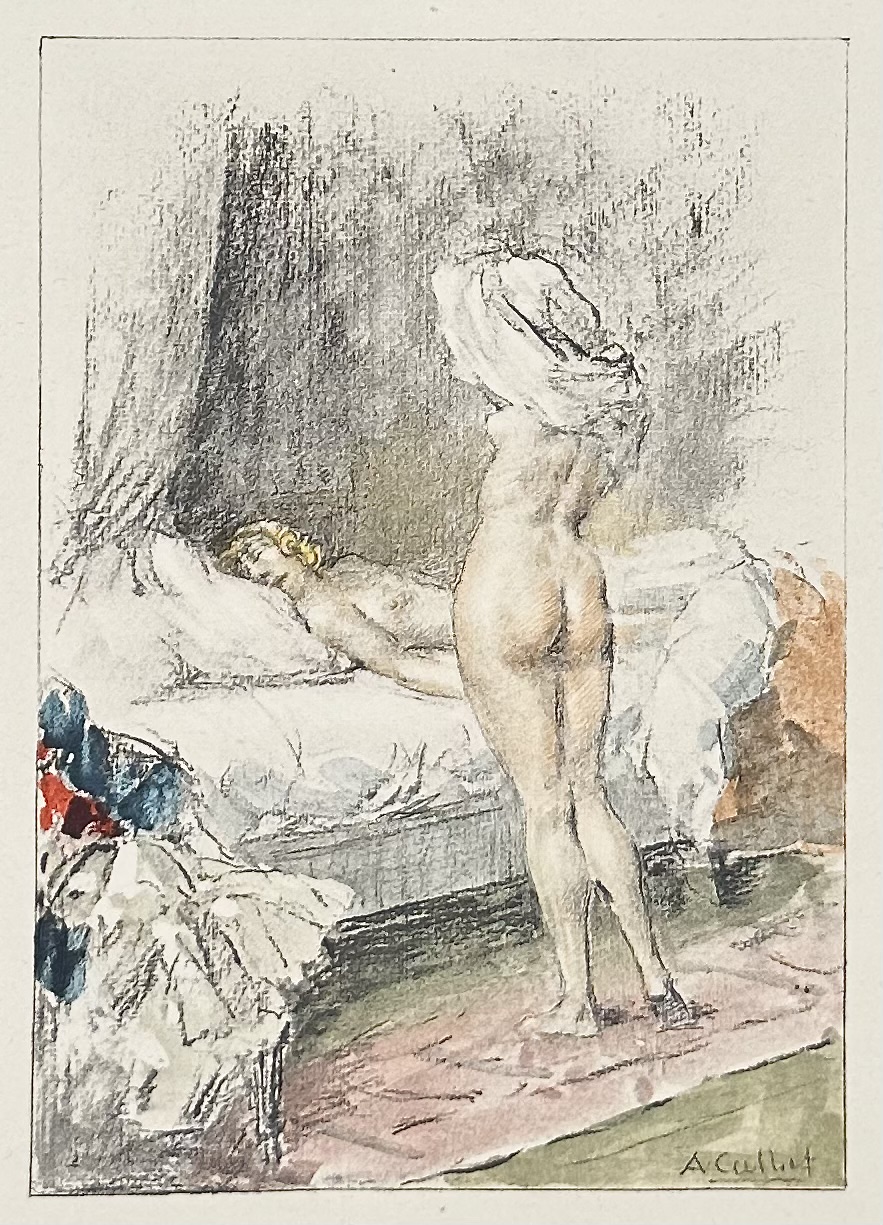
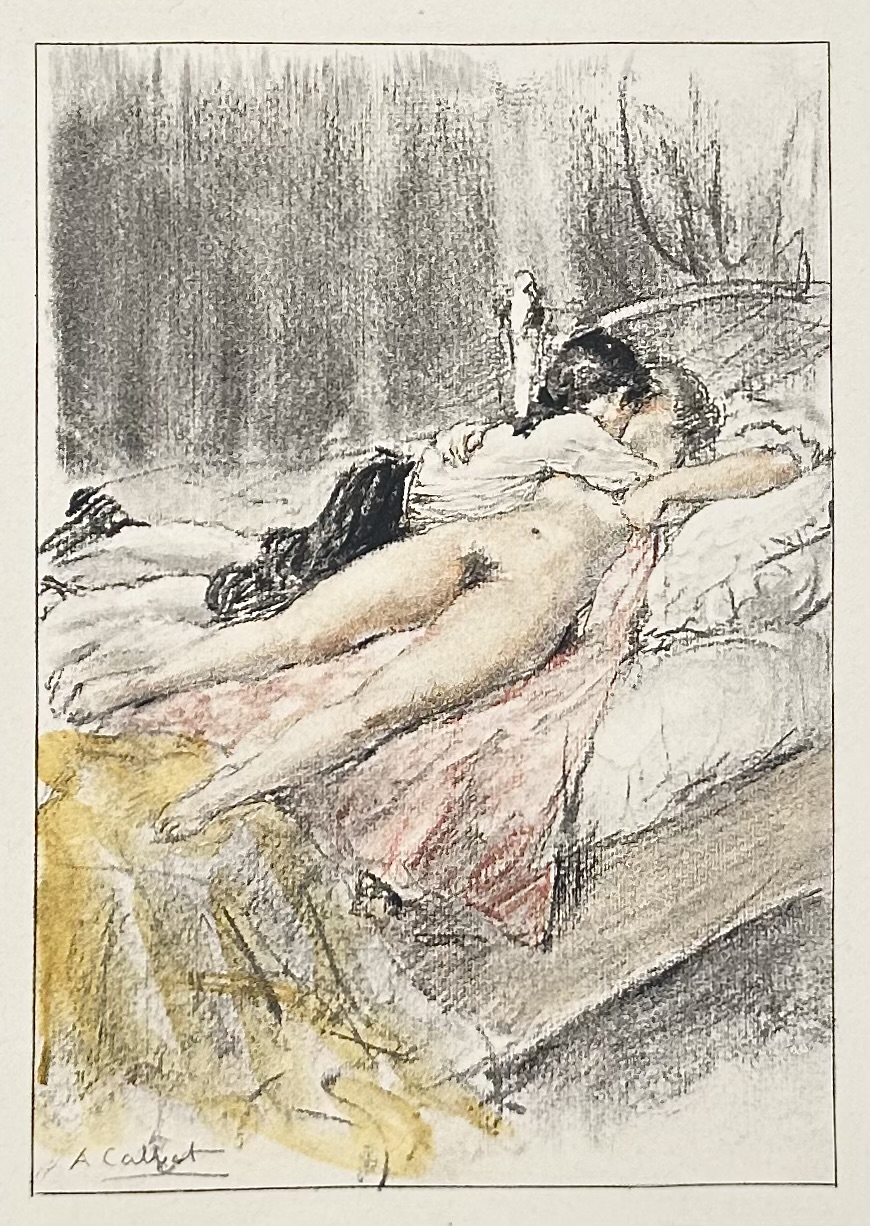
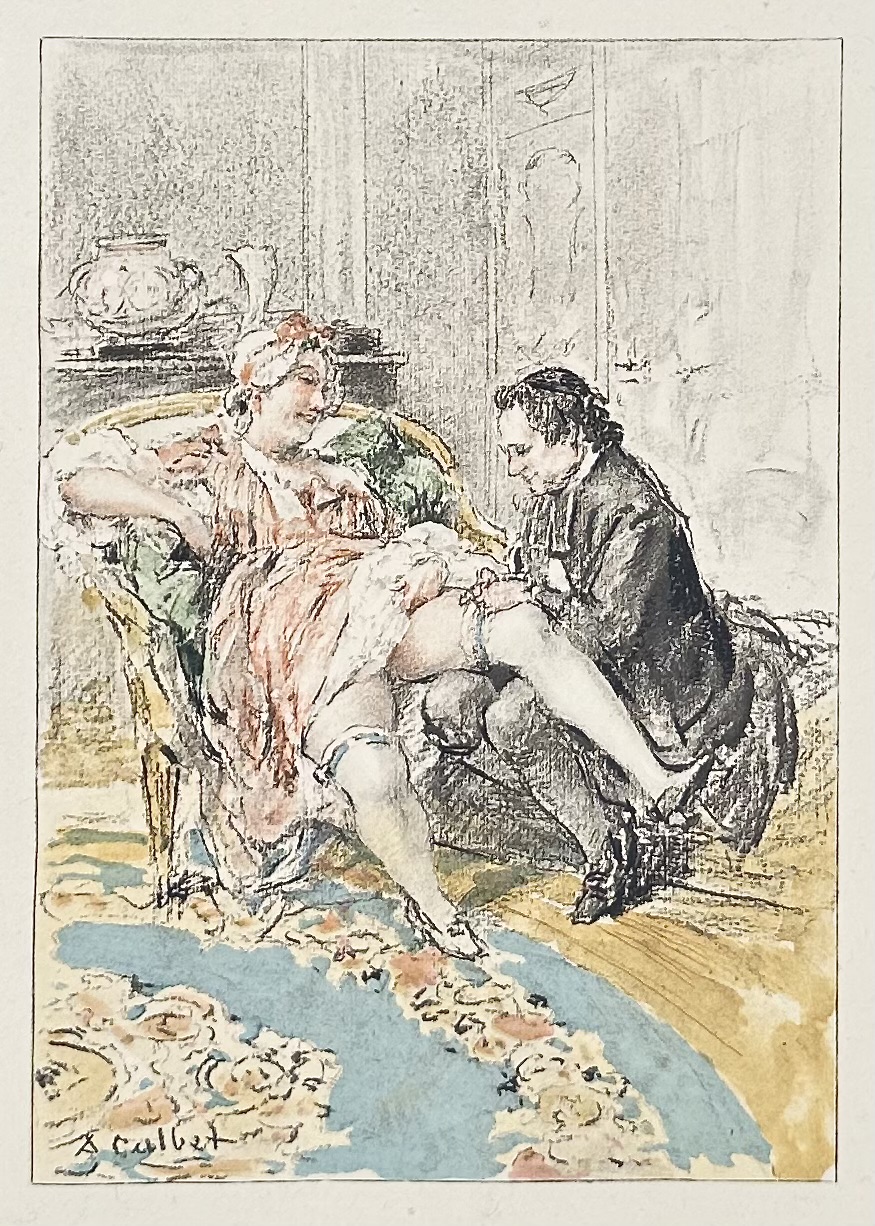
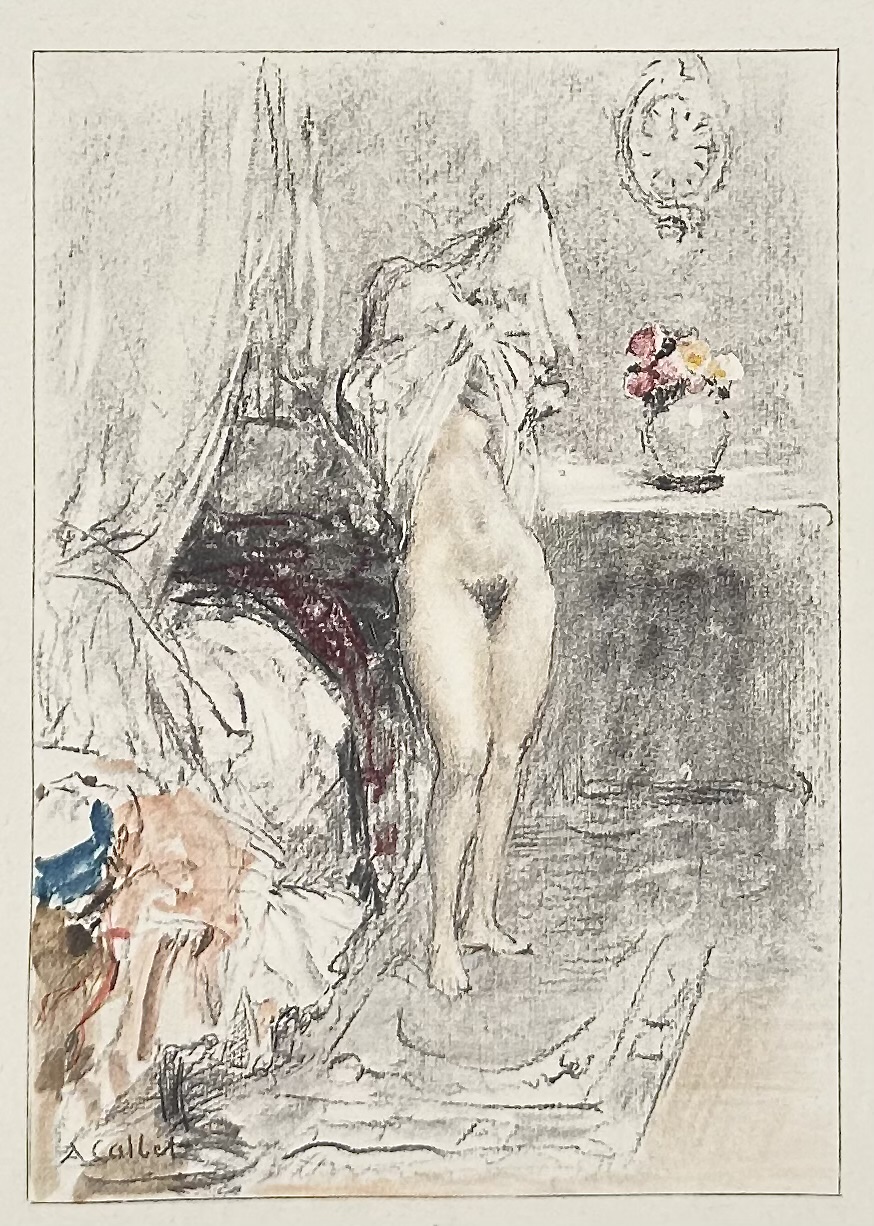
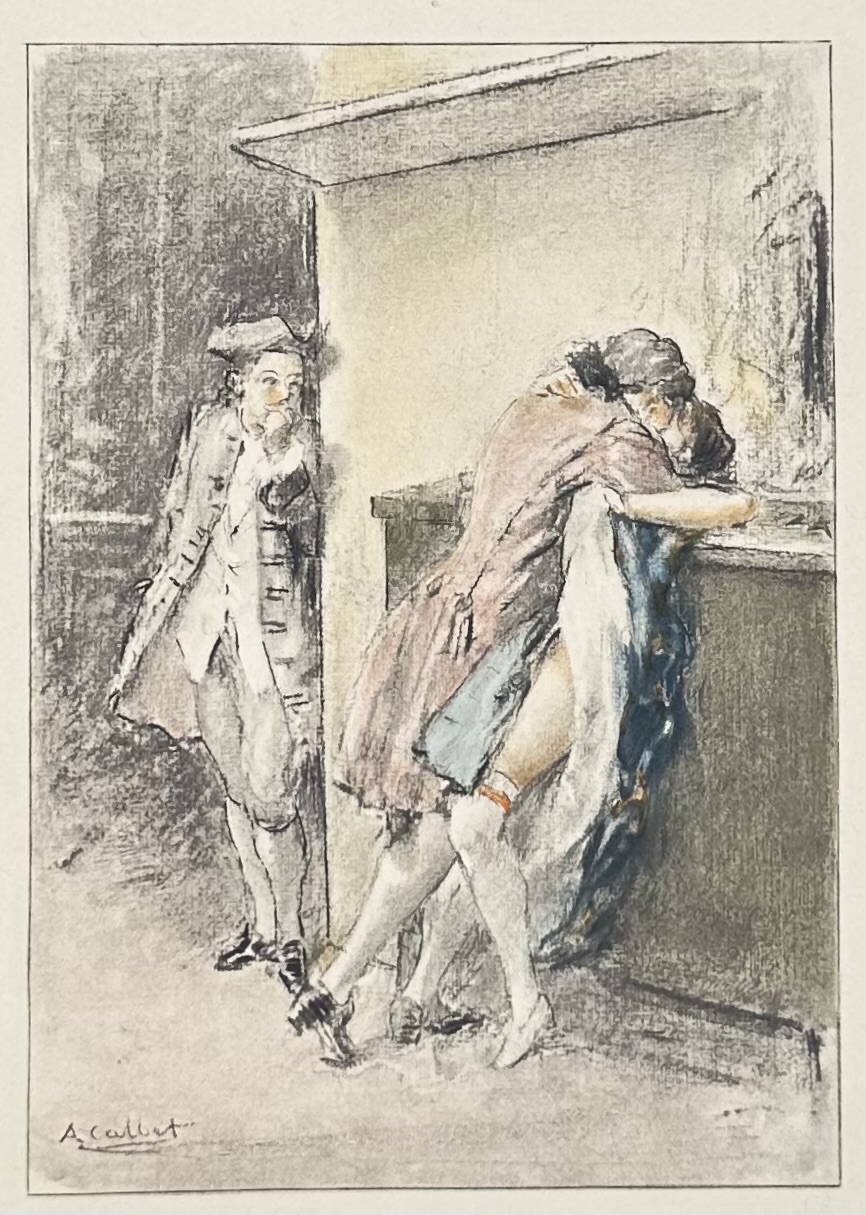
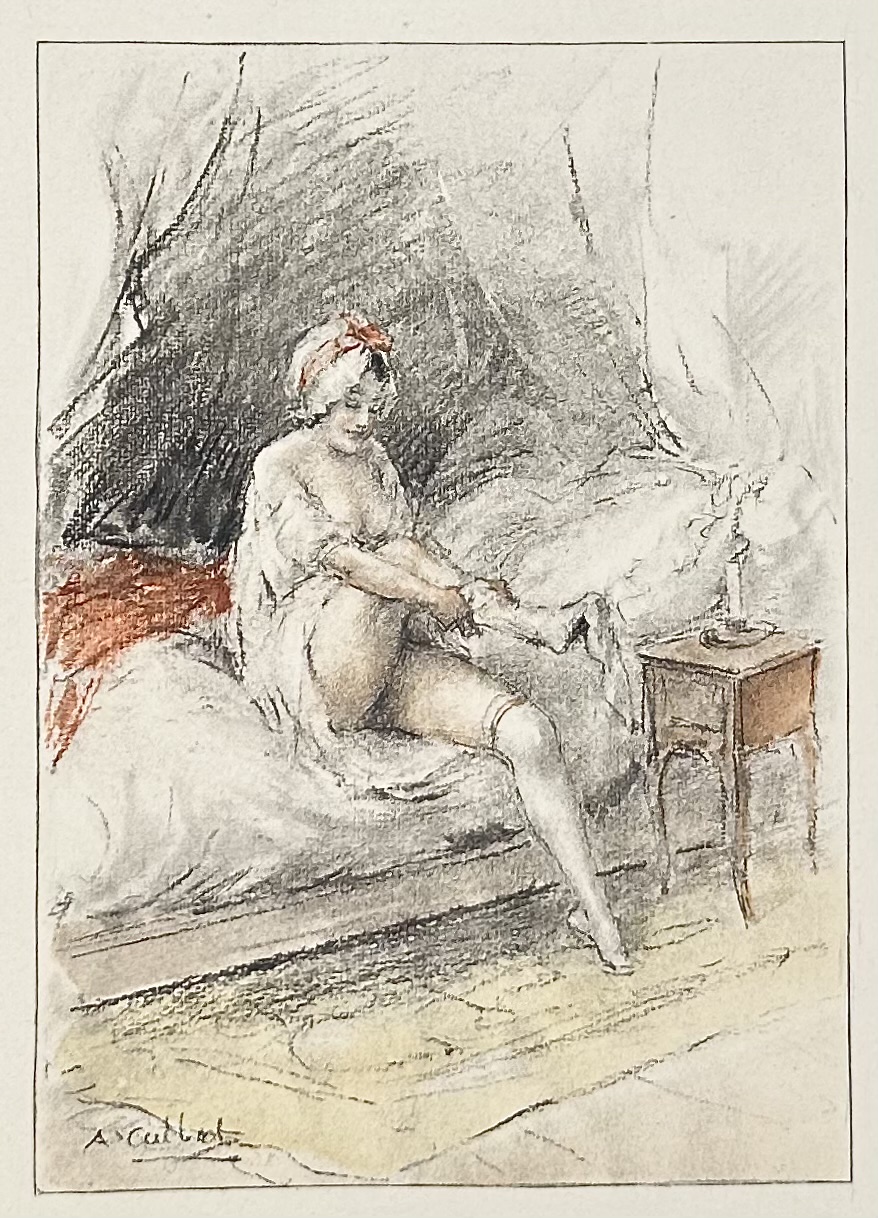 Title-page (red and black): CONTES LIBERTINS | DU DIX-HUITIÈME SIÈCLE | PRÉSENTÉS PAR EDMOND PILON | TRENTE-DEUX ILLUSTRATIONS EN COULEURS | DE | A. CALBET | {fleuron} | PARIS | LE VASSEUR & Cie, ÉDITEURS | 33, Rue de Fleurus ||
Limitation: 587 copies, of which 32 on Japon Impérial (№№ 1-32), 65 on Hollande Van Gilder (№№ 33-97), 490 on Velin a la forme de Rives (№№ 98-587). 25 copies were printed on top of this print run for collaborators, numbered in Roman letters. This copy is № 77 on watermarked Van Gilder Zonnen paper.
Colophon: LE TEXTE DE CET OUVRAGE A | ÉTÉ IMPRIMÉ SUR LES PRESSES | DE CL. JACOUB ET Cie. | LES ILLUSTRATIONS, GRAVÉES PAR L. MACCARD, ONT ÉTÉ | TIRÉES EN TAILLE-DOUCE | PAR A. PORCABEUF ET Cie. | ACHEVÉ D'IMPRIMER, A | PARIS, LE 12 OCTOBRE 1936.
Table of contents:
Histoire de madame Allain – Notice sur le comte de Caylus.
Histoire de Cidal Acmet – Notice sur l'abbé Prevost
Aline, reine de Golconde – Notice sur le chevalier de Boufflers
Cosi-Sancta – notice sur Voltaire.
Cécile, Marine et Bellino – Notice sur Casanova de Seingalt
Histoire de Babet – Notice sur l'abbé Du Laurens
Histoire de Fanny Hill – Notice sur John Cleland.
Louise et Thérèse – Notice sur Rétif de La Bretonne
Contributors:
Pilon, Edmond (French, 1874 – 1945) – compiler
Le Vasseur & Cie – publisher
Calbet, Antoine (French, 1860 – 1942) – artist
Cl. Jacoub et Cie – printer/text
Maccard, Louis (French) – engraver
Porcabeuf, Alfred (French, 1867 – 1952) – printer/plates
Authors:
Caylus, Anne Claude de [comte de Caylus] (French, 1692 – 1765)
Prévost d'Exiles, Antoine François [Abbé Prévost] (French, 1697 – 1763)
Boufflers, Stanislas Jean, chevalier de (French, 1738 – 1815)
Voltaire, François Marie Arouet de (French, 1694 – 1778)
Casanova, Giacomo Girolamo (Italian, 1725 – 1798)
Laurent, Henri-Joseph [Abbé Du Laurens] (French, 1719 – 1793)
Cleland, John (British, c. 1709 – 1789)
Restif [Retif] de la Bretonne, Nicolas Edmé (French, 1734 – 1806)
Title-page (red and black): CONTES LIBERTINS | DU DIX-HUITIÈME SIÈCLE | PRÉSENTÉS PAR EDMOND PILON | TRENTE-DEUX ILLUSTRATIONS EN COULEURS | DE | A. CALBET | {fleuron} | PARIS | LE VASSEUR & Cie, ÉDITEURS | 33, Rue de Fleurus ||
Limitation: 587 copies, of which 32 on Japon Impérial (№№ 1-32), 65 on Hollande Van Gilder (№№ 33-97), 490 on Velin a la forme de Rives (№№ 98-587). 25 copies were printed on top of this print run for collaborators, numbered in Roman letters. This copy is № 77 on watermarked Van Gilder Zonnen paper.
Colophon: LE TEXTE DE CET OUVRAGE A | ÉTÉ IMPRIMÉ SUR LES PRESSES | DE CL. JACOUB ET Cie. | LES ILLUSTRATIONS, GRAVÉES PAR L. MACCARD, ONT ÉTÉ | TIRÉES EN TAILLE-DOUCE | PAR A. PORCABEUF ET Cie. | ACHEVÉ D'IMPRIMER, A | PARIS, LE 12 OCTOBRE 1936.
Table of contents:
Histoire de madame Allain – Notice sur le comte de Caylus.
Histoire de Cidal Acmet – Notice sur l'abbé Prevost
Aline, reine de Golconde – Notice sur le chevalier de Boufflers
Cosi-Sancta – notice sur Voltaire.
Cécile, Marine et Bellino – Notice sur Casanova de Seingalt
Histoire de Babet – Notice sur l'abbé Du Laurens
Histoire de Fanny Hill – Notice sur John Cleland.
Louise et Thérèse – Notice sur Rétif de La Bretonne
Contributors:
Pilon, Edmond (French, 1874 – 1945) – compiler
Le Vasseur & Cie – publisher
Calbet, Antoine (French, 1860 – 1942) – artist
Cl. Jacoub et Cie – printer/text
Maccard, Louis (French) – engraver
Porcabeuf, Alfred (French, 1867 – 1952) – printer/plates
Authors:
Caylus, Anne Claude de [comte de Caylus] (French, 1692 – 1765)
Prévost d'Exiles, Antoine François [Abbé Prévost] (French, 1697 – 1763)
Boufflers, Stanislas Jean, chevalier de (French, 1738 – 1815)
Voltaire, François Marie Arouet de (French, 1694 – 1778)
Casanova, Giacomo Girolamo (Italian, 1725 – 1798)
Laurent, Henri-Joseph [Abbé Du Laurens] (French, 1719 – 1793)
Cleland, John (British, c. 1709 – 1789)
Restif [Retif] de la Bretonne, Nicolas Edmé (French, 1734 – 1806) -
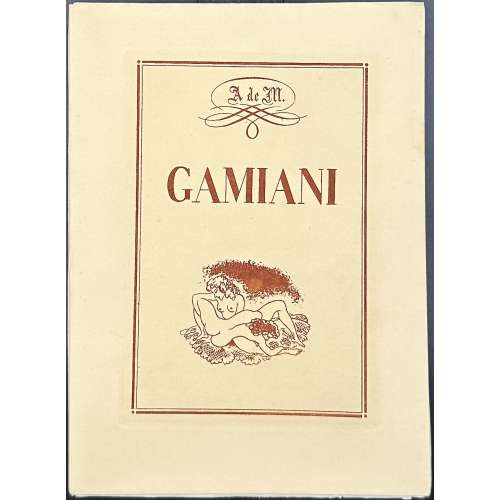 NEWSoftcover volume 200 x 145 mm, in a slipcase, unbound, in French wrappers, sanguine lettering on cream paper, block printed on wove paper with watermark “Marais”, collated 8vo, pp.: [1-6] 7-114 [6], 60 leaves, first and last leaves blank; illustrated with 20 etchings, incl. vignette on front wrapper, two head- and two tailpieces, printed in sanguine; etching on t.p., similar to the one on the front wrapper, printed in black. Limited edition of 250 copies, this is copy № 24. Front wrapper and title-page: in a double frame A de M. | GAMIANI | {vignette} || Colophon: CE LIVRE | IMPRIMÉ AUX DÉPENS | D'UN GROUP D'AMATEURS | SUR PAPIER CHIFFON | A ÉTÉ TIRE | A DEUX CENT CINQUANTE EXEMPLAIRES | LA VENTE AU PUBLIC | EN EST RIGOUREUSEMENT INTERDITE | EXEMPLAIRE N°24 || [This book is printed at the expense of a group of amateurs on rag paper in two hundred and fifty copies; sale to the public is strictly prohibited]. Catalogue raisonné: Dutel III № 1649. Alfred de Musset (French, 1810 – 1857) – author.
NEWSoftcover volume 200 x 145 mm, in a slipcase, unbound, in French wrappers, sanguine lettering on cream paper, block printed on wove paper with watermark “Marais”, collated 8vo, pp.: [1-6] 7-114 [6], 60 leaves, first and last leaves blank; illustrated with 20 etchings, incl. vignette on front wrapper, two head- and two tailpieces, printed in sanguine; etching on t.p., similar to the one on the front wrapper, printed in black. Limited edition of 250 copies, this is copy № 24. Front wrapper and title-page: in a double frame A de M. | GAMIANI | {vignette} || Colophon: CE LIVRE | IMPRIMÉ AUX DÉPENS | D'UN GROUP D'AMATEURS | SUR PAPIER CHIFFON | A ÉTÉ TIRE | A DEUX CENT CINQUANTE EXEMPLAIRES | LA VENTE AU PUBLIC | EN EST RIGOUREUSEMENT INTERDITE | EXEMPLAIRE N°24 || [This book is printed at the expense of a group of amateurs on rag paper in two hundred and fifty copies; sale to the public is strictly prohibited]. Catalogue raisonné: Dutel III № 1649. Alfred de Musset (French, 1810 – 1857) – author. -
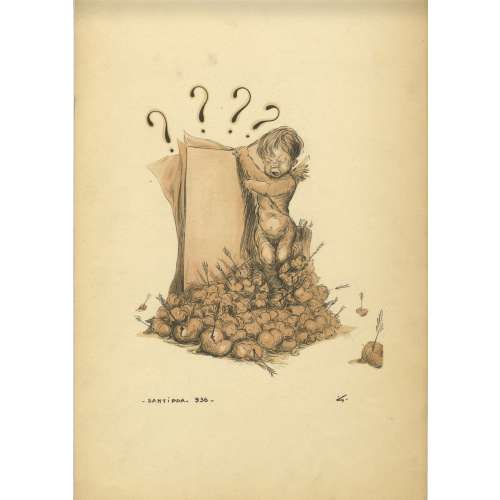 Publisher's flapped folder of black velvet paper with dark green embossed vignette, 494 x 325 mm, with a pink limitation label inside the front cover and a printed spade with 'FIN" inside the back cover; a set of 13 lithographs signed Santippa, 936; 480 x 310 mm each, twelve in black and one (title) coloured with sanguine. Limited edition of 250 copies, 1-100 printed on Hollande and 150 on Japon; this is copy № 127.
Publisher's flapped folder of black velvet paper with dark green embossed vignette, 494 x 325 mm, with a pink limitation label inside the front cover and a printed spade with 'FIN" inside the back cover; a set of 13 lithographs signed Santippa, 936; 480 x 310 mm each, twelve in black and one (title) coloured with sanguine. Limited edition of 250 copies, 1-100 printed on Hollande and 150 on Japon; this is copy № 127.Titles: Rêverie, Gaspillage, Exagération, Simplicité, Gourmandise, Abondance, Violence, Fantaisie, Faiblesse, Curiosité, Obligeance, Surprise.
Contributors:Gaston Hoffmann [Santippa] (French, 1883 – 1977)
-
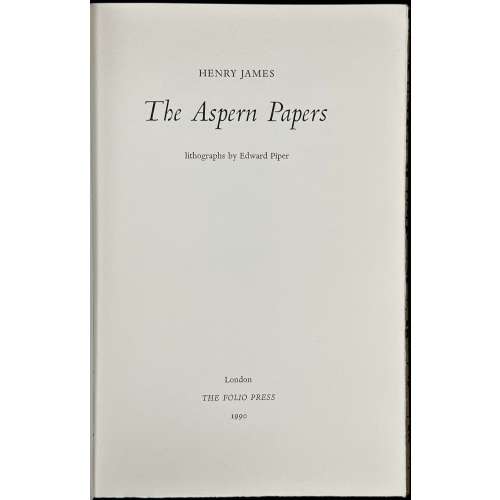 Hardcover volume, 21.5 x 14.7 x 5.7 cm, bound in red cloth with blind-stamped ms signature to front board and gilt lettering over black labels, and gild design elements to spine; pp.: [i-iv] (h.t./blank, t.p./copyright) v-xv[xvi] blank, [1-2] f.t./blank, 3-1653 [1654] blank, [2] publ. note/blank; 1672 pp total; Blue ink ms inscription to h.t. 'Lawrence Wyman'. Title-page (in a two-rule frame): THE COMPLETE WORKS OF | O. Henry | Foreword by | WILLIAM LYON PHELPS | AUTHENTIC EDITION | {publisher’s device, G.C.P.} | De Luxe Edition | — | Garden City Publishing Co., Inc. | GARDEN CITY NEW YORK || Contributors: O. Henry [William Sydney Porter] (American, 1862 – 1910) – author. William Lyon Phelps (American, 1865 – 1943) – author/foreword.
Hardcover volume, 21.5 x 14.7 x 5.7 cm, bound in red cloth with blind-stamped ms signature to front board and gilt lettering over black labels, and gild design elements to spine; pp.: [i-iv] (h.t./blank, t.p./copyright) v-xv[xvi] blank, [1-2] f.t./blank, 3-1653 [1654] blank, [2] publ. note/blank; 1672 pp total; Blue ink ms inscription to h.t. 'Lawrence Wyman'. Title-page (in a two-rule frame): THE COMPLETE WORKS OF | O. Henry | Foreword by | WILLIAM LYON PHELPS | AUTHENTIC EDITION | {publisher’s device, G.C.P.} | De Luxe Edition | — | Garden City Publishing Co., Inc. | GARDEN CITY NEW YORK || Contributors: O. Henry [William Sydney Porter] (American, 1862 – 1910) – author. William Lyon Phelps (American, 1865 – 1943) – author/foreword. -
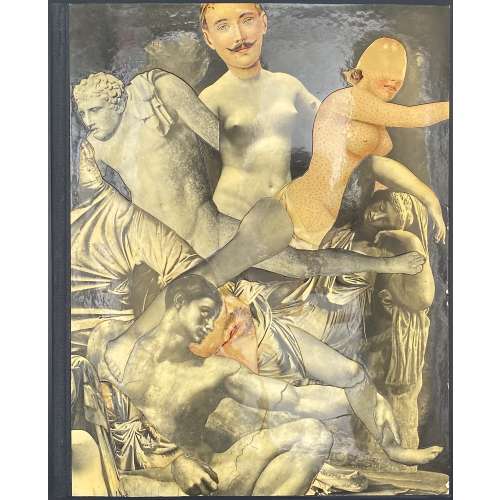 Hardcover volume, 25.2 x 20.5 cm, in a double slipcase 26.3 x 21.5 cm; black boards on cloth spine, front board with pasted photocollage in colour, first leaf thick verge paper different to the rest of the edition; top margin red, text printed on cream laid paper without a watermark and adorned with 14 in-text lithographs in black. A suite of 20 coloured lithographs 245 x 195 mm in the inner slipcase. Plates by Berthomme Saint-André. Pagination: [2] blanks, [3-8] 9-100 [101] blank, [2] colophon, limit. [2] blanks. Title-page (red and black): A. DE M. | GAMIANI | ou | deux nuits d'excès | Édition Réalisée | par les soins | et au profit exclusif des | « Vrais Amateurs Romantiques » | (Groupement de bibliophiles) || Limitation: № 1 – on Tonkin à la forme paper with two sets of plates, on Tonkin and one on Arches, printed in colour and in black, etc.; № 2 – similar but with the earlier state of one suite of plates; №№ 3-52 on Arches verge with plates on Tonkin; №№ 53-127 on Arches verge with plates on the same; №№ 128-227 on Rives with the suites on paper watermarked “Japon”; №№ 228-672 on Rives with the suites on the same; 25 copies marked A-Z of which A-J on Arches vergé and suites on Tonkin, and K-Z on Rives. Altogether 697 copies, of which this is copy № 27. Catalogue raisonné: Dutel III № 1650, p. 187-8; honesterotica.com. with a partially different set of in-text illustrations. Alfred de Musset (French, 1810 – 1857) – author. Louis Berthomme Saint-André (French, 1905 – 1977) – artist.
Hardcover volume, 25.2 x 20.5 cm, in a double slipcase 26.3 x 21.5 cm; black boards on cloth spine, front board with pasted photocollage in colour, first leaf thick verge paper different to the rest of the edition; top margin red, text printed on cream laid paper without a watermark and adorned with 14 in-text lithographs in black. A suite of 20 coloured lithographs 245 x 195 mm in the inner slipcase. Plates by Berthomme Saint-André. Pagination: [2] blanks, [3-8] 9-100 [101] blank, [2] colophon, limit. [2] blanks. Title-page (red and black): A. DE M. | GAMIANI | ou | deux nuits d'excès | Édition Réalisée | par les soins | et au profit exclusif des | « Vrais Amateurs Romantiques » | (Groupement de bibliophiles) || Limitation: № 1 – on Tonkin à la forme paper with two sets of plates, on Tonkin and one on Arches, printed in colour and in black, etc.; № 2 – similar but with the earlier state of one suite of plates; №№ 3-52 on Arches verge with plates on Tonkin; №№ 53-127 on Arches verge with plates on the same; №№ 128-227 on Rives with the suites on paper watermarked “Japon”; №№ 228-672 on Rives with the suites on the same; 25 copies marked A-Z of which A-J on Arches vergé and suites on Tonkin, and K-Z on Rives. Altogether 697 copies, of which this is copy № 27. Catalogue raisonné: Dutel III № 1650, p. 187-8; honesterotica.com. with a partially different set of in-text illustrations. Alfred de Musset (French, 1810 – 1857) – author. Louis Berthomme Saint-André (French, 1905 – 1977) – artist. -
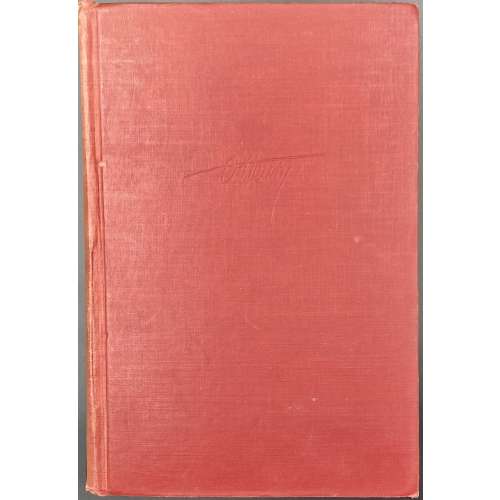 Hardcover volume, 21.5 x 14.7 x 5.7 cm, bound in red cloth with blind-stamped ms signature to front board and gilt lettering over black labels, and gild design elements to spine; pp.: [i-iv] (h.t./blank, t.p./copyright) v-xv[xvi] blank, [1-2] f.t./blank, 3-1653 [1654] blank, [2] publ. note/blank; 1672 pp total; Blue ink ms inscription to h.t. 'Lawrence Wyman'. Title-page (in a two-rule frame): THE COMPLETE WORKS OF | O. Henry | Foreword by | WILLIAM LYON PHELPS | AUTHENTIC EDITION | {publisher’s device, G.C.P.} | De Luxe Edition | — | Garden City Publishing Co., Inc. | GARDEN CITY NEW YORK || Contributors: O. Henry [William Sydney Porter] (American, 1862 – 1910) – author. William Lyon Phelps (American, 1865 – 1943) – author/foreword.
Hardcover volume, 21.5 x 14.7 x 5.7 cm, bound in red cloth with blind-stamped ms signature to front board and gilt lettering over black labels, and gild design elements to spine; pp.: [i-iv] (h.t./blank, t.p./copyright) v-xv[xvi] blank, [1-2] f.t./blank, 3-1653 [1654] blank, [2] publ. note/blank; 1672 pp total; Blue ink ms inscription to h.t. 'Lawrence Wyman'. Title-page (in a two-rule frame): THE COMPLETE WORKS OF | O. Henry | Foreword by | WILLIAM LYON PHELPS | AUTHENTIC EDITION | {publisher’s device, G.C.P.} | De Luxe Edition | — | Garden City Publishing Co., Inc. | GARDEN CITY NEW YORK || Contributors: O. Henry [William Sydney Porter] (American, 1862 – 1910) – author. William Lyon Phelps (American, 1865 – 1943) – author/foreword. -
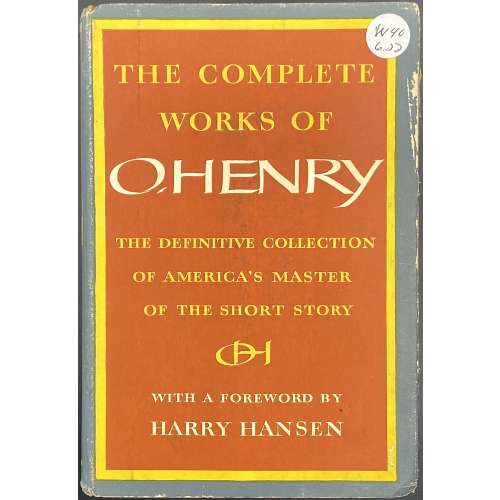 Two hardcover volumes, 22 x 15 cm each, uniformly bound in quarter orange cloth over blue cloth, red and blue lettering to spine, in a dust jacket lettered in yellow and white over red THE COMPLETE | WORKS OF | O. HENRY | THE DEFINITIVE COLLECTION | OF AMERICA’S MASTER | OF THE SHORT STORY | { OH monogram} | WITH A FOREWORD BY | HARRY HANSEN || Title-page: THE COMPLETE WORKS OF O. HENRY | FOREWORD BY HARRY HANSEN | VOLUME I (II) | 1953 | DOUBLEDAY & COMPANY, INC. GARDEN CITY, NY || Vol. 1: ffl, [i-v] vi-xiii [xiv] [2] [1] 2-810, ffl. Vol. 2: ffl, [i-v] vi-viii [2] [811] 812-1692, ffl. Contributors: O. Henry [William Sydney Porter] (American, 1862 – 1910) – author. Harry Hansen (American, 1884 – 1977) – author/foreword.
Two hardcover volumes, 22 x 15 cm each, uniformly bound in quarter orange cloth over blue cloth, red and blue lettering to spine, in a dust jacket lettered in yellow and white over red THE COMPLETE | WORKS OF | O. HENRY | THE DEFINITIVE COLLECTION | OF AMERICA’S MASTER | OF THE SHORT STORY | { OH monogram} | WITH A FOREWORD BY | HARRY HANSEN || Title-page: THE COMPLETE WORKS OF O. HENRY | FOREWORD BY HARRY HANSEN | VOLUME I (II) | 1953 | DOUBLEDAY & COMPANY, INC. GARDEN CITY, NY || Vol. 1: ffl, [i-v] vi-xiii [xiv] [2] [1] 2-810, ffl. Vol. 2: ffl, [i-v] vi-viii [2] [811] 812-1692, ffl. Contributors: O. Henry [William Sydney Porter] (American, 1862 – 1910) – author. Harry Hansen (American, 1884 – 1977) – author/foreword. -
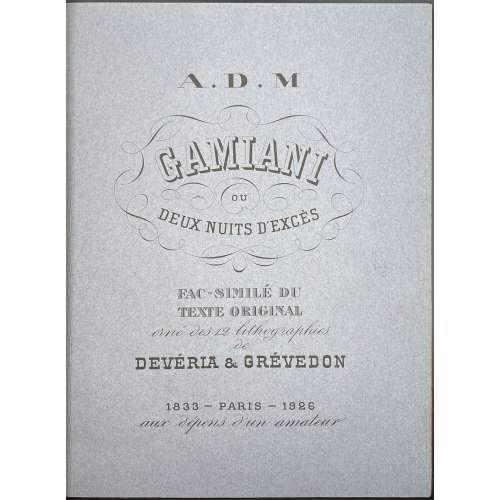 Description: ¾ contemporary red morocco over marbled boards, 33.1 x 25.8 cm, raised bands, gilt lettering to spine, in a marbled slipcase 34.2 x 25.9 cm. Printed on thick wove paper watermarked “MONTGOLFIER ANNONAY” by Canson & Montgolfier (Annonay, France). Front wrapper and title-page : A. D. M. | GAMIANI | OU | DEUX NUITS D’EXCÉS | FAC-SIMILE DU | TEXTE ORIGINAL | orné des 12 lithographies | de | DEVÉRIA & GRÉVEDON | 1833 – Paris – 1926 | aux dépens d'un amateur || Faux-t.p. (1): GAMIANI | OU | UNE NUIT D’EXCÉS | {vignette} | Bruxelles | 1833 || (fac-semilé of the original wrapper of 1833) Faux-t.p. (2): GAMIANI | OU | DEUX NUITS D’EXCÉS | {vignette} | Bruxelles | 1833 || (fac-semilé of the original wrapper of 1833) Collation: 2 blanks, 1 orig. lavender blue colour front wrapper, 1 blank, 1 h.t., 1 limitation p., 1 t.p., 3 leaves ‘Notice Bibliographique’, 32 leaves of printed text, 2 blanks, 1 brown faux t.p. (1), text in fac-semilé manuscript (7 leaves) with 8 coloured plates, 1 blank, 1 brown faux t.p. (2), 7 leaves of text with 4 plates, 2 blanks, brown back wrapper, lavender blue back wrapper, 2 blanks; total 64 leaves plus 16 plates. Pagination: [1-8] 9-75 [76] [4]; [1] 2-26; mispaginated p. 23 marked 25, f.t.p. and ffl not counted. Last four plates without letters. Limitation: a print run of 360 copies, of which 20 with ‘miniatures’ №№ 1-20, 100 with coloured plates №№ 21-120, 230 with b/w plates №№ 121-350; 10 copies not for sale, marked H. C. (hors commerce). This is copy № 201, which should be with black lithographs, but has coloured plates. According to J.-P. Dutel, the plates were printed from the original stones. For variations on Devéria & Grévedon designs for Gamiani see also: LIB-3087.2022 (Bruxelles, 1864); LIB-3093.2022 (Bruxelles, 1866); LIB-3090.2022 (Bruxelles, 1871); LIB-2902.2021 (Greman, 1911); LIB-2903.2021 (late 1940s). Catalogue raisonné: Dutel III 1640, p. 185. Contributors : Alfred de Musset (French, 1810 – 1857) – author. André Warnod [André de Sermanmagny] (French, 1885 – 1960) – author (bibliographical note) Pierre Louis Henri Grévedon (French, 1776 – 1860) – artist. Achille Devéria (French, 1800 – 1857) – artist.
Description: ¾ contemporary red morocco over marbled boards, 33.1 x 25.8 cm, raised bands, gilt lettering to spine, in a marbled slipcase 34.2 x 25.9 cm. Printed on thick wove paper watermarked “MONTGOLFIER ANNONAY” by Canson & Montgolfier (Annonay, France). Front wrapper and title-page : A. D. M. | GAMIANI | OU | DEUX NUITS D’EXCÉS | FAC-SIMILE DU | TEXTE ORIGINAL | orné des 12 lithographies | de | DEVÉRIA & GRÉVEDON | 1833 – Paris – 1926 | aux dépens d'un amateur || Faux-t.p. (1): GAMIANI | OU | UNE NUIT D’EXCÉS | {vignette} | Bruxelles | 1833 || (fac-semilé of the original wrapper of 1833) Faux-t.p. (2): GAMIANI | OU | DEUX NUITS D’EXCÉS | {vignette} | Bruxelles | 1833 || (fac-semilé of the original wrapper of 1833) Collation: 2 blanks, 1 orig. lavender blue colour front wrapper, 1 blank, 1 h.t., 1 limitation p., 1 t.p., 3 leaves ‘Notice Bibliographique’, 32 leaves of printed text, 2 blanks, 1 brown faux t.p. (1), text in fac-semilé manuscript (7 leaves) with 8 coloured plates, 1 blank, 1 brown faux t.p. (2), 7 leaves of text with 4 plates, 2 blanks, brown back wrapper, lavender blue back wrapper, 2 blanks; total 64 leaves plus 16 plates. Pagination: [1-8] 9-75 [76] [4]; [1] 2-26; mispaginated p. 23 marked 25, f.t.p. and ffl not counted. Last four plates without letters. Limitation: a print run of 360 copies, of which 20 with ‘miniatures’ №№ 1-20, 100 with coloured plates №№ 21-120, 230 with b/w plates №№ 121-350; 10 copies not for sale, marked H. C. (hors commerce). This is copy № 201, which should be with black lithographs, but has coloured plates. According to J.-P. Dutel, the plates were printed from the original stones. For variations on Devéria & Grévedon designs for Gamiani see also: LIB-3087.2022 (Bruxelles, 1864); LIB-3093.2022 (Bruxelles, 1866); LIB-3090.2022 (Bruxelles, 1871); LIB-2902.2021 (Greman, 1911); LIB-2903.2021 (late 1940s). Catalogue raisonné: Dutel III 1640, p. 185. Contributors : Alfred de Musset (French, 1810 – 1857) – author. André Warnod [André de Sermanmagny] (French, 1885 – 1960) – author (bibliographical note) Pierre Louis Henri Grévedon (French, 1776 – 1860) – artist. Achille Devéria (French, 1800 – 1857) – artist. -
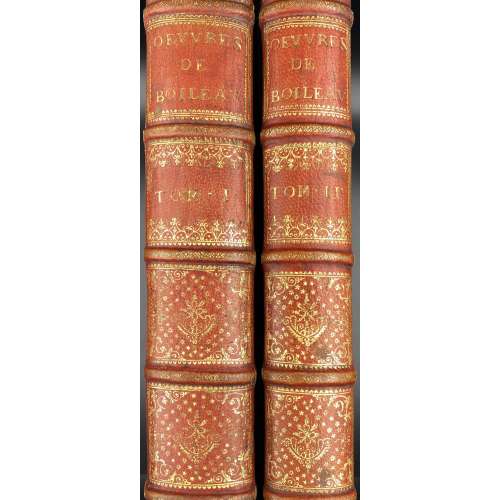 Description: two volumes, 38.3 x 25.5 cm each, uniformly bound in red morocco, boards decorated in gilt in the style of Luc-Antoine Boyet, with gilt dentelle inside out; spine with raised bands, gilt lettering, gilt in compartments; all edges gilt; marbled endpapers; printed on laid paper, text in the floral frame, engraved frontispiece (after Hyacinthe Rigaud), plates, t.p. vignette with the portrait of Desiderius Erasmus (after Quentin Metsys), head- and tailpieces (total of 40, some repeating) and 2 initials by Bernard Picart, folded portrait of dedicatee Guillelmine Charlotte Princesse de Galles &c &c &c by van Gunst after Kneller. Title-page (red and black, tall ‘s’): OEUVRES | DE | NICOLAS BOILEAU | DESPRÉAUX. | AVEC DES | ÉCLAIRCISSEMENTS | HISTORIQUES, | DONNEZ PAR LUI-MEME. | Nouvelle Edition revuë, corrigée & augmentée de diverses Remarques. | Enrichie de figures gravées par Bernard Picart le Romain. | TOME PREMIER (SECOND). | {vignette} | A AMSTERDAM, | Chez DAVID MORTIER. | — | M DCCXVIII. | AVEC PRIVILEGE. || Vol. 1. Collation: 4to; 1 ffl, a-c4 d1 A-3K4, 3L2, 1ffl; (K3 marked I3). Plates: t.p. vignette, frontispiece, 24 head- and tailpieces, f.t. in a grotesque frame and 6 full-page for ‘Le Lutrin’ in the same frame by Bernard Picart; folded portrait of Guillelmine Charlotte, Princess of Wales by van Gunst after Kneller. Pagination: [4] [i-v] vi-xviii [4] [1] 2-450 [2]. Vol. 2. Collation: 4to; 2 ffl, π2 A-3C4 3D3 2 ffl; (V3 marked T3, 2L4 marked A). Plates: t.p. vignette (same as vol.1) and 7 head- and tailpieces by Bernard Picart. Pagination: [4] [i-iii] iv-vii [viii] [1] 2-370 [2] [20]. Catalogue raisonné: Lewine 72-3; Cohen-De Ricci 165-6. Contributors: Luc-Antoine Boyet (French, fl. 1684 – 1733) – bookbinder. Claude Brossette (French, 1671 – 1743) – author, remarks. André Dacier (French, 1651 – 1722) – author, preface. Nicolas Boileau Despréaux (French, 1636 – 1711) – author. Pieter Stevens van Gunst (Dutch, 1659-1724) – engraver. Sir Godfrey Kneller (British, 1646-1723) – artist. David Mortier (Dutch-British, 1673 – 1728) – publisher. Bernard Picard (French, 1673 – 1733) – artist, engraver. Quentin Massijs [Metsys, Matsys] (Flemish, 1466 – 1530) – artist. Hyacinthe Rigaud [Jacint Rigau-Ros i Serra] (French, 1659 - 1743) – artist. Guillelmine Charlotte, Princess of Wales (Wilhelmina Charlotte Caroline of Brandenburg-Ansbach) (1683 – 1737) – dedicatee
Description: two volumes, 38.3 x 25.5 cm each, uniformly bound in red morocco, boards decorated in gilt in the style of Luc-Antoine Boyet, with gilt dentelle inside out; spine with raised bands, gilt lettering, gilt in compartments; all edges gilt; marbled endpapers; printed on laid paper, text in the floral frame, engraved frontispiece (after Hyacinthe Rigaud), plates, t.p. vignette with the portrait of Desiderius Erasmus (after Quentin Metsys), head- and tailpieces (total of 40, some repeating) and 2 initials by Bernard Picart, folded portrait of dedicatee Guillelmine Charlotte Princesse de Galles &c &c &c by van Gunst after Kneller. Title-page (red and black, tall ‘s’): OEUVRES | DE | NICOLAS BOILEAU | DESPRÉAUX. | AVEC DES | ÉCLAIRCISSEMENTS | HISTORIQUES, | DONNEZ PAR LUI-MEME. | Nouvelle Edition revuë, corrigée & augmentée de diverses Remarques. | Enrichie de figures gravées par Bernard Picart le Romain. | TOME PREMIER (SECOND). | {vignette} | A AMSTERDAM, | Chez DAVID MORTIER. | — | M DCCXVIII. | AVEC PRIVILEGE. || Vol. 1. Collation: 4to; 1 ffl, a-c4 d1 A-3K4, 3L2, 1ffl; (K3 marked I3). Plates: t.p. vignette, frontispiece, 24 head- and tailpieces, f.t. in a grotesque frame and 6 full-page for ‘Le Lutrin’ in the same frame by Bernard Picart; folded portrait of Guillelmine Charlotte, Princess of Wales by van Gunst after Kneller. Pagination: [4] [i-v] vi-xviii [4] [1] 2-450 [2]. Vol. 2. Collation: 4to; 2 ffl, π2 A-3C4 3D3 2 ffl; (V3 marked T3, 2L4 marked A). Plates: t.p. vignette (same as vol.1) and 7 head- and tailpieces by Bernard Picart. Pagination: [4] [i-iii] iv-vii [viii] [1] 2-370 [2] [20]. Catalogue raisonné: Lewine 72-3; Cohen-De Ricci 165-6. Contributors: Luc-Antoine Boyet (French, fl. 1684 – 1733) – bookbinder. Claude Brossette (French, 1671 – 1743) – author, remarks. André Dacier (French, 1651 – 1722) – author, preface. Nicolas Boileau Despréaux (French, 1636 – 1711) – author. Pieter Stevens van Gunst (Dutch, 1659-1724) – engraver. Sir Godfrey Kneller (British, 1646-1723) – artist. David Mortier (Dutch-British, 1673 – 1728) – publisher. Bernard Picard (French, 1673 – 1733) – artist, engraver. Quentin Massijs [Metsys, Matsys] (Flemish, 1466 – 1530) – artist. Hyacinthe Rigaud [Jacint Rigau-Ros i Serra] (French, 1659 - 1743) – artist. Guillelmine Charlotte, Princess of Wales (Wilhelmina Charlotte Caroline of Brandenburg-Ansbach) (1683 – 1737) – dedicatee -
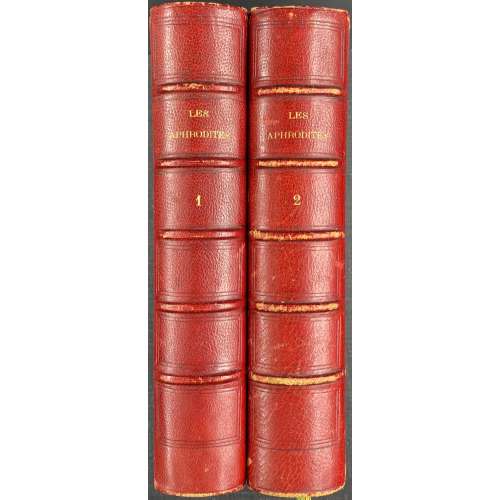 Two volumes in-12, 16.7 x 11.5 x 3.5 cm each, uniformly bound in quarter crimson morocco over marbled boards, spine with raised bands, gilt lettering, marbled endpapers, top margin gilt; text printed on laid paper, plates – on India paper: loose frontispiece by Félix Lukkow after Félicien Rops with tissue guard and 4 loose engraved plates by Félix Lukkow after Sigmund Freudenberger, in each volume. This edition is a reprint of an earlier publication: ANDRÉA DE NERCIAT, André-Robert (1739 - 1800). Les Aphrodites ou Fragments thali-priapiques pour servir à l'histoire du plaisir. Numéro Un et deux [Numéro trois et quatre [...] sept et huit]. 1793-1864. [Bruxelles : Briard pour Poulet-Malassis, 1864] with plated recarved by Félix Lukkow. Title-page: LES | APHRODITES | OU | FRAGMENTS THALI-PRIAPIQUES | POUR SERVIR A | L’HISTOIRE DU PLAISIR | — | Priape, soutiens mon hàleine… | Piron, Ode | — | Tome premier (second). | {publisher’s device} | A LAMPSAQUE | – | 1793 || Limitation: Edition is limited to 150 copies of which 130 on papier vergé, 5 on papier album jaune, 10 copies in-8o on large papier fort de Hollande, and one unique copy on peau de vélin. The number of this copy is left blank in both volumes. Vol. 1: π4 (h.t./limit., t.p./table, Éclaircissements historiques par V. M. D.), 1-2712 2910; total 182 leaves plus 5 leaves of plates, incl. frontispiece. Pagination: [1-5] 6-364, ils. V. M. D. stands for Vital Désiré Maximilien [Puissant]. Vol. 2: π2 (h.t., t.p.), 1-2912, 3110; total 192 leaves plus 5 leaves of plates, incl. frontispiece. Pagination: [1-5] 6-384, ils. Catalogue raisonné: Dutel I: A-95. Catalogue Poulet-Malassis & ses amis description: № 67. André-Robert ANDRÉA DE NERCIAT - [Félix LUKKOW]. Les Aphrodites, ou fragments thali-priapiques pour servir à l’histoire du plaisir. Tome premier (— second). A Lampsaque, 1793 [Vital Puissant, vers 1872]. 2 volumes in-12 de 364 et 384 pages, demi-maroquin rouge, dos à nerfs, tête dorée, non rogné (reliure de l’époque). Illustré de 2 frontispices et 8 planches volantes, par Félix Lukkow, d’après Félicien Rops pour les frontispices et Freundeberg pour les figures. Tirage limité à 151 ex. Contributors: André-Robert Andréa de Nerciat (French, 1739 – 1800) – author. Sigmund Freudenberger (Swiss, 1745 – 1801) – artist. Félicien Rops (Belgian, 1833 – 1898) – artist. Félix Lukkow (French, fl. c. 1870 – 1875) – engraver.
Two volumes in-12, 16.7 x 11.5 x 3.5 cm each, uniformly bound in quarter crimson morocco over marbled boards, spine with raised bands, gilt lettering, marbled endpapers, top margin gilt; text printed on laid paper, plates – on India paper: loose frontispiece by Félix Lukkow after Félicien Rops with tissue guard and 4 loose engraved plates by Félix Lukkow after Sigmund Freudenberger, in each volume. This edition is a reprint of an earlier publication: ANDRÉA DE NERCIAT, André-Robert (1739 - 1800). Les Aphrodites ou Fragments thali-priapiques pour servir à l'histoire du plaisir. Numéro Un et deux [Numéro trois et quatre [...] sept et huit]. 1793-1864. [Bruxelles : Briard pour Poulet-Malassis, 1864] with plated recarved by Félix Lukkow. Title-page: LES | APHRODITES | OU | FRAGMENTS THALI-PRIAPIQUES | POUR SERVIR A | L’HISTOIRE DU PLAISIR | — | Priape, soutiens mon hàleine… | Piron, Ode | — | Tome premier (second). | {publisher’s device} | A LAMPSAQUE | – | 1793 || Limitation: Edition is limited to 150 copies of which 130 on papier vergé, 5 on papier album jaune, 10 copies in-8o on large papier fort de Hollande, and one unique copy on peau de vélin. The number of this copy is left blank in both volumes. Vol. 1: π4 (h.t./limit., t.p./table, Éclaircissements historiques par V. M. D.), 1-2712 2910; total 182 leaves plus 5 leaves of plates, incl. frontispiece. Pagination: [1-5] 6-364, ils. V. M. D. stands for Vital Désiré Maximilien [Puissant]. Vol. 2: π2 (h.t., t.p.), 1-2912, 3110; total 192 leaves plus 5 leaves of plates, incl. frontispiece. Pagination: [1-5] 6-384, ils. Catalogue raisonné: Dutel I: A-95. Catalogue Poulet-Malassis & ses amis description: № 67. André-Robert ANDRÉA DE NERCIAT - [Félix LUKKOW]. Les Aphrodites, ou fragments thali-priapiques pour servir à l’histoire du plaisir. Tome premier (— second). A Lampsaque, 1793 [Vital Puissant, vers 1872]. 2 volumes in-12 de 364 et 384 pages, demi-maroquin rouge, dos à nerfs, tête dorée, non rogné (reliure de l’époque). Illustré de 2 frontispices et 8 planches volantes, par Félix Lukkow, d’après Félicien Rops pour les frontispices et Freundeberg pour les figures. Tirage limité à 151 ex. Contributors: André-Robert Andréa de Nerciat (French, 1739 – 1800) – author. Sigmund Freudenberger (Swiss, 1745 – 1801) – artist. Félicien Rops (Belgian, 1833 – 1898) – artist. Félix Lukkow (French, fl. c. 1870 – 1875) – engraver. -
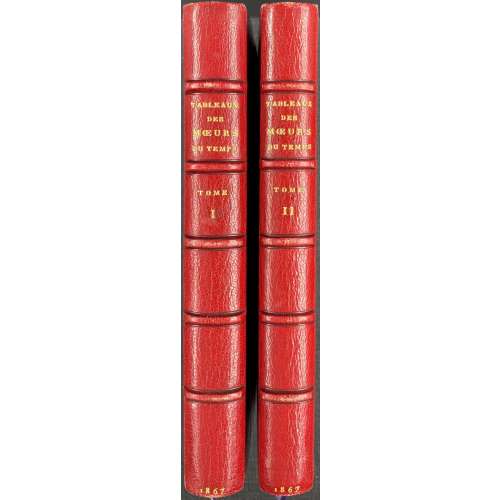 Two volumes in-12, 16.8 x 11.5 cm each, uniformly bound in ¾ red crushed morocco over marbled boards, spine with raised bands and gilt lettering, marbled endpapers, text printed on laid paper, 6 plates (3 in each vol.) on India paper pasted in on thick laid paper leaves. This edition seems similar to Nordmann I 203 but without Félicien Rops' frontispiece and plates, replaced by unsigned etchings attributed to Gustave Staal. Title-page (red and black): LE RICHE DE LA POPELINIÈRE | – | TABLEAUX | DES | MŒURS DU TEMPS | DANS LES DIFFÉRENTS AGES DE LA VIE | – | NOTICE DE | CHARLES MONSELET | – | TOME PREMIER (SECOND) | {fleuron} | PARIS | IMPRIMERIE DES CI-DEVANT FERMIERS GÉNÉRAUX | – | M D CCC L XVII || Vol. 1: π2 (h.t., t.p.) a4 (Notice), 1-1312 151 (Table); total 91 leaves plus three leaves of plates. Pagination: [4] [i] ii-vii [viii] [3] 4-168 [2]; total 182 pp, ils. facing pp. 59, 78, and 94. Vol. 2: π2 (h.t., t.p.), 1-1312, 152; total 88 leaves plus three leaves of plates. Pagination: [4] [1] 2-170 [2]; total 176 pp, ils. facing pp. 74, 78, and 145. Catalogue raisonné: Dutel I: A-1044 — without Félicien Rops ‘ornementations’, but with ‘6 gravures de 1865’. Dutel suggests that the edition was performed by A. Poulet-Malassis, Briard or Lécrivain. Catalogue Poulet-Malassis & ses amis description: № 43. LE RICHE DE LA POPELINIÈRE. Tableaux des mœurs du temps dans les diérents âges de la vie, tome premier (— second). Notice de M. Charles Monselet. Imprimerie des ci-devant fermiers généraux, Paris, M D CCC LXVII [A. Poulet-Malassis, 1867]. Exemplaire sans le frontispice de Félicien Rops mais bien complet des 6 figures de Staal, justification qui illustre les aléas de la confection des publications clandestines. D’une part, c’est une autre édition qui est décrite par Launay. L’exemplaire vendu chez Maître Loudmer avait 6 figures, comme ici. Cluzel a vu un “front. et 4 vignettes de Rops plus cinq figures libres (par Staal)”, Simonson a vu 5 figures de Rops, etc., etc. Il y a 3 bandeaux et 3 culs-de-lampe de Rops qui ont été fréquemment utilisés par d’autres éditeurs pour d’autres titres pendant toute la seconde moitié du xixe siècle. La Léonina présente une fiche détaillée sur 4 pages. 3 bandeaux et 3 culs-de-lampe gravés sur bois de Rops. Bibliographie : Pia 1389, Launay 327, Gay 6-308, Pey 122 (1800 frs avec 5 figures), PC 503 et 504, Lemonnyer 3-1173, LL 66, Leonina 81, Nordmann 1-203, Dutel A-1043. Contributors: Alexandre Jean Joseph Le Riche de La Popelinière (French, 1693 – 1762) – author. Charles Monselet (French, 1825 – 1888) – author (foreword). Pierre-Gustave-Eugène Staal (French, 1817 – 1882) – artist. Auguste Poulet-Malassis (French, 1825 – 1878) – publisher.
Two volumes in-12, 16.8 x 11.5 cm each, uniformly bound in ¾ red crushed morocco over marbled boards, spine with raised bands and gilt lettering, marbled endpapers, text printed on laid paper, 6 plates (3 in each vol.) on India paper pasted in on thick laid paper leaves. This edition seems similar to Nordmann I 203 but without Félicien Rops' frontispiece and plates, replaced by unsigned etchings attributed to Gustave Staal. Title-page (red and black): LE RICHE DE LA POPELINIÈRE | – | TABLEAUX | DES | MŒURS DU TEMPS | DANS LES DIFFÉRENTS AGES DE LA VIE | – | NOTICE DE | CHARLES MONSELET | – | TOME PREMIER (SECOND) | {fleuron} | PARIS | IMPRIMERIE DES CI-DEVANT FERMIERS GÉNÉRAUX | – | M D CCC L XVII || Vol. 1: π2 (h.t., t.p.) a4 (Notice), 1-1312 151 (Table); total 91 leaves plus three leaves of plates. Pagination: [4] [i] ii-vii [viii] [3] 4-168 [2]; total 182 pp, ils. facing pp. 59, 78, and 94. Vol. 2: π2 (h.t., t.p.), 1-1312, 152; total 88 leaves plus three leaves of plates. Pagination: [4] [1] 2-170 [2]; total 176 pp, ils. facing pp. 74, 78, and 145. Catalogue raisonné: Dutel I: A-1044 — without Félicien Rops ‘ornementations’, but with ‘6 gravures de 1865’. Dutel suggests that the edition was performed by A. Poulet-Malassis, Briard or Lécrivain. Catalogue Poulet-Malassis & ses amis description: № 43. LE RICHE DE LA POPELINIÈRE. Tableaux des mœurs du temps dans les diérents âges de la vie, tome premier (— second). Notice de M. Charles Monselet. Imprimerie des ci-devant fermiers généraux, Paris, M D CCC LXVII [A. Poulet-Malassis, 1867]. Exemplaire sans le frontispice de Félicien Rops mais bien complet des 6 figures de Staal, justification qui illustre les aléas de la confection des publications clandestines. D’une part, c’est une autre édition qui est décrite par Launay. L’exemplaire vendu chez Maître Loudmer avait 6 figures, comme ici. Cluzel a vu un “front. et 4 vignettes de Rops plus cinq figures libres (par Staal)”, Simonson a vu 5 figures de Rops, etc., etc. Il y a 3 bandeaux et 3 culs-de-lampe de Rops qui ont été fréquemment utilisés par d’autres éditeurs pour d’autres titres pendant toute la seconde moitié du xixe siècle. La Léonina présente une fiche détaillée sur 4 pages. 3 bandeaux et 3 culs-de-lampe gravés sur bois de Rops. Bibliographie : Pia 1389, Launay 327, Gay 6-308, Pey 122 (1800 frs avec 5 figures), PC 503 et 504, Lemonnyer 3-1173, LL 66, Leonina 81, Nordmann 1-203, Dutel A-1043. Contributors: Alexandre Jean Joseph Le Riche de La Popelinière (French, 1693 – 1762) – author. Charles Monselet (French, 1825 – 1888) – author (foreword). Pierre-Gustave-Eugène Staal (French, 1817 – 1882) – artist. Auguste Poulet-Malassis (French, 1825 – 1878) – publisher. -
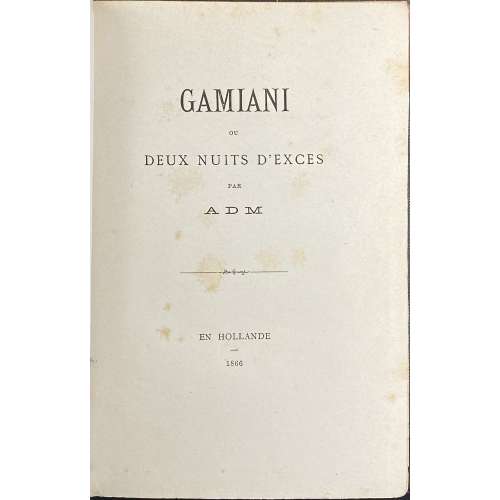 Single volume, 18 x 12.5 cm, bound in ¾ crimson morocco over marbled boards, gilt double-fillet borders, spine with gilded raised bands, gilt in compartments, gilt-lettered label, marbled endpapers, top margin gilt, text printed on dense wove paper, with 8 etchings by anonymous on thin laid paper (Chine) with tissue guards, after original lithographs by Devéria and Henri Grévedon or Octave Tassaert for the 1833 edition (1926 re-print LIB-3135.2023); the plate with the ape after 1864 edition (LIB-3087.2022) and the plate with the donkey after unknown. Title-page: GAMIANI | OU | DEUX NUITS D’EXCES | PAR | A D M | — | EN HOLLANDE | – | 1866 || Pagination: [4] (h.t., t.p.), [i] ii-xvi, [3] 4-153 [154 blank]; total 158 pages plus 8 plates (anonymous etchings), incl. frontispiece. Catalogue raisonné: Dutel I: A-470; Pia: 518/9. BNF Enfer 418. Note: This edition is conformant with Dutel, but not with Pia, who mentions [2], xvi, 148 pp. Pia writes: 'According to a bibliographic record published in 1874 by Vital Puissant, this edition was printed in Brussels by Briard on behalf of Alphonse Lécrivain, a Parisian publisher who took refuge in Belgium'. Catalogue Poulet-Malassis & ses amis description: № 74. [Alfred de MUSSET] A D M. Gamiani ou deux nuits d’excès. En Hollande, 1866. In-8 de xvi, 153 pages, demi-maroquin cerise à coins, dos à nerfs orné, lets dorés sur les mors, tête dorée, tranches naturelles, couverture conservée (reliure ancienne). Illustré de 8 gravures sur Chine dont l’une en frontispice, toutes accompagnées de serpentines. Piqûres et mouillures. Dutel A-470, pas à l’Enfer de la BnF.
Single volume, 18 x 12.5 cm, bound in ¾ crimson morocco over marbled boards, gilt double-fillet borders, spine with gilded raised bands, gilt in compartments, gilt-lettered label, marbled endpapers, top margin gilt, text printed on dense wove paper, with 8 etchings by anonymous on thin laid paper (Chine) with tissue guards, after original lithographs by Devéria and Henri Grévedon or Octave Tassaert for the 1833 edition (1926 re-print LIB-3135.2023); the plate with the ape after 1864 edition (LIB-3087.2022) and the plate with the donkey after unknown. Title-page: GAMIANI | OU | DEUX NUITS D’EXCES | PAR | A D M | — | EN HOLLANDE | – | 1866 || Pagination: [4] (h.t., t.p.), [i] ii-xvi, [3] 4-153 [154 blank]; total 158 pages plus 8 plates (anonymous etchings), incl. frontispiece. Catalogue raisonné: Dutel I: A-470; Pia: 518/9. BNF Enfer 418. Note: This edition is conformant with Dutel, but not with Pia, who mentions [2], xvi, 148 pp. Pia writes: 'According to a bibliographic record published in 1874 by Vital Puissant, this edition was printed in Brussels by Briard on behalf of Alphonse Lécrivain, a Parisian publisher who took refuge in Belgium'. Catalogue Poulet-Malassis & ses amis description: № 74. [Alfred de MUSSET] A D M. Gamiani ou deux nuits d’excès. En Hollande, 1866. In-8 de xvi, 153 pages, demi-maroquin cerise à coins, dos à nerfs orné, lets dorés sur les mors, tête dorée, tranches naturelles, couverture conservée (reliure ancienne). Illustré de 8 gravures sur Chine dont l’une en frontispice, toutes accompagnées de serpentines. Piqûres et mouillures. Dutel A-470, pas à l’Enfer de la BnF. -
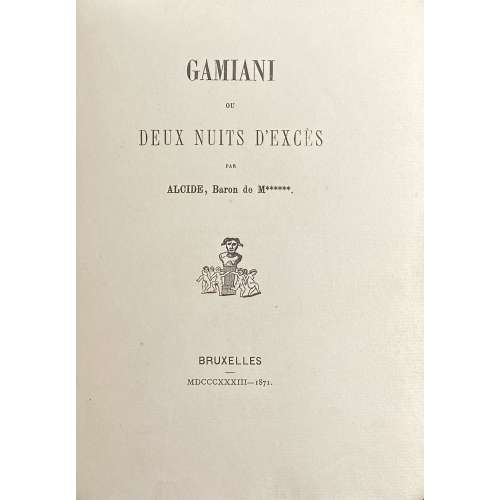 Single volume, 19.2 x 14.2 cm, bound in ¾ dark blue morocco over peacock marbled boards, gilt double-fillet border, spine with gilded raised bands, gilt fleurons and lettering, marbled endpapers, top margin gilt, outer margin uncut; text printed on watermarked laid paper; frontispiece by Félicien Rops, plates by Félix Lukkow after original lithographs by Devéria and Henri Grévedon or Octave Tassaert for the 1833 edition (1926 re-print LIB-3135.2023); the plate with the ape may be considered 'after edition of 1864' (LIB-3087.2022). Collation: π2 (h.t., t.p.) [a]8 1-712 96, total 64 leaves plus etched frontispiece in sanguine after page 8 and 12 engraved plates on India paper; illustrations include six burin engravings printed in two versions each, black and red, all six by Félix Lukkow after Devéria and Grévedon. Pagination: [4] [i] ii-viii, [1] 2-116, total 128 pages, ils. Title-page: GAMIANI | OU | DEUX NUITS D’EXCES | PAR | ALCIDE, Baron de M******. | {publisher's device} | — | BRUXELLES | MDCCCXXXIII—1871. || Limitation: Print run of 150 copies of which one unique on peau de vélin, 130 on laid paper (papier vergé), 5 on papier album jaune, 4 on papier de Chine, 10 on papier fort de Hollande. This is copy № 3, on Van Gelder laid paper, watermarked (possibly this is what they call ‘papier fort de Hollande’). Catalogue raisonné: Dutel I: A-472; Pia 520. Ref.: BNF Enfer 66. Contributors: Alfred de Musset (French, 1810 – 1857) – author. Félicien Rops (Belgian, 1833 – 1898) – artist. Félix Lukkow (French, fl. c. 1870 – 1875) – engraver. Vital Puissant (Belgian, 1835 – 1878) – publisher. Catalogue Poulet-Malassis & ses amis description: № 58. [Alfred de MUSSET - Félix LUKKOV] Alcide, baron de M******. Gamiani ou Deux nuits d’excès. Bruxelles, M DCCC XXXIII - 1871 [Vital Puissant]. In-8 de 2 .n.ch, viii, 116 pages, demi-chagrin bleu à coins, dos à nerfs orné, lets dorés et à froid sur les mors, tête dorée, tranches naturelles, non rogné (reliure de l’époque). Illustré de 7 gravures sur Chine, dont une en frontispice, en double état (sauf le frontispice) par Félix Lukkov, d’après les gravures de Félicien Rops. Tirage à 150 ex. L’un des 10 ex. tirés in-8, sur grand papier fort de Hollande (n° 3). Bibliographie : Pia 561, Per 16-14, Enfer 66, Dutel A-472.
Single volume, 19.2 x 14.2 cm, bound in ¾ dark blue morocco over peacock marbled boards, gilt double-fillet border, spine with gilded raised bands, gilt fleurons and lettering, marbled endpapers, top margin gilt, outer margin uncut; text printed on watermarked laid paper; frontispiece by Félicien Rops, plates by Félix Lukkow after original lithographs by Devéria and Henri Grévedon or Octave Tassaert for the 1833 edition (1926 re-print LIB-3135.2023); the plate with the ape may be considered 'after edition of 1864' (LIB-3087.2022). Collation: π2 (h.t., t.p.) [a]8 1-712 96, total 64 leaves plus etched frontispiece in sanguine after page 8 and 12 engraved plates on India paper; illustrations include six burin engravings printed in two versions each, black and red, all six by Félix Lukkow after Devéria and Grévedon. Pagination: [4] [i] ii-viii, [1] 2-116, total 128 pages, ils. Title-page: GAMIANI | OU | DEUX NUITS D’EXCES | PAR | ALCIDE, Baron de M******. | {publisher's device} | — | BRUXELLES | MDCCCXXXIII—1871. || Limitation: Print run of 150 copies of which one unique on peau de vélin, 130 on laid paper (papier vergé), 5 on papier album jaune, 4 on papier de Chine, 10 on papier fort de Hollande. This is copy № 3, on Van Gelder laid paper, watermarked (possibly this is what they call ‘papier fort de Hollande’). Catalogue raisonné: Dutel I: A-472; Pia 520. Ref.: BNF Enfer 66. Contributors: Alfred de Musset (French, 1810 – 1857) – author. Félicien Rops (Belgian, 1833 – 1898) – artist. Félix Lukkow (French, fl. c. 1870 – 1875) – engraver. Vital Puissant (Belgian, 1835 – 1878) – publisher. Catalogue Poulet-Malassis & ses amis description: № 58. [Alfred de MUSSET - Félix LUKKOV] Alcide, baron de M******. Gamiani ou Deux nuits d’excès. Bruxelles, M DCCC XXXIII - 1871 [Vital Puissant]. In-8 de 2 .n.ch, viii, 116 pages, demi-chagrin bleu à coins, dos à nerfs orné, lets dorés et à froid sur les mors, tête dorée, tranches naturelles, non rogné (reliure de l’époque). Illustré de 7 gravures sur Chine, dont une en frontispice, en double état (sauf le frontispice) par Félix Lukkov, d’après les gravures de Félicien Rops. Tirage à 150 ex. L’un des 10 ex. tirés in-8, sur grand papier fort de Hollande (n° 3). Bibliographie : Pia 561, Per 16-14, Enfer 66, Dutel A-472. -
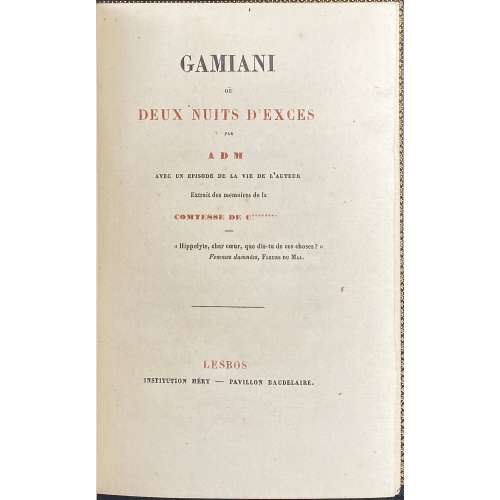 Single volume, 16.8 x 11.3 cm, bound in full dark olive crushed morocco by Brany (signed), gilt triple-fillet border to boards, spine with raised bands, gilt in compartments, gilt-lettered label, gilt dentelle inside, marbled endpapers, all margins gilt, gilt double fillet to boards margin; text printed on laid paper. Bookplate of Maurice Lebarbier de Tinan to fep 45 x 35 mm representing standing satyr with erected penis holding monogram ‘MT’ in his hands with a motto below on a ribbon ‘FAIRE SANS DIRE’. Maurice Lebarbier de Tinan book collection was dispersed via l’hôtel Drouot (Paris) on a sale from March 9 to 12, 1885; a catalogue was published: Catalogue d’un joli choix de livres anciens et modernes, en très belle condition de reliure, composant la bibliothèque de M. L. de T*** [Lebarbier de Tinan] (Paris, Ch. Porquet, 1885, in-8, VIII-140 p., 481 lots). Collation: π2 (h.t., t.p.) a6 b2 1-1112, total 82 leaves plus 18 engraved plates on wove paper; illustrations include engraved frontispiece and six etchings printed in two versions each, black and red, and one etching (at p. 103) in two states, two colour versions for each state, frontispiece and 3 or 4 plates after Félicien Rops, the others after original lithographs by Devéria and Henri Grévedon or Octave Tassaert for the 1833 edition (re-print of 1926 LIB-3135.2023). Pagination: [4] [i] ii-xvi, [3] 4-141 [3], total 164 pages, ils. Title-page (red and black): GAMIANI | OU | DEUX NUITS D’EXCES | PAR | A D M | AVEC UN EPISODE DE LA VIE DE L’AUTEUR | Extrait des mémoires de la | COMTESSE DE C******** | – | « Hippolyte, cher cœur, que dis-tu ces choses ? » | Femmes damnées, Fleurs du Mal. | — | LESBOS | INSTITUTION MERY — PAVILLON BAUDELAIRE. || Catalogue raisonné: Dutel I: A-464; Bory: 596-605; Pia: 516/7. According to Pia, the print run is limited to 150 copies on laid paper. Ref.: BNF Enfer 419. Fekete (Christie's): 135. Provenance: Maurice Lebarbier de Tinan (French, 1842 – 1918). Contributors: Alfred de Musset (French, 1810 – 1857) – author. Félicien Rops (Belgian, 1833 – 1898) – artist. Auguste Poulet-Malassis (French, 1825 – 1878) – publisher. Catalogue Poulet-Malassis & ses amis description: № 5. [Alfred de MUSSET] A D M. Gamiani ou Deux nuits d’excès, avec un épisode de la vie de l’auteur, extrait des mémoires de la comtesse de C********. Lesbos, Institution Méry, Pavillon Baudelaire [A. Poulet-Malassis, 1864]. Illustré de 8 gravures, dont l’une en frontispice, en double état (et quatre états pour la gravure « au singe » de la page 103) de Félicien Rops. Là où Baudelaire soutient Poulet-Malassis quand l’éditeur soutient l’attribution à Musset. Perfectionniste ? Trop cher ? Trop sollicité ? Pas toujours inspiré ? Rops réalisera rarement des suites complètes, ne répondant le plus souvent à la demande de ses commanditaires que par la conception de frontispices. Au verso du faux-titre, Launay voit une justification de 150 exemplaires sur papier vergé, paraphés et numérotés, qui ne figure pas ici. Très bel exemplaire relié par Brany. Provenance : Bibliothèque de Lebarbier de Tinan de Lebarbier de Tinan dont la collection fut dispersée en 1885, justifié par son ex-libris représentant un satyre en érection, portant la devise “Faire sans dire”. Bibliographie : Pia 558, Per 16-8, PC 1299, Lau 285, Enfer 419, Dutel A-464." [LIB-3118.2022]
Single volume, 16.8 x 11.3 cm, bound in full dark olive crushed morocco by Brany (signed), gilt triple-fillet border to boards, spine with raised bands, gilt in compartments, gilt-lettered label, gilt dentelle inside, marbled endpapers, all margins gilt, gilt double fillet to boards margin; text printed on laid paper. Bookplate of Maurice Lebarbier de Tinan to fep 45 x 35 mm representing standing satyr with erected penis holding monogram ‘MT’ in his hands with a motto below on a ribbon ‘FAIRE SANS DIRE’. Maurice Lebarbier de Tinan book collection was dispersed via l’hôtel Drouot (Paris) on a sale from March 9 to 12, 1885; a catalogue was published: Catalogue d’un joli choix de livres anciens et modernes, en très belle condition de reliure, composant la bibliothèque de M. L. de T*** [Lebarbier de Tinan] (Paris, Ch. Porquet, 1885, in-8, VIII-140 p., 481 lots). Collation: π2 (h.t., t.p.) a6 b2 1-1112, total 82 leaves plus 18 engraved plates on wove paper; illustrations include engraved frontispiece and six etchings printed in two versions each, black and red, and one etching (at p. 103) in two states, two colour versions for each state, frontispiece and 3 or 4 plates after Félicien Rops, the others after original lithographs by Devéria and Henri Grévedon or Octave Tassaert for the 1833 edition (re-print of 1926 LIB-3135.2023). Pagination: [4] [i] ii-xvi, [3] 4-141 [3], total 164 pages, ils. Title-page (red and black): GAMIANI | OU | DEUX NUITS D’EXCES | PAR | A D M | AVEC UN EPISODE DE LA VIE DE L’AUTEUR | Extrait des mémoires de la | COMTESSE DE C******** | – | « Hippolyte, cher cœur, que dis-tu ces choses ? » | Femmes damnées, Fleurs du Mal. | — | LESBOS | INSTITUTION MERY — PAVILLON BAUDELAIRE. || Catalogue raisonné: Dutel I: A-464; Bory: 596-605; Pia: 516/7. According to Pia, the print run is limited to 150 copies on laid paper. Ref.: BNF Enfer 419. Fekete (Christie's): 135. Provenance: Maurice Lebarbier de Tinan (French, 1842 – 1918). Contributors: Alfred de Musset (French, 1810 – 1857) – author. Félicien Rops (Belgian, 1833 – 1898) – artist. Auguste Poulet-Malassis (French, 1825 – 1878) – publisher. Catalogue Poulet-Malassis & ses amis description: № 5. [Alfred de MUSSET] A D M. Gamiani ou Deux nuits d’excès, avec un épisode de la vie de l’auteur, extrait des mémoires de la comtesse de C********. Lesbos, Institution Méry, Pavillon Baudelaire [A. Poulet-Malassis, 1864]. Illustré de 8 gravures, dont l’une en frontispice, en double état (et quatre états pour la gravure « au singe » de la page 103) de Félicien Rops. Là où Baudelaire soutient Poulet-Malassis quand l’éditeur soutient l’attribution à Musset. Perfectionniste ? Trop cher ? Trop sollicité ? Pas toujours inspiré ? Rops réalisera rarement des suites complètes, ne répondant le plus souvent à la demande de ses commanditaires que par la conception de frontispices. Au verso du faux-titre, Launay voit une justification de 150 exemplaires sur papier vergé, paraphés et numérotés, qui ne figure pas ici. Très bel exemplaire relié par Brany. Provenance : Bibliothèque de Lebarbier de Tinan de Lebarbier de Tinan dont la collection fut dispersée en 1885, justifié par son ex-libris représentant un satyre en érection, portant la devise “Faire sans dire”. Bibliographie : Pia 558, Per 16-8, PC 1299, Lau 285, Enfer 419, Dutel A-464." [LIB-3118.2022] -
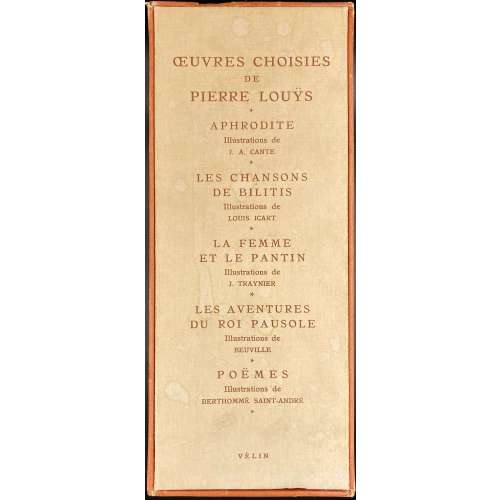 A double slipcase ‘box set’ of five volumes, 25.2 x 19.8 x 10.7 cm, lettered to spine: ŒUVRES CHOISIES | DE | PIERRE LOUŸS |★| APHRODITE | Illustrations de | J. A. CANTE |★| LES CHANSONS | DE BILITIS | Illustrations de | LOUIS ICART |★| LA FEMME | ET LE PANTIN | Illustrations de | J. TRAYNIER |★| LES AVENTURES DU ROI PAUSOLE | Illustrations de | BEUVILLE |★| Poëmes | Illustrations de | BERTHOMMÉ SAINT-ANDRÉ |★| VÉLIN || ; all uniformly bound in French flapped wrappers with colour vignettes and lettering to front and spine, printed on wove paper (Vélin) in Paris by Imprimerie Union and hand-coloured by Établissements Bellarde. Edition limited to 20 copies on Vélin d’Arches; 60 copies on Pur Fil du Marais, 150 copies on Pur Fil Lafuma, and 1500 copies on Vélin. This set is copy № 1467 on Vélin. 1) PIERRE LOUŸS | APHRODITE | MŒURS ANTIQUES |★| ILLUSTRATIONS EN COULEURS DE | J. A. CANTE | {vignette} | ÉDITIONS | ALBIN MICHEL | PARIS ||; pp: [i-xi] xii-xiv [xv-xviii] 19-245 [11] ; total 256 pages (128 leaves) with 5 headpieces and 8 in-text illustrations plus 8 full-page plates after J. A. Cante (French, fl. c. 1947 – 1962); partially uncut. 2) PIERRE LOUŸS | Les Chansons | de Bilitis | TRADUITES DU GREC | ILLUSTRATIONS EN COULEURS DE | LOUIS ICART | {vignette} | ÉDITIONS | ALBIN MICHEL | PARIS ||; pp: [i-x] xi-xix [xx] [2] 3-190 [6] ; total 216 pages (108 leaves) with 13 headpieces, one tailpiece plus 8 leaves of plates incl. frontispiece after Louis Icart (French, 1888 – 1950); partially uncut. 3) PIERRE LOUŸS | LA FEMME | ET LE PANTIN | Roman Espagnol | ILLUSTRATIONS EN COULEURS DE | J. TRAYNIER | {vignette} | ÉDITIONS | ALBIN MICHEL | PARIS ||; pp: [1-14] 15-144 [8] ; total 152 pages (76 leaves) with 5 headpieces, 6 in-text illustrations plus 8 leaves of plates incl. frontispiece after Jean Traynier (French, fl. c. 1942 – 1954); partially uncut. 4) PIERRE LOUŸS | Les Aventures | du | ROI PAUSOLE | ILLUSTRATIONS EN COULEURS DE | BEUVILLE | {vignette} | ÉDITIONS | ALBIN MICHEL | PARIS ||; pp: [1-12] 13-252 [4]; total 256 pages (128 leaves) with 4 section vignettes, 4 headpieces plus 12 leaves of plates after Georges Beuville (French, 1902 – 1982); partially uncut. 5) PIERRE LOUŸS | POËMES | ASTARTE • IRIS • AQUARELLES PASSIONNÉERS | HIVERNALES • LA FORÊT DES NYMPHES • STANCES | DERNIERS VERS • POËMES DIVERS | FRAGMENTS | ILLUSTRATIONS EN COULEURS DE | BERTHOMMÉ SAINT-ANDRÉ | {vignette} | ÉDITIONS | ALBIN MICHEL | PARIS ||; pp: [1-8] 9-241 [242] [6]; total 248 pages (124 leaves) with 11 headpieces plus 8 leaves of plates after Louis Berthomme Saint-André (French, 1905 – 1977); partially uncut. Author: Pierre Louÿs (French, 1870 – 1925).
A double slipcase ‘box set’ of five volumes, 25.2 x 19.8 x 10.7 cm, lettered to spine: ŒUVRES CHOISIES | DE | PIERRE LOUŸS |★| APHRODITE | Illustrations de | J. A. CANTE |★| LES CHANSONS | DE BILITIS | Illustrations de | LOUIS ICART |★| LA FEMME | ET LE PANTIN | Illustrations de | J. TRAYNIER |★| LES AVENTURES DU ROI PAUSOLE | Illustrations de | BEUVILLE |★| Poëmes | Illustrations de | BERTHOMMÉ SAINT-ANDRÉ |★| VÉLIN || ; all uniformly bound in French flapped wrappers with colour vignettes and lettering to front and spine, printed on wove paper (Vélin) in Paris by Imprimerie Union and hand-coloured by Établissements Bellarde. Edition limited to 20 copies on Vélin d’Arches; 60 copies on Pur Fil du Marais, 150 copies on Pur Fil Lafuma, and 1500 copies on Vélin. This set is copy № 1467 on Vélin. 1) PIERRE LOUŸS | APHRODITE | MŒURS ANTIQUES |★| ILLUSTRATIONS EN COULEURS DE | J. A. CANTE | {vignette} | ÉDITIONS | ALBIN MICHEL | PARIS ||; pp: [i-xi] xii-xiv [xv-xviii] 19-245 [11] ; total 256 pages (128 leaves) with 5 headpieces and 8 in-text illustrations plus 8 full-page plates after J. A. Cante (French, fl. c. 1947 – 1962); partially uncut. 2) PIERRE LOUŸS | Les Chansons | de Bilitis | TRADUITES DU GREC | ILLUSTRATIONS EN COULEURS DE | LOUIS ICART | {vignette} | ÉDITIONS | ALBIN MICHEL | PARIS ||; pp: [i-x] xi-xix [xx] [2] 3-190 [6] ; total 216 pages (108 leaves) with 13 headpieces, one tailpiece plus 8 leaves of plates incl. frontispiece after Louis Icart (French, 1888 – 1950); partially uncut. 3) PIERRE LOUŸS | LA FEMME | ET LE PANTIN | Roman Espagnol | ILLUSTRATIONS EN COULEURS DE | J. TRAYNIER | {vignette} | ÉDITIONS | ALBIN MICHEL | PARIS ||; pp: [1-14] 15-144 [8] ; total 152 pages (76 leaves) with 5 headpieces, 6 in-text illustrations plus 8 leaves of plates incl. frontispiece after Jean Traynier (French, fl. c. 1942 – 1954); partially uncut. 4) PIERRE LOUŸS | Les Aventures | du | ROI PAUSOLE | ILLUSTRATIONS EN COULEURS DE | BEUVILLE | {vignette} | ÉDITIONS | ALBIN MICHEL | PARIS ||; pp: [1-12] 13-252 [4]; total 256 pages (128 leaves) with 4 section vignettes, 4 headpieces plus 12 leaves of plates after Georges Beuville (French, 1902 – 1982); partially uncut. 5) PIERRE LOUŸS | POËMES | ASTARTE • IRIS • AQUARELLES PASSIONNÉERS | HIVERNALES • LA FORÊT DES NYMPHES • STANCES | DERNIERS VERS • POËMES DIVERS | FRAGMENTS | ILLUSTRATIONS EN COULEURS DE | BERTHOMMÉ SAINT-ANDRÉ | {vignette} | ÉDITIONS | ALBIN MICHEL | PARIS ||; pp: [1-8] 9-241 [242] [6]; total 248 pages (124 leaves) with 11 headpieces plus 8 leaves of plates after Louis Berthomme Saint-André (French, 1905 – 1977); partially uncut. Author: Pierre Louÿs (French, 1870 – 1925). -
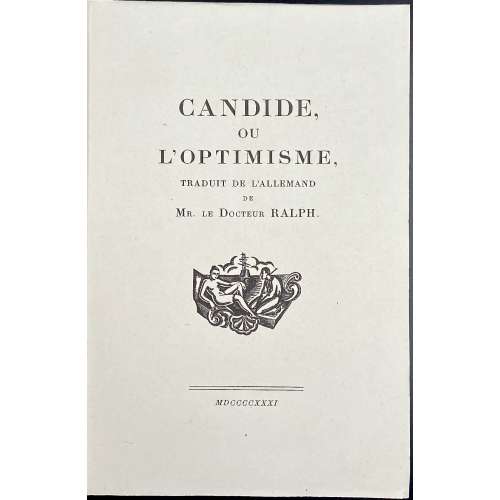 Softcover, 26 x 16.5 cm, publisher’s grey wrappers lettered in black, unbound, in a green double slipcase; collated in-4to, 24 leaves folded in four, pp.: [8] [1] 2-174 [10], total 192 pages, ils. Title-page: CANDIDE, | OU L’OPTIMISME, | TRADUIT DE L’ALLEMAND | DE | Mr. le Docteur RALPH. | {fleuron} | — | MDCCCCXXXI || Collation: π4 1-214 222 22*4 χ2, total 96 leaves, all on laid paper but χ (Avis au relieur) on Arches wove paper (watermarked) plus frontispiece and 12 engraved plates after Jean Roy. Limited edition of 300 copies — 5 on Chine, 10 on Japon, and the rest (275) on Arches, not for sale; of which this is copy № 3, numbered and signed by the artist ‘au crayon rouge’. Catalogue raisonné: Dutel 1137. Contributors: François-Marie Arouet [Voltaire] (French, 1694 – 1778) – author. Jean Roy – artist; attributed by most to Marcel North (British-Swiss, 1909 – 1990), and by J.P. Dutel to Edy Legrand (French, 1892 – 1970).
Softcover, 26 x 16.5 cm, publisher’s grey wrappers lettered in black, unbound, in a green double slipcase; collated in-4to, 24 leaves folded in four, pp.: [8] [1] 2-174 [10], total 192 pages, ils. Title-page: CANDIDE, | OU L’OPTIMISME, | TRADUIT DE L’ALLEMAND | DE | Mr. le Docteur RALPH. | {fleuron} | — | MDCCCCXXXI || Collation: π4 1-214 222 22*4 χ2, total 96 leaves, all on laid paper but χ (Avis au relieur) on Arches wove paper (watermarked) plus frontispiece and 12 engraved plates after Jean Roy. Limited edition of 300 copies — 5 on Chine, 10 on Japon, and the rest (275) on Arches, not for sale; of which this is copy № 3, numbered and signed by the artist ‘au crayon rouge’. Catalogue raisonné: Dutel 1137. Contributors: François-Marie Arouet [Voltaire] (French, 1694 – 1778) – author. Jean Roy – artist; attributed by most to Marcel North (British-Swiss, 1909 – 1990), and by J.P. Dutel to Edy Legrand (French, 1892 – 1970). -
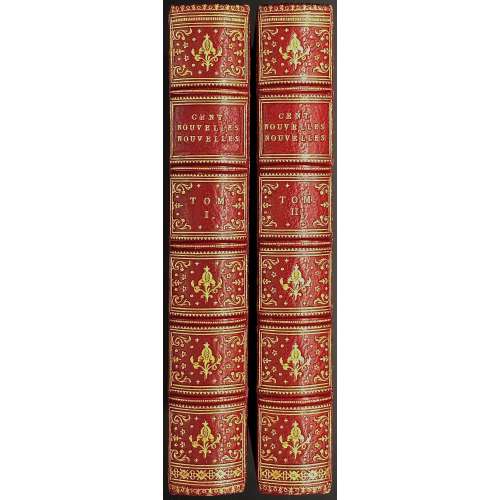 Description: Two volumes, 16.5 x 11 cm, collated 8vo, uniformly bound in the mid-19th century by H. Stamper (stamp to verso free endpaper) in red Morocco, ornated with gilt fillets and dentelles to boards and turn-ins, spine with raised bands and gilt decorations and lettering in compartments, marbled endpapers, all edges gilt; printed on laid paper; bookplate to front pastedown “EX LIBRIS | DANIEL | BERDITCHEVSKY”. Title-page (red and black, tall ‘s’): LES CENT | NOUVELLES | NOUVELLES. | SUIVENT LES CENT NOUVELLES | CONTENANT | Les Cent Histoires Nouveaux, | Qui sont moult plaisans a raconter, | En toutes bonnes Compagnies, | Par MANIERE DE JOYEUSETÉ. | Avec d'excellentes Figures en Taille-douce, | Gravées sur les desseins du fameux Mr. | ROMAIN DE HOOGE | & retouchées par feu | B. PICART LE ROMAIN | TOME PREMIER (TOME SECOND) |{device} | A COLOGNE | Chez Pierre Gaillard. | M.DCCXXXVI. || Vol. 1: Collation: [1] flyleaf torn out, [1] frontispiece, [1] title-page, [3] preface (*2-4), [1] Auertissement, [10] table (2+**-**8), A-Bb8 (Bb8 blank); 45 in-text half-page copperplate etchings by various engravers after Romain de Hooge; total 215 leaves plus ffl and frontispiece by Gilliam van der Gouwen after Romain de Hooge. Pagination (starting from t.p.): [30] 1-397 [398] [2], total 430 pages. Vol. 2: Collation: ffl, [*1] t.p., [11] table (*2-8, **-4), A-Aa8 Bb4 (Bb4 blank); 55 in-text half-page copperplate etchings by various engravers after Romain de Hooge; total 208 leaves plus ffl. Pagination: [24] 1-389 [390] [2], total 416 pages. Catalogue raisonné: Landwehr (1970) № 94, p. 203; Lewine (1898) p. 326; Cohen-DeRicci (1912) p. 658. Landwehr cites two editions after the 1st of 1701: Amsterdam 1732 and Cologne 1786 [i.e. 1736]. Both Lewine and Cohen-DeRicci attribute the text to Louis XI and mention the 1736 reprint (though not 1786). The first edition of “Les cent nouvelles nouvelles” appeared in 1486 by commission of Duke of Burgundy Philippe le Bon; the text is attributed to Philippe Pot (1428 – 1493), Antoine de La Sale (c. 1385 – c. 1460) or King Louis XI (1423 – 1483). Contributors: Artists: Romain de Hooge (Dutch, 1645 – 1708) Bernard Picart (French, 1673 – 1733) Engravers: Gilliam van der Gouwen (Dutch, c. 1657 – 1716) (frontispiece) Laurens Scherm (Dutch, fl. 1689 – 1701) (nouvelles XXIX, XXX, LXXVII) Jan Van Vianen (Dutch, c.1660 – 1726?) (nouvelles L, LII, LVII-LX, LXIV-LXVII, LXX) Binder: Henry Stamper (British, 1802? – 1887) Commissioner: Philippe le Bon [Philip III] (French, 1396 – 1467) Publisher: Pierre Gaillard (French, fl. 1715 – 1737)
Description: Two volumes, 16.5 x 11 cm, collated 8vo, uniformly bound in the mid-19th century by H. Stamper (stamp to verso free endpaper) in red Morocco, ornated with gilt fillets and dentelles to boards and turn-ins, spine with raised bands and gilt decorations and lettering in compartments, marbled endpapers, all edges gilt; printed on laid paper; bookplate to front pastedown “EX LIBRIS | DANIEL | BERDITCHEVSKY”. Title-page (red and black, tall ‘s’): LES CENT | NOUVELLES | NOUVELLES. | SUIVENT LES CENT NOUVELLES | CONTENANT | Les Cent Histoires Nouveaux, | Qui sont moult plaisans a raconter, | En toutes bonnes Compagnies, | Par MANIERE DE JOYEUSETÉ. | Avec d'excellentes Figures en Taille-douce, | Gravées sur les desseins du fameux Mr. | ROMAIN DE HOOGE | & retouchées par feu | B. PICART LE ROMAIN | TOME PREMIER (TOME SECOND) |{device} | A COLOGNE | Chez Pierre Gaillard. | M.DCCXXXVI. || Vol. 1: Collation: [1] flyleaf torn out, [1] frontispiece, [1] title-page, [3] preface (*2-4), [1] Auertissement, [10] table (2+**-**8), A-Bb8 (Bb8 blank); 45 in-text half-page copperplate etchings by various engravers after Romain de Hooge; total 215 leaves plus ffl and frontispiece by Gilliam van der Gouwen after Romain de Hooge. Pagination (starting from t.p.): [30] 1-397 [398] [2], total 430 pages. Vol. 2: Collation: ffl, [*1] t.p., [11] table (*2-8, **-4), A-Aa8 Bb4 (Bb4 blank); 55 in-text half-page copperplate etchings by various engravers after Romain de Hooge; total 208 leaves plus ffl. Pagination: [24] 1-389 [390] [2], total 416 pages. Catalogue raisonné: Landwehr (1970) № 94, p. 203; Lewine (1898) p. 326; Cohen-DeRicci (1912) p. 658. Landwehr cites two editions after the 1st of 1701: Amsterdam 1732 and Cologne 1786 [i.e. 1736]. Both Lewine and Cohen-DeRicci attribute the text to Louis XI and mention the 1736 reprint (though not 1786). The first edition of “Les cent nouvelles nouvelles” appeared in 1486 by commission of Duke of Burgundy Philippe le Bon; the text is attributed to Philippe Pot (1428 – 1493), Antoine de La Sale (c. 1385 – c. 1460) or King Louis XI (1423 – 1483). Contributors: Artists: Romain de Hooge (Dutch, 1645 – 1708) Bernard Picart (French, 1673 – 1733) Engravers: Gilliam van der Gouwen (Dutch, c. 1657 – 1716) (frontispiece) Laurens Scherm (Dutch, fl. 1689 – 1701) (nouvelles XXIX, XXX, LXXVII) Jan Van Vianen (Dutch, c.1660 – 1726?) (nouvelles L, LII, LVII-LX, LXIV-LXVII, LXX) Binder: Henry Stamper (British, 1802? – 1887) Commissioner: Philippe le Bon [Philip III] (French, 1396 – 1467) Publisher: Pierre Gaillard (French, fl. 1715 – 1737) -
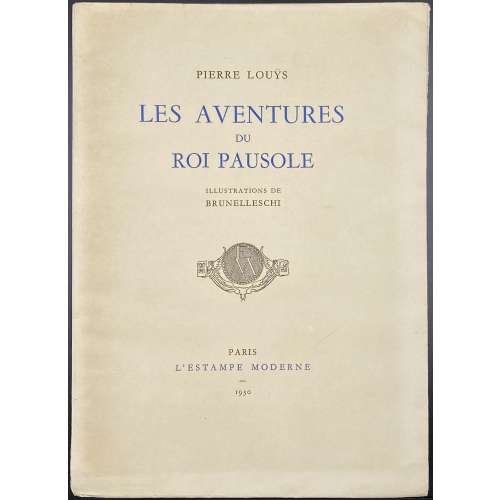 Binding: One volume collated 4to, 27 x 19.4 cm in publisher’s French flapped cream wrappers lettered in blue and black to front and spine. Printed on watermarked laid paper (vergé d’Arches), outer and bottom margins untrimmed. Front wrapper (blue and black): PIERRE LOUŸS | LES AVENTURES | DU | ROI PAUSOLE | ILLUSTRATIONS DE | BRUNELLESCHI | {publisher’s device «EM»} | PARIS | L’ESTAMPE MODERNE | 1930 || Title page: PIERRE LOUŸS | LES AVENTURES | DU | ROI PAUSOLE | CONTENANT | DIX-SEPT ILLUSTRATIONS | EN COULEURS DONT NEUF HORS-TEXTE | PAR | BRUNELLESCHI | {publisher’s device} | PARIS | L’ESTAMPE MODERNE | ÉDITEURS | 14, RUE DE RICHELIEU, 14 | 1930 || Collation: 4to; π4 (incl. 1st blank, h.t./limit., t.p., d.t.p.) [1]-414 (last gathering uncut); total 168 leaves plus 9 plates with tissue guards extraneous to collation, incl. frontispiece, stencil-coloured etchings by Gorvel after Brunelleschi. Pagination: [6] [2] 3-324 [6], total 336 pages, ils. Limitation: Edition limited to 524 copies, 6 on Japon Impérial, enriched (№ 1-6); 13 on Japon Impérial, enriched (№ 7-19); 30 on Japon Impérial, enriched (№ 20-49); 450 on vergé d’Arches (№ 50-499); 5 on Japon Impérial (№ I-V) not for sale, and 20 on vergé d’Arches (№ VI-XXV) not for sale. This copy is № 300, on vergé d’Arches. Printed: January 30, 1930, by Coulouma (Argenteuil), plates by Ad. Valcke (Paris), stencil-colouring by J. Saudé. Contributors: Pierre Louÿs (French, 1870 – 1925) – author. Umberto Brunelleschi (Italian, 1879 – 1949) – artist. Georges Emile Louis Eugene Gorvel (French, 1866 – 1938) – etcher. Jean Saudé (French, fl. c. 1890 – 1930) – printer (pochoir, stencil) Coulouma (Argenteuil) – printer L’Estampe Moderne – publisher.
Binding: One volume collated 4to, 27 x 19.4 cm in publisher’s French flapped cream wrappers lettered in blue and black to front and spine. Printed on watermarked laid paper (vergé d’Arches), outer and bottom margins untrimmed. Front wrapper (blue and black): PIERRE LOUŸS | LES AVENTURES | DU | ROI PAUSOLE | ILLUSTRATIONS DE | BRUNELLESCHI | {publisher’s device «EM»} | PARIS | L’ESTAMPE MODERNE | 1930 || Title page: PIERRE LOUŸS | LES AVENTURES | DU | ROI PAUSOLE | CONTENANT | DIX-SEPT ILLUSTRATIONS | EN COULEURS DONT NEUF HORS-TEXTE | PAR | BRUNELLESCHI | {publisher’s device} | PARIS | L’ESTAMPE MODERNE | ÉDITEURS | 14, RUE DE RICHELIEU, 14 | 1930 || Collation: 4to; π4 (incl. 1st blank, h.t./limit., t.p., d.t.p.) [1]-414 (last gathering uncut); total 168 leaves plus 9 plates with tissue guards extraneous to collation, incl. frontispiece, stencil-coloured etchings by Gorvel after Brunelleschi. Pagination: [6] [2] 3-324 [6], total 336 pages, ils. Limitation: Edition limited to 524 copies, 6 on Japon Impérial, enriched (№ 1-6); 13 on Japon Impérial, enriched (№ 7-19); 30 on Japon Impérial, enriched (№ 20-49); 450 on vergé d’Arches (№ 50-499); 5 on Japon Impérial (№ I-V) not for sale, and 20 on vergé d’Arches (№ VI-XXV) not for sale. This copy is № 300, on vergé d’Arches. Printed: January 30, 1930, by Coulouma (Argenteuil), plates by Ad. Valcke (Paris), stencil-colouring by J. Saudé. Contributors: Pierre Louÿs (French, 1870 – 1925) – author. Umberto Brunelleschi (Italian, 1879 – 1949) – artist. Georges Emile Louis Eugene Gorvel (French, 1866 – 1938) – etcher. Jean Saudé (French, fl. c. 1890 – 1930) – printer (pochoir, stencil) Coulouma (Argenteuil) – printer L’Estampe Moderne – publisher. -
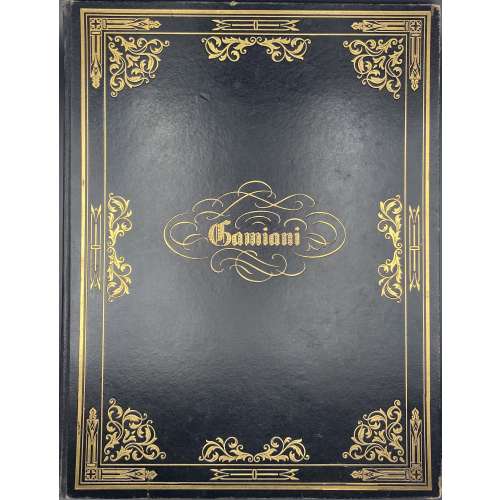 A German translation of de Musset’s “Gamiani ou deux nuits d’excès” illustrated with a reprint title-page and 11 (instead of 16) hand-coloured photogravures after original lithographs by Devéria and Henri Grévedon or Octave Tassaert for 1833 edition, though from the re-drawn stones. Large volume, 40.5 x 31 cm, collated 4to, in black calf with lettering and elaborate gilt border to front and blind border to back, outer and bottom margins uncut, marbled endpapers, text and plates printed on wove paper. The reprint t.p. is different from the original one; in the 1833 edition, the line deux nuits d’excès is waving while here it is straight. Letterpress title-page: ALFRED DE MUSSET | GAMIANI | ODER | ZWEI NÄCHTE DER AUSSCHWEIFUNG || Reprint title-page: Gamiani | OU | DEUX NUITS D’EXCÈS. | {vignette} | Bruxelles | 1833 || Collation: π2 1-74 82, total 32 leaves plus reprint t.p. and 11 plates. Pagination: [4] [1] 2-59 [60], total 64 pages, ils. Limitation: Edition limited to 300 numbered copies, of which this is copy № 32. Contributors: Alfred de Musset (French, 1810 – 1857) – author. Karl Spieler (German, 19th/20th century) – author of the foreword and translator. Achille Devéria (French, 1800 – 1857) – artist (attributed). Pierre Louis Henri Grévedon (French, 1776 – 1860) – artist (attributed). Octave Tassaert (French, 1800 – 1874) – artist (attributed). Catalogue raisonné: Dutel (1650-1880) № A-460, p. 149; Eros invaincu № 68, p. 171-3.
A German translation of de Musset’s “Gamiani ou deux nuits d’excès” illustrated with a reprint title-page and 11 (instead of 16) hand-coloured photogravures after original lithographs by Devéria and Henri Grévedon or Octave Tassaert for 1833 edition, though from the re-drawn stones. Large volume, 40.5 x 31 cm, collated 4to, in black calf with lettering and elaborate gilt border to front and blind border to back, outer and bottom margins uncut, marbled endpapers, text and plates printed on wove paper. The reprint t.p. is different from the original one; in the 1833 edition, the line deux nuits d’excès is waving while here it is straight. Letterpress title-page: ALFRED DE MUSSET | GAMIANI | ODER | ZWEI NÄCHTE DER AUSSCHWEIFUNG || Reprint title-page: Gamiani | OU | DEUX NUITS D’EXCÈS. | {vignette} | Bruxelles | 1833 || Collation: π2 1-74 82, total 32 leaves plus reprint t.p. and 11 plates. Pagination: [4] [1] 2-59 [60], total 64 pages, ils. Limitation: Edition limited to 300 numbered copies, of which this is copy № 32. Contributors: Alfred de Musset (French, 1810 – 1857) – author. Karl Spieler (German, 19th/20th century) – author of the foreword and translator. Achille Devéria (French, 1800 – 1857) – artist (attributed). Pierre Louis Henri Grévedon (French, 1776 – 1860) – artist (attributed). Octave Tassaert (French, 1800 – 1874) – artist (attributed). Catalogue raisonné: Dutel (1650-1880) № A-460, p. 149; Eros invaincu № 68, p. 171-3. -
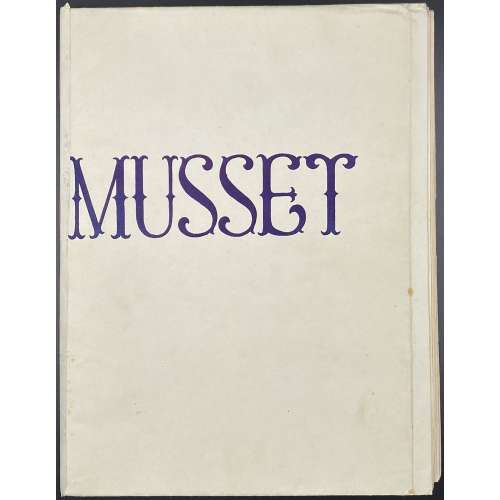 Description: one volume in French flapped wrappers 25.3 x 19 cm, lettered “MUSSET” to front, 5 gatherings of 4 and one of 6 leaves, 26 leaves total, pp.: [4] [2] 3-43 [44] [4], total 52 pages, incl. those in wrappers, unbound; plus coloured and uncoloured suites of 12 lithographs, in a paper folder; in a cardboard tan slipcase 2.8 x 19.3 cm. Artist unknown, publisher unknown, published at the end of 1940s (per J.-P. Dutel). Illustrations are a loose interpretation of original lithographs by Devéria and Henri Grévedon or Octave Tassaert for the 1833 edition ((1926 re-print LIB-3135.2023). Limitation: Edition limited to 250 copies printed on Vélin Chiffon numbered 1 -250 and 24 copies marked by letters A to Z. This is copy № 246, with two suites of plates, one coloured and one b/w. Catalogue raisonné: Dutel (1920-1970) № 1657, p. 189. Alfred de Musset (French, 1810 – 1857) – author.
Description: one volume in French flapped wrappers 25.3 x 19 cm, lettered “MUSSET” to front, 5 gatherings of 4 and one of 6 leaves, 26 leaves total, pp.: [4] [2] 3-43 [44] [4], total 52 pages, incl. those in wrappers, unbound; plus coloured and uncoloured suites of 12 lithographs, in a paper folder; in a cardboard tan slipcase 2.8 x 19.3 cm. Artist unknown, publisher unknown, published at the end of 1940s (per J.-P. Dutel). Illustrations are a loose interpretation of original lithographs by Devéria and Henri Grévedon or Octave Tassaert for the 1833 edition ((1926 re-print LIB-3135.2023). Limitation: Edition limited to 250 copies printed on Vélin Chiffon numbered 1 -250 and 24 copies marked by letters A to Z. This is copy № 246, with two suites of plates, one coloured and one b/w. Catalogue raisonné: Dutel (1920-1970) № 1657, p. 189. Alfred de Musset (French, 1810 – 1857) – author. -
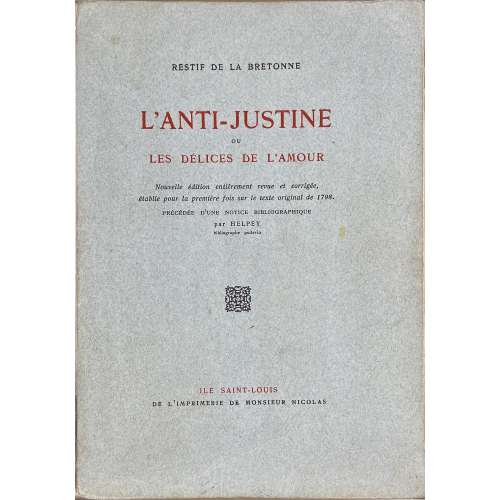 Description: One volume in grey-blue French flapped wrapper, 24 x 16.7 cm, collated 8vo, with black and red lettering to front cover, printed on watermarked thick wove paper Alfax Navarre, margins untrimmed, some pages uncut, illustrated with 12 aquatint plates signed Le Loup. Front wrapper and title (red and black): RESTIF DE LA BRETONNE | L'ANTI-JUSTINE | OU | LES DÉLICES DE L' AMOUR | Nouvelle édition entièrement revue et corrigée, | établie pour la première fois sur le texte original de 1798. | PRÉCÉDÉE D'UNE NOTICE BIBLIOGRAPHIQUE | par HELPEY | bibliographe poitevin | {device} | ILE SAINT-LOUIS | DE L’IMPRIMERIE DE Monsieur Nicolas. Limitation: Printed 350 copies, numbered 1-350, on alfax paper; this copy is № 256. Collation: 1-158 166, incl. the 1st and last leaves within the wrappers, total 126 leaves plus 12 plates extraneous to collation. Pagination: [4 blank] [1-4] 5-243 [244 blank] [4 blank], total 252 pages, ils. Catalogue raisonné: Dutel (1920-1970) № 1025, p. 45. Ref.: Danson Erotica Collection at Trinity College, Oxford – KK.6.33. Contributors: Nicolas Edmé Restif de la Bretonne (French, 1734 – 1806) – author. Louis Perceau [Helpey] (French, 1883 – 1942) – author. Maurice Henri Hector Duflou (French, 1885 – 1951) – publisher. The artist – Le Loup – unidentified.
Description: One volume in grey-blue French flapped wrapper, 24 x 16.7 cm, collated 8vo, with black and red lettering to front cover, printed on watermarked thick wove paper Alfax Navarre, margins untrimmed, some pages uncut, illustrated with 12 aquatint plates signed Le Loup. Front wrapper and title (red and black): RESTIF DE LA BRETONNE | L'ANTI-JUSTINE | OU | LES DÉLICES DE L' AMOUR | Nouvelle édition entièrement revue et corrigée, | établie pour la première fois sur le texte original de 1798. | PRÉCÉDÉE D'UNE NOTICE BIBLIOGRAPHIQUE | par HELPEY | bibliographe poitevin | {device} | ILE SAINT-LOUIS | DE L’IMPRIMERIE DE Monsieur Nicolas. Limitation: Printed 350 copies, numbered 1-350, on alfax paper; this copy is № 256. Collation: 1-158 166, incl. the 1st and last leaves within the wrappers, total 126 leaves plus 12 plates extraneous to collation. Pagination: [4 blank] [1-4] 5-243 [244 blank] [4 blank], total 252 pages, ils. Catalogue raisonné: Dutel (1920-1970) № 1025, p. 45. Ref.: Danson Erotica Collection at Trinity College, Oxford – KK.6.33. Contributors: Nicolas Edmé Restif de la Bretonne (French, 1734 – 1806) – author. Louis Perceau [Helpey] (French, 1883 – 1942) – author. Maurice Henri Hector Duflou (French, 1885 – 1951) – publisher. The artist – Le Loup – unidentified. -
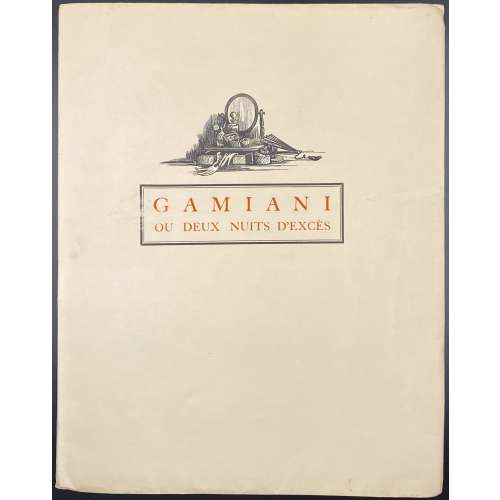 Description: Softcover volume 27 x 21.3 cm in publisher’s French flapped cream wrappers, with a vignette and lettered in red within a black frame to front "GAMIANI | OU DEUX NUITS D'EXCÈS". Printed on unmarked wove paper, outer and lower margins untrimmed. Illustrated with full-page frontispiece, 10 headpieces, and 5 smaller woodcuts (one repeated on the front wrapper and on t.p.) by Pierre Aubert after Jean-Gabriel Daragnès [pseud. Jean de Guethary], some with inlaid tissue guards. Copy enriched with one graphite pencil drawing signed "J. de Guethary", tipped in before h.t. Title-page (red and black): GAMIANI | OU DEUX NUITS D'EXCÈS | PAR A. DE M. | Avec | des vignettes | de | JEAN DE GUETHARY | {VIGNETTE} | — | CHEZ UN BOURGEOIS DE PARIS | Rue du Coq Hardi | 1845 || Pagination: [i-vi] (orig. drawing, h.t. / vignette, t.p./limit.) [vii] viii-xx, [1-3] 4-64 [4]; total 88 pages. Limitation: Edition limited to 110 copies. According to Dutel, 110 copies were printed on Japon ancient, 3 on Japon Impérial, and 3 on Whatman. This copy is № 115. Catalogue raisonné: Dutel (1920-1970): № 1630, p. 183; Pia (Enfer) 527, p. 286. Alfred de Musset (French, 1810 – 1857) – author. Jean-Gabriel Daragnès (French, 1886 – 1950) – artist, publisher. Pierre Aubert (Swiss, 1910 – 1987) – engraver.
Description: Softcover volume 27 x 21.3 cm in publisher’s French flapped cream wrappers, with a vignette and lettered in red within a black frame to front "GAMIANI | OU DEUX NUITS D'EXCÈS". Printed on unmarked wove paper, outer and lower margins untrimmed. Illustrated with full-page frontispiece, 10 headpieces, and 5 smaller woodcuts (one repeated on the front wrapper and on t.p.) by Pierre Aubert after Jean-Gabriel Daragnès [pseud. Jean de Guethary], some with inlaid tissue guards. Copy enriched with one graphite pencil drawing signed "J. de Guethary", tipped in before h.t. Title-page (red and black): GAMIANI | OU DEUX NUITS D'EXCÈS | PAR A. DE M. | Avec | des vignettes | de | JEAN DE GUETHARY | {VIGNETTE} | — | CHEZ UN BOURGEOIS DE PARIS | Rue du Coq Hardi | 1845 || Pagination: [i-vi] (orig. drawing, h.t. / vignette, t.p./limit.) [vii] viii-xx, [1-3] 4-64 [4]; total 88 pages. Limitation: Edition limited to 110 copies. According to Dutel, 110 copies were printed on Japon ancient, 3 on Japon Impérial, and 3 on Whatman. This copy is № 115. Catalogue raisonné: Dutel (1920-1970): № 1630, p. 183; Pia (Enfer) 527, p. 286. Alfred de Musset (French, 1810 – 1857) – author. Jean-Gabriel Daragnès (French, 1886 – 1950) – artist, publisher. Pierre Aubert (Swiss, 1910 – 1987) – engraver. -
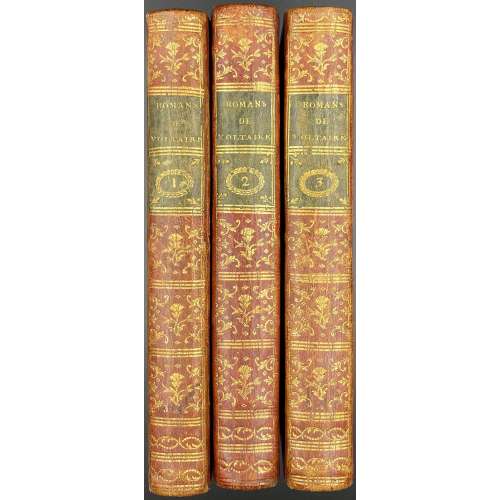 Three volumes, 8vo, 20.5 x 13.5 cm each, uniformly bound in crimson morocco, ruled in triple-fillet gilt, flat spine, triple-fillet gilt-ruled compartments with gilt elements in compartments, two black labels lettered in gilt, marbled endpapers, all edges gilt, multiple woodcut tailpieces. Armorial bookplate of Henricus Liber Baro de Gudenus to front pastedowns in all volumes: “HENRICVS LIBER BARO | DE GVDENVS | 1891 | Jauner”. Title-page: ROMANS | ET | CONTES | DE | M. DE VOLTAIRE | {chain rule} | TOME PREMIER (SECOND; TROISIEME). | {chain rule} | {publisher’s device with motto: “nuper sub modio nunc super”} | A BOUILLON, | AUX DEPENS DE LA SOCIETE TYPOGRAPHIQUE. | {floral rule} | M. DCC. LXXVIII. || Vol. 1: Collation: π2 (h.t., t.p.) a1 (table), A-T8, (Aiv unsigned), total 155 leaves plus 16 leaves of plates, incl. frontispiece, and two blanks – first and last, extraneous to collation. Frontispiece by Cathelin after de La Tour, unsigned t.p. vignette (device), 5 unsigned headpieces, and 15 plates after Monnet by Chatelin, Dambrun (5) Deny (6), Thiébault (2), and Vidal. Pagination: [i-v] vi [1-3] 4-304, total 310 pages, ils. Vol. 2: Collation: π2 (h.t., t.p.) a2 (table), A-V8, total 164 leaves plus 20 leaves of plates, incl. frontispiece, extraneous to collation, no blanks. Frontispiece by Dambrun after Monnet, unsigned t.p. vignette (device), 3 headpieces by Deny after Monnet, 2 unsigned headpieces, 19 plates: after Martiny by Deny; after Monnet by Baquoy, Dambrun (3), Deny (9), and Vidal (4); and after Moreau by Deny. Pagination: [i-v] vi-viii [1-3] 4-320, total 328 pages, ils. Vol.3: π2 (h.t., t.p.) a1 (table), A-O8 P6 a-f8 g1 h2 ('avis au relieur'), total 172 leaves plus 21 leaves of plates, incl. frontispiece, extraneous to collation, no blanks. Frontispiece by Dambrun after Monnet, unsigned t.p. vignette (device), indistinctly signed headpiece to “Jenni” after Monnet (probably Thiébault), 2 unsigned headpieces, 20 plates: after Marillier by Deny (4), Lorieux (2), Patas, and Vidal. Pagination: [i-v] vi [1-3] 4-236, [1-2] 3-102, total 328 pages, ils. Provenance: Heinrich von Gudenus [Heinrich Johann Baptist Ghislain von Gudenus] (Austrian, 1839 – 1915); ref.: Bibliotheca Ecclesiae Metropolitanae Strigoniensis. Catalogue raisonné: Ray (French): № 35, pp. 71-2; Cohen - de Ricci: 1038-9; Lewine: 562-3. Contributors: François Marie Arouet de Voltaire (French, 1694 – 1778) – author. Artists: Clément Pierre Marillier (French, 1740 – 1808) Maurice Quentin de La Tour (French, 1704 – 1788) Charles Monnet [Monet] (French, 1732 – 1819) Pietro Antonio Martini (Italian, 1738 – 1797) Jean-Michel Moreau [Moreau le Jeune] (French, 1741 – 1814) Engravers: Jean Charles Baquoy (French, 1721–1777) Louis-Jacques Cathelin (French, 1738 – 1804) John Baptist Chatelain (British, 1710 – 1758) Jean Dambrun (French, 1741 – 1808/14) Jeanne Deny (French, 1749 – c. 1815) Martial Deny (French, b. 1745) F. B. Lorieux (French, fl. 1786 – 1810) Charles Emmanuel Patas (French, 1744 – 1802) Elisabeth Thiébault (French, 18th century) Gérard Vidal (French, 1742 – 1801)
Three volumes, 8vo, 20.5 x 13.5 cm each, uniformly bound in crimson morocco, ruled in triple-fillet gilt, flat spine, triple-fillet gilt-ruled compartments with gilt elements in compartments, two black labels lettered in gilt, marbled endpapers, all edges gilt, multiple woodcut tailpieces. Armorial bookplate of Henricus Liber Baro de Gudenus to front pastedowns in all volumes: “HENRICVS LIBER BARO | DE GVDENVS | 1891 | Jauner”. Title-page: ROMANS | ET | CONTES | DE | M. DE VOLTAIRE | {chain rule} | TOME PREMIER (SECOND; TROISIEME). | {chain rule} | {publisher’s device with motto: “nuper sub modio nunc super”} | A BOUILLON, | AUX DEPENS DE LA SOCIETE TYPOGRAPHIQUE. | {floral rule} | M. DCC. LXXVIII. || Vol. 1: Collation: π2 (h.t., t.p.) a1 (table), A-T8, (Aiv unsigned), total 155 leaves plus 16 leaves of plates, incl. frontispiece, and two blanks – first and last, extraneous to collation. Frontispiece by Cathelin after de La Tour, unsigned t.p. vignette (device), 5 unsigned headpieces, and 15 plates after Monnet by Chatelin, Dambrun (5) Deny (6), Thiébault (2), and Vidal. Pagination: [i-v] vi [1-3] 4-304, total 310 pages, ils. Vol. 2: Collation: π2 (h.t., t.p.) a2 (table), A-V8, total 164 leaves plus 20 leaves of plates, incl. frontispiece, extraneous to collation, no blanks. Frontispiece by Dambrun after Monnet, unsigned t.p. vignette (device), 3 headpieces by Deny after Monnet, 2 unsigned headpieces, 19 plates: after Martiny by Deny; after Monnet by Baquoy, Dambrun (3), Deny (9), and Vidal (4); and after Moreau by Deny. Pagination: [i-v] vi-viii [1-3] 4-320, total 328 pages, ils. Vol.3: π2 (h.t., t.p.) a1 (table), A-O8 P6 a-f8 g1 h2 ('avis au relieur'), total 172 leaves plus 21 leaves of plates, incl. frontispiece, extraneous to collation, no blanks. Frontispiece by Dambrun after Monnet, unsigned t.p. vignette (device), indistinctly signed headpiece to “Jenni” after Monnet (probably Thiébault), 2 unsigned headpieces, 20 plates: after Marillier by Deny (4), Lorieux (2), Patas, and Vidal. Pagination: [i-v] vi [1-3] 4-236, [1-2] 3-102, total 328 pages, ils. Provenance: Heinrich von Gudenus [Heinrich Johann Baptist Ghislain von Gudenus] (Austrian, 1839 – 1915); ref.: Bibliotheca Ecclesiae Metropolitanae Strigoniensis. Catalogue raisonné: Ray (French): № 35, pp. 71-2; Cohen - de Ricci: 1038-9; Lewine: 562-3. Contributors: François Marie Arouet de Voltaire (French, 1694 – 1778) – author. Artists: Clément Pierre Marillier (French, 1740 – 1808) Maurice Quentin de La Tour (French, 1704 – 1788) Charles Monnet [Monet] (French, 1732 – 1819) Pietro Antonio Martini (Italian, 1738 – 1797) Jean-Michel Moreau [Moreau le Jeune] (French, 1741 – 1814) Engravers: Jean Charles Baquoy (French, 1721–1777) Louis-Jacques Cathelin (French, 1738 – 1804) John Baptist Chatelain (British, 1710 – 1758) Jean Dambrun (French, 1741 – 1808/14) Jeanne Deny (French, 1749 – c. 1815) Martial Deny (French, b. 1745) F. B. Lorieux (French, fl. 1786 – 1810) Charles Emmanuel Patas (French, 1744 – 1802) Elisabeth Thiébault (French, 18th century) Gérard Vidal (French, 1742 – 1801) -
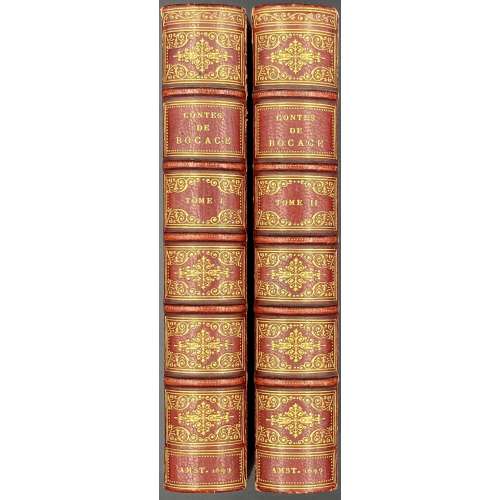 Vol. 1: Title page (in red and black): CONTES | ET | NOUVELLES | DE | BOCACE | FLORENTIN. | Traduction Libre, | Accommodée au gout de ce temps, & en- | richie de FIGURES en TAILLE- | DOUCE gravées par Mr. Romain | de Hooge. | TOME PREMIER. | {device} | A AMSTERDAM, | Chez GEORGE GALLET. | — | M. DC. XCIX. || Collation: 2 binder’s blank leaves, etched frontispiece or title, t.p. in red and black, *8 **4 (starting at *3, frontis. within collation of lacking one leaf) A—Y8 Z7, no final blank; 44 in-text half-page vignettes and one tipped-in additional plate (p. 212) in novella XXV (day 3, story 6: "Ricciardo Minutolo loves the wife of Filippello Fighinolfi, and knowing her to be jealous, makes her believe that his own wife is to meet Filippello at a Turkish bathhouse on an ensuing day; whereby she is induced to go thither, where, thinking to have been with her husband, she discovers that she has tarried with Ricciardo"), showing the ending of the story (45 illustrations total) Pagination: 12 unpaginated leaves [i-xxiv], pg. starts at A1, [1] 2-366. Vol. 2: Title-page: same as in vol. 1 but all in black and TOME SECOND. Collation: A-2D8 2E4, 56 in-text half-page vignettes. Pagination: [1,2] (t.p.), 3-427 (text) [13] (table, last page blank). Edition 1st edition, 2nd printing, edition of 1699 considered by most a re-issue of the 1697 edition. Description in Auction Sale Van Gendt, 1977, no. 1108: "The first, which has exactly the same collation was published by Gallet in 1697. It seems possible that the 1699 edition is, in fact, of the same issue, and that only the first quires of both volumes, which include the title pages were replaced by new ones with the new date, to make the book look more up to date. - The edition of 1702, also published by Gallet has "seconde édition", which, we think, sustains our theory." Binding: Two volumes uniformly bound by Chambolle-Duru in red crushed morocco, ruled gilt with triple-fillet, gilt dentelle inside, raised bands, gilt in compartments, AEG, marbled endpapers; to FEP verso in vol. 1 pasted a clipping, and in both volumes – bookplate “EX LIBRIS HELGE LOEWENBERG DOMP”. Provenance: Helge Loewenberg-Domp (Jewish-German, 1915 – 2021) Catalogue raisonnè: Landwehr (1970): № 88, p. 193 [LIB-2547.2020]. Contributors: Giovanni Boccaccio (Italian, 1313 – 1375) – author. Romeyn de Hooghe (Dutch, 1645 – 1708) – artist, etcher. Chambolle-Duru; René Victor Chambolle (French, 1834 – 1898), Hippolyte Duru (French, 1803 – 1884) – binder. George Gallet (Dutch, 17th-18th century) – printer, publisher.
Vol. 1: Title page (in red and black): CONTES | ET | NOUVELLES | DE | BOCACE | FLORENTIN. | Traduction Libre, | Accommodée au gout de ce temps, & en- | richie de FIGURES en TAILLE- | DOUCE gravées par Mr. Romain | de Hooge. | TOME PREMIER. | {device} | A AMSTERDAM, | Chez GEORGE GALLET. | — | M. DC. XCIX. || Collation: 2 binder’s blank leaves, etched frontispiece or title, t.p. in red and black, *8 **4 (starting at *3, frontis. within collation of lacking one leaf) A—Y8 Z7, no final blank; 44 in-text half-page vignettes and one tipped-in additional plate (p. 212) in novella XXV (day 3, story 6: "Ricciardo Minutolo loves the wife of Filippello Fighinolfi, and knowing her to be jealous, makes her believe that his own wife is to meet Filippello at a Turkish bathhouse on an ensuing day; whereby she is induced to go thither, where, thinking to have been with her husband, she discovers that she has tarried with Ricciardo"), showing the ending of the story (45 illustrations total) Pagination: 12 unpaginated leaves [i-xxiv], pg. starts at A1, [1] 2-366. Vol. 2: Title-page: same as in vol. 1 but all in black and TOME SECOND. Collation: A-2D8 2E4, 56 in-text half-page vignettes. Pagination: [1,2] (t.p.), 3-427 (text) [13] (table, last page blank). Edition 1st edition, 2nd printing, edition of 1699 considered by most a re-issue of the 1697 edition. Description in Auction Sale Van Gendt, 1977, no. 1108: "The first, which has exactly the same collation was published by Gallet in 1697. It seems possible that the 1699 edition is, in fact, of the same issue, and that only the first quires of both volumes, which include the title pages were replaced by new ones with the new date, to make the book look more up to date. - The edition of 1702, also published by Gallet has "seconde édition", which, we think, sustains our theory." Binding: Two volumes uniformly bound by Chambolle-Duru in red crushed morocco, ruled gilt with triple-fillet, gilt dentelle inside, raised bands, gilt in compartments, AEG, marbled endpapers; to FEP verso in vol. 1 pasted a clipping, and in both volumes – bookplate “EX LIBRIS HELGE LOEWENBERG DOMP”. Provenance: Helge Loewenberg-Domp (Jewish-German, 1915 – 2021) Catalogue raisonnè: Landwehr (1970): № 88, p. 193 [LIB-2547.2020]. Contributors: Giovanni Boccaccio (Italian, 1313 – 1375) – author. Romeyn de Hooghe (Dutch, 1645 – 1708) – artist, etcher. Chambolle-Duru; René Victor Chambolle (French, 1834 – 1898), Hippolyte Duru (French, 1803 – 1884) – binder. George Gallet (Dutch, 17th-18th century) – printer, publisher. -
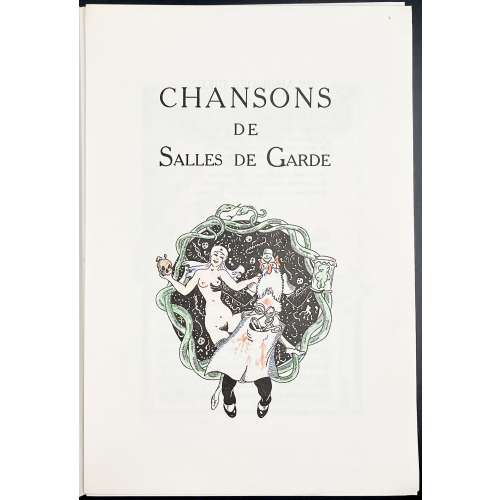 Title-page: CHANSONS | DE | SALLES DE GARDE | {vignette} || Description: 27.5 x 18.5 cm, in pictorial French flapped wrapper and in a green cloth folder, vertically lettered to spine “CHANSONS” in black letters, a flute benith. Pagination: [1-3] 4-140 [4] plus 52 plates extraneous to collation (Dutel provides for 142 pp.) Illustrations: plates, headbands, vignettes to front wrapper, title-page and limitation page, as well as the vignette at the end, reproduced after drawings by Morvan (according to J.-P. Dutel) and hand-coloured with crayons (the question remains, is it Hervé Morvan, French, 1917 – 1980?) Limitation: 950 copies of which 25 marked A to Z; 25 copies consist of an additional suite and one original drawing (№ 1-25); 25 copies have an original drawing (№ 26-50), and 875 copies numbered 51 to 950. This copy is № 697. Catalogue raisonné: Dutel (1920-1970): № 1186.
Title-page: CHANSONS | DE | SALLES DE GARDE | {vignette} || Description: 27.5 x 18.5 cm, in pictorial French flapped wrapper and in a green cloth folder, vertically lettered to spine “CHANSONS” in black letters, a flute benith. Pagination: [1-3] 4-140 [4] plus 52 plates extraneous to collation (Dutel provides for 142 pp.) Illustrations: plates, headbands, vignettes to front wrapper, title-page and limitation page, as well as the vignette at the end, reproduced after drawings by Morvan (according to J.-P. Dutel) and hand-coloured with crayons (the question remains, is it Hervé Morvan, French, 1917 – 1980?) Limitation: 950 copies of which 25 marked A to Z; 25 copies consist of an additional suite and one original drawing (№ 1-25); 25 copies have an original drawing (№ 26-50), and 875 copies numbered 51 to 950. This copy is № 697. Catalogue raisonné: Dutel (1920-1970): № 1186. -
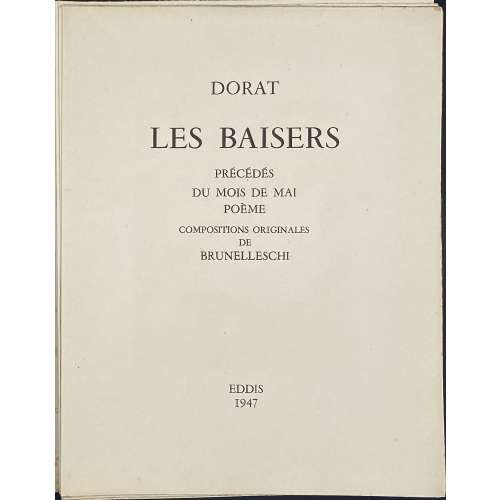 Title-page: DORAT | LES BAISERS | PRÉCÉDÉS | DU MOIS DE MAI | POÈME | COMPOSITIONS ORIGINALES | DE | BRUNELLESCHI | EDDIS | 1947 || Description: 23.3 x 19 cm, French slapped wrappers, sunned and heavy foxed, without a slipcase; [1-6] (h.t. with owner’s inscription / limitation with № 18, t.p., d.t.p.), 7-137 [138] [6] (colophon) plus 23 stencil-coloured (au pochoir) photogravure plates after Umberto Brunelleschi, his head- and tailpieces (total 60 designs). Printed by Gaston Maillet & Cie in Saint-Ouen on April 15, 1947. Photogravure by Deberni and Peignot under direction of R. Perrot. Limitation: 3,000 copies numbered 1 to 3,000 of which 500 copies on Vélin de Luxe (1–500) enriched with two suites of plates, one in colour and one toned, before letters; 2,500 on Vélin de Fabrication Spéciale of which copies numbered 500–1,000 enriched with one suite before letters, and 2,000 copies numbered 1,001–3,000. Besides, there are 200 additional copies numbered with Roman numbers reserved for foreign bibliophiles. This particular copy bears number 18, however, I don’t think it is printed on Vélin de Luxe, whatever it is, and does not have an extra suite of plates. Owner’s inscription pasted to h.t.: A Denise ce livre audacieux | mais qui par son art sait | tout faire pardonner — | Jane Darboy. Provenance: Jane Darboy (French, fl. 1932 – 1948) – a French writer.
Title-page: DORAT | LES BAISERS | PRÉCÉDÉS | DU MOIS DE MAI | POÈME | COMPOSITIONS ORIGINALES | DE | BRUNELLESCHI | EDDIS | 1947 || Description: 23.3 x 19 cm, French slapped wrappers, sunned and heavy foxed, without a slipcase; [1-6] (h.t. with owner’s inscription / limitation with № 18, t.p., d.t.p.), 7-137 [138] [6] (colophon) plus 23 stencil-coloured (au pochoir) photogravure plates after Umberto Brunelleschi, his head- and tailpieces (total 60 designs). Printed by Gaston Maillet & Cie in Saint-Ouen on April 15, 1947. Photogravure by Deberni and Peignot under direction of R. Perrot. Limitation: 3,000 copies numbered 1 to 3,000 of which 500 copies on Vélin de Luxe (1–500) enriched with two suites of plates, one in colour and one toned, before letters; 2,500 on Vélin de Fabrication Spéciale of which copies numbered 500–1,000 enriched with one suite before letters, and 2,000 copies numbered 1,001–3,000. Besides, there are 200 additional copies numbered with Roman numbers reserved for foreign bibliophiles. This particular copy bears number 18, however, I don’t think it is printed on Vélin de Luxe, whatever it is, and does not have an extra suite of plates. Owner’s inscription pasted to h.t.: A Denise ce livre audacieux | mais qui par son art sait | tout faire pardonner — | Jane Darboy. Provenance: Jane Darboy (French, fl. 1932 – 1948) – a French writer. -
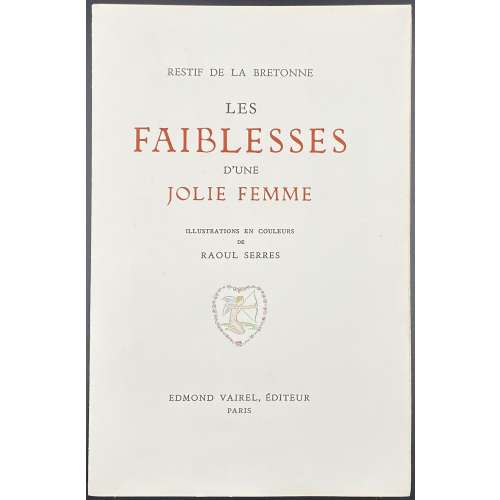 Title-page (red and black): RESTIF DE LA BRETONNE | LES | FAIBLESSES | D'UNE | JOLIE FEMME | ILLUSTRATIONS EN COULEURS | DE | RAOUL SERRES | {VIGNETTE} | EDMOND VAIREL, ÉDITEUR | PARIS || Description: 25.8 x 17 cm, French flapped wrappers lettered in red and black “LES | FAIBLESSES | D'UNE | JOLIE FEMME” in a 26 x 18 cm tan cloth double slipcase, [1-14] 15-175 [176] [8], collated in-8vo, with 25 colour in-text woodcut vignettes and two tailpieces at the end of each chapter, by Gérard Angiolini after watercolours by Raoul Serres. Published: April 18, 1951, in Paris. Edition: 1st thus, limited edition of 1,025 copies, of which this is № 904 of a common print run on Vélin de Rives paper (numbered 101-1,000). Contributors: Nicolas Restif de la Bretonne [Nicolas-Edme Rétif] (French, 1734 – 1806) – author. Raoul Serres [Schem] (French, 1881 – 1971) – artist. Gérard Angiolini (French, fl. 1946 – 1957) – engraver. Imprimerie Coulouma (Argenteuil), Robert Coulouma (French, 1887-1976) – printer. Edmond Vairel (French, 18… – 19...) – publisher, colourist.
Title-page (red and black): RESTIF DE LA BRETONNE | LES | FAIBLESSES | D'UNE | JOLIE FEMME | ILLUSTRATIONS EN COULEURS | DE | RAOUL SERRES | {VIGNETTE} | EDMOND VAIREL, ÉDITEUR | PARIS || Description: 25.8 x 17 cm, French flapped wrappers lettered in red and black “LES | FAIBLESSES | D'UNE | JOLIE FEMME” in a 26 x 18 cm tan cloth double slipcase, [1-14] 15-175 [176] [8], collated in-8vo, with 25 colour in-text woodcut vignettes and two tailpieces at the end of each chapter, by Gérard Angiolini after watercolours by Raoul Serres. Published: April 18, 1951, in Paris. Edition: 1st thus, limited edition of 1,025 copies, of which this is № 904 of a common print run on Vélin de Rives paper (numbered 101-1,000). Contributors: Nicolas Restif de la Bretonne [Nicolas-Edme Rétif] (French, 1734 – 1806) – author. Raoul Serres [Schem] (French, 1881 – 1971) – artist. Gérard Angiolini (French, fl. 1946 – 1957) – engraver. Imprimerie Coulouma (Argenteuil), Robert Coulouma (French, 1887-1976) – printer. Edmond Vairel (French, 18… – 19...) – publisher, colourist. -
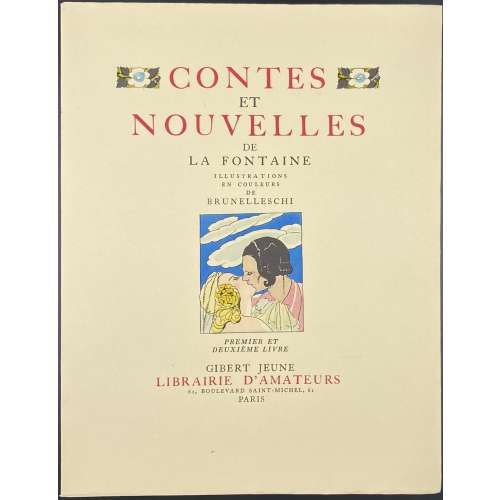 Vol. 1: Front wrapper and title page (in red and black): CONTES | ET | NOUVELLES | DE | LA FONTAINE | ILLUSTRATIONS | EN COULEURS | DE | BRUNELLESCHI | {vignette} | PREMIER ET DEUXIÈME LIVRE | GIBERT JEUNE | LIBRAIRIE D'AMATEURS | 61, BOULEVARD SAINT-MICHEL, 61 | PARIS || Pagination: [2] – blanks, [2] – h.t. / limit., [2] – t.p. / blank, [6] – advert., [2] – d.t.p., 1-164 [165-6], [4] – table, [2] – imprint / blank, [2] – blanks; total 188 pages (94 leaves) with 35 in-text black illustrations, plus 16 colour plates extraneous to collation, incl. frontispiece. Vol. 2: Front wrapper and title page similar to Vol. 1 but TROISIÈME, QUATRIÈME ET CINQUIÈME LIVRE under the vignette. Pagination: [2] – blanks, [2] – h.t. / limit., [2] – t.p. / blank, [2] – d.t.p., 1-233 [234], [4] – table, [2] – colophon / blank, [2] – blanks; total 250 pages (125 leaves) with 42 in-text black illustrations, plus 16 colour plates extraneous to collation, incl. frontispiece. Edition: Limited edition of 3,000 copies, this copy is № 1 (stamped in black in vol. 1). Printed on the 10th of June, 1938 by J. Dumoulin (H. Barthélemy – director, Louis Malexis – mise en page); stencil-colouring (au pochoir) by E. Charpentier under direction of the artist. Binding: Two volumes 26.3 x 20.3 cm, uniformly bound in publisher’s pictorial flapped wrappers with vignettes and lettering to front wrapper and spine and publisher’s device to back wrapper. Description of the stensil (au pochoir) technique.
Vol. 1: Front wrapper and title page (in red and black): CONTES | ET | NOUVELLES | DE | LA FONTAINE | ILLUSTRATIONS | EN COULEURS | DE | BRUNELLESCHI | {vignette} | PREMIER ET DEUXIÈME LIVRE | GIBERT JEUNE | LIBRAIRIE D'AMATEURS | 61, BOULEVARD SAINT-MICHEL, 61 | PARIS || Pagination: [2] – blanks, [2] – h.t. / limit., [2] – t.p. / blank, [6] – advert., [2] – d.t.p., 1-164 [165-6], [4] – table, [2] – imprint / blank, [2] – blanks; total 188 pages (94 leaves) with 35 in-text black illustrations, plus 16 colour plates extraneous to collation, incl. frontispiece. Vol. 2: Front wrapper and title page similar to Vol. 1 but TROISIÈME, QUATRIÈME ET CINQUIÈME LIVRE under the vignette. Pagination: [2] – blanks, [2] – h.t. / limit., [2] – t.p. / blank, [2] – d.t.p., 1-233 [234], [4] – table, [2] – colophon / blank, [2] – blanks; total 250 pages (125 leaves) with 42 in-text black illustrations, plus 16 colour plates extraneous to collation, incl. frontispiece. Edition: Limited edition of 3,000 copies, this copy is № 1 (stamped in black in vol. 1). Printed on the 10th of June, 1938 by J. Dumoulin (H. Barthélemy – director, Louis Malexis – mise en page); stencil-colouring (au pochoir) by E. Charpentier under direction of the artist. Binding: Two volumes 26.3 x 20.3 cm, uniformly bound in publisher’s pictorial flapped wrappers with vignettes and lettering to front wrapper and spine and publisher’s device to back wrapper. Description of the stensil (au pochoir) technique. -
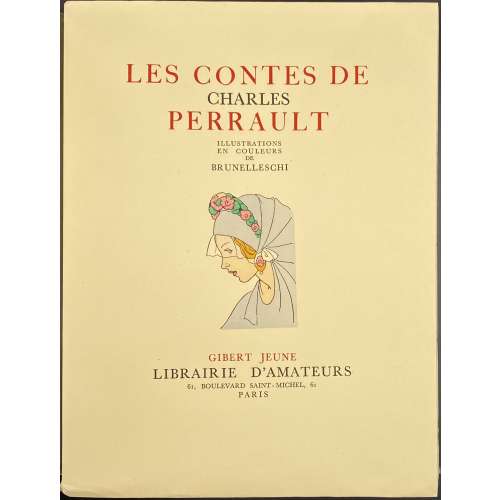 Front wrapper and title page (in red and black): LES CONTES DE | CHARLES | PERRAULT | ILLUSTRATIONS | EN COULEURS | DE | BRUNELLESCHI | {vignette} | GIBERT JEUNE | LIBRAIRIE D'AMATEURS | 61, BOULEVARD SAINT-MICHEL, 61 | PARIS || Pagination: [2] – blanks, [2] – h.t. / limit., [2] – t.p. / blank, [4] – preface, [2] – d.t.p., 1-168 [169-70], [4] – table, [2] – imprint / blank; total 188 pages (94 leaves) with 55 in-text illustrations, plus 16 colour plates extraneous to collation, incl. frontispiece. Edition: Limited edition of 1,000 copies, this copy is № 1 (stamped in black). Printed on the 31st of October 1946 by J. Dumoulin (H. Barthélemy – director, Louis Malexis – mise en page); stencil-colouring (au pochoir) by E. Charpentier under direction of the artist. Binding: 26.7 x 20.3 cm, publisher’s flapped pictorial wrappers, vignettes and lettering to front wrapper and spine, publisher’s device to back wrapper, uncut. Fairy Tales by Charles Perrault (French, 1628 – 1703): Griselidis (Griselda) — Peau d'Asne (Donkeyskin) — Les Souhaits ridicules (The Ridiculous Wishes) — La Belle au Bois dormant (Sleeping Beauty) — Le Petit Chaperon rouge (Little Red Riding Hood) — La Barbe-Bleue (Bluebeard) — Le Maistre Chat ou Le Chat Botté (Puss in Boots) — Les Fées (The Fairies) — Cendrillon ou La Petite Pantoufle de verre (Cinderella)— Riquet à la Houppe (Riquet with the Tuft) — Le Petit Poucet (Hop-o'-My-Thumb) Description of the stensil (au pochoir) technique.
Front wrapper and title page (in red and black): LES CONTES DE | CHARLES | PERRAULT | ILLUSTRATIONS | EN COULEURS | DE | BRUNELLESCHI | {vignette} | GIBERT JEUNE | LIBRAIRIE D'AMATEURS | 61, BOULEVARD SAINT-MICHEL, 61 | PARIS || Pagination: [2] – blanks, [2] – h.t. / limit., [2] – t.p. / blank, [4] – preface, [2] – d.t.p., 1-168 [169-70], [4] – table, [2] – imprint / blank; total 188 pages (94 leaves) with 55 in-text illustrations, plus 16 colour plates extraneous to collation, incl. frontispiece. Edition: Limited edition of 1,000 copies, this copy is № 1 (stamped in black). Printed on the 31st of October 1946 by J. Dumoulin (H. Barthélemy – director, Louis Malexis – mise en page); stencil-colouring (au pochoir) by E. Charpentier under direction of the artist. Binding: 26.7 x 20.3 cm, publisher’s flapped pictorial wrappers, vignettes and lettering to front wrapper and spine, publisher’s device to back wrapper, uncut. Fairy Tales by Charles Perrault (French, 1628 – 1703): Griselidis (Griselda) — Peau d'Asne (Donkeyskin) — Les Souhaits ridicules (The Ridiculous Wishes) — La Belle au Bois dormant (Sleeping Beauty) — Le Petit Chaperon rouge (Little Red Riding Hood) — La Barbe-Bleue (Bluebeard) — Le Maistre Chat ou Le Chat Botté (Puss in Boots) — Les Fées (The Fairies) — Cendrillon ou La Petite Pantoufle de verre (Cinderella)— Riquet à la Houppe (Riquet with the Tuft) — Le Petit Poucet (Hop-o'-My-Thumb) Description of the stensil (au pochoir) technique. -
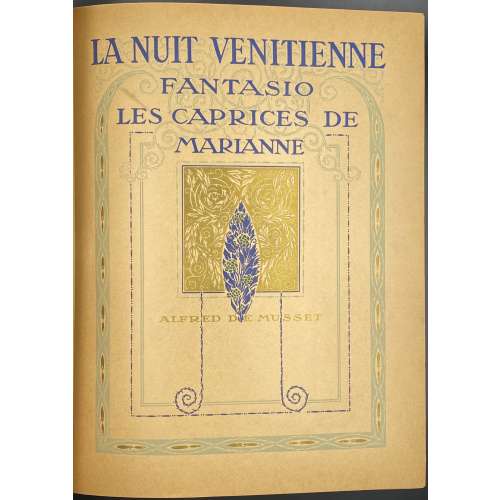 Collation: Prelims (pp.1-6): Blank leaf, front wrapper (ornamental, gilt and colour): LA NUIT VENITIENNE | FANTASIO | LES CAPRICES DE | MARIANNE | ALFRED DE MUSSET ||, blank leaf, [2] – h.t.: LA | NUIT VENITIENNE ||, [2] – t.p. (ornamental frame, marigold and reseda green): ALFRED DE MUSSET | LA NUIT | VENITIENNE | FANTASIA | LES CAPRICES | DE MARIANNE | ILLUSTRATIONS | DE | U. BRUNELLESCHI | L’EDITION D’ART H.PIAZZA | PARIS ||, [2] – ornamental divisional title: LA NUIT VENITIENNE ||, 7-138 [139/40] – contents / list of ills., [141-2] – limitation / colophon, blank leaf, back wrapper, blank leaf; plus 20 stencil-coloured (au pochoir) plates after gouaches by Umberto Brunelleschi, incl. frontispiece with red-lettered tissue guards; two more divisional titles, three headpieces in black; text printed on heavy wove paper, in an ornamental frame. Edition: 1st; limited to 500 copies on laid paper (papier du Japon) signed by the artist; this copy on wove paper without signatures, without limitation. Printed in Paris on the 10th of November 1913. Binding: 30 x 24 cm, owner’s green bead-grain buckram with a gilt-lettered black label to spine LA NUIT | VENITIENNE, publisher’s wrappers bound in, green and gilt endpapers. Alfred de Musset (French, 1810 – 1857) – author. Umberto Brunelleschi (Italian, 1879 – 1949) – artist. L’Edition d’art H. Piazza; Henri Jules Piazza (Italian, 1861 – 1929) – publisher, printer.
Collation: Prelims (pp.1-6): Blank leaf, front wrapper (ornamental, gilt and colour): LA NUIT VENITIENNE | FANTASIO | LES CAPRICES DE | MARIANNE | ALFRED DE MUSSET ||, blank leaf, [2] – h.t.: LA | NUIT VENITIENNE ||, [2] – t.p. (ornamental frame, marigold and reseda green): ALFRED DE MUSSET | LA NUIT | VENITIENNE | FANTASIA | LES CAPRICES | DE MARIANNE | ILLUSTRATIONS | DE | U. BRUNELLESCHI | L’EDITION D’ART H.PIAZZA | PARIS ||, [2] – ornamental divisional title: LA NUIT VENITIENNE ||, 7-138 [139/40] – contents / list of ills., [141-2] – limitation / colophon, blank leaf, back wrapper, blank leaf; plus 20 stencil-coloured (au pochoir) plates after gouaches by Umberto Brunelleschi, incl. frontispiece with red-lettered tissue guards; two more divisional titles, three headpieces in black; text printed on heavy wove paper, in an ornamental frame. Edition: 1st; limited to 500 copies on laid paper (papier du Japon) signed by the artist; this copy on wove paper without signatures, without limitation. Printed in Paris on the 10th of November 1913. Binding: 30 x 24 cm, owner’s green bead-grain buckram with a gilt-lettered black label to spine LA NUIT | VENITIENNE, publisher’s wrappers bound in, green and gilt endpapers. Alfred de Musset (French, 1810 – 1857) – author. Umberto Brunelleschi (Italian, 1879 – 1949) – artist. L’Edition d’art H. Piazza; Henri Jules Piazza (Italian, 1861 – 1929) – publisher, printer. -
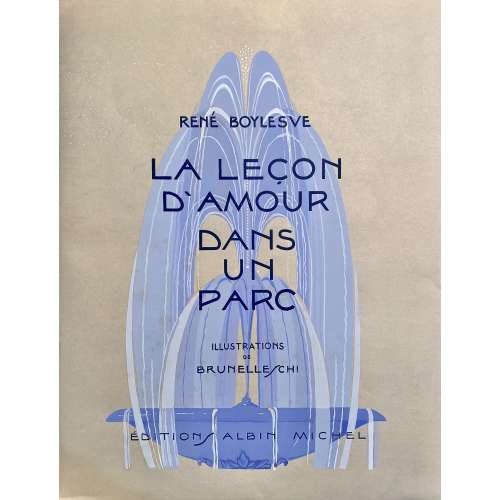 Title page (blue and black): RENE BOYLESVE | LA | LEÇON D'AMOUR | DANS UN PARC | ILLUSTRATIONS EN COULEURS | DE | BRUNELLESCHI | PARIS | ÉDITIONS ALBIN MICHEL | 22, RUE HUYGHENS (14e) || Pagination: [6] 1-173 [174] [4], total 184 pages, ils. Collation: publisher’s pictorial wrappers with 2 blank leaves – front and back, π2 (h.t. / justification, t.p. / blank), 87 leaves of text, [1] colophon / blank, total 92 leaves plus 21 plates, incl. frontispiece. Binding: 33.5 x 26 cm; original flapped wrappers, blue fountain and lettering to front, lettering to spine, back blank, in a marbled buckram folder (33.5 x 27 cm) with lettered paper label to spine; printed on Arches wove paper, margins untrimmed. Illustrations: 42 vignettes, tail- and headpieces in color, frontispiece and 20 plates after watercolours and gouaches by Umberto Brunelleschi printed in black and stencil-coloured (au pochoir) on the 18th of November 1933 at R. Coulouma press (Argenteuil), Jacomet press and Padovani press. Contributors: René Boylesve [Tardiveau] (French, 1867 – 1926) – author. Umberto Brunelleschi (Italian, 1879 – 1949) – artist. Daniel Jacomet (French, b. 1894 – ?) – printer. Imprimerie Coulouma (Argenteuil), Robert Coulouma (French, 1887-1976) – printer. Éditions Albin Michel (Paris) ; Albin Michel (French, 1873 – 1943) – publisher. First edition of René Boylesve's novel La Leçon d’amour dans un parc was conducted in Paris by Éditions de la Revue Blanche, in 1902. Description of the stensil (au pochoir) technique.
Title page (blue and black): RENE BOYLESVE | LA | LEÇON D'AMOUR | DANS UN PARC | ILLUSTRATIONS EN COULEURS | DE | BRUNELLESCHI | PARIS | ÉDITIONS ALBIN MICHEL | 22, RUE HUYGHENS (14e) || Pagination: [6] 1-173 [174] [4], total 184 pages, ils. Collation: publisher’s pictorial wrappers with 2 blank leaves – front and back, π2 (h.t. / justification, t.p. / blank), 87 leaves of text, [1] colophon / blank, total 92 leaves plus 21 plates, incl. frontispiece. Binding: 33.5 x 26 cm; original flapped wrappers, blue fountain and lettering to front, lettering to spine, back blank, in a marbled buckram folder (33.5 x 27 cm) with lettered paper label to spine; printed on Arches wove paper, margins untrimmed. Illustrations: 42 vignettes, tail- and headpieces in color, frontispiece and 20 plates after watercolours and gouaches by Umberto Brunelleschi printed in black and stencil-coloured (au pochoir) on the 18th of November 1933 at R. Coulouma press (Argenteuil), Jacomet press and Padovani press. Contributors: René Boylesve [Tardiveau] (French, 1867 – 1926) – author. Umberto Brunelleschi (Italian, 1879 – 1949) – artist. Daniel Jacomet (French, b. 1894 – ?) – printer. Imprimerie Coulouma (Argenteuil), Robert Coulouma (French, 1887-1976) – printer. Éditions Albin Michel (Paris) ; Albin Michel (French, 1873 – 1943) – publisher. First edition of René Boylesve's novel La Leçon d’amour dans un parc was conducted in Paris by Éditions de la Revue Blanche, in 1902. Description of the stensil (au pochoir) technique. -
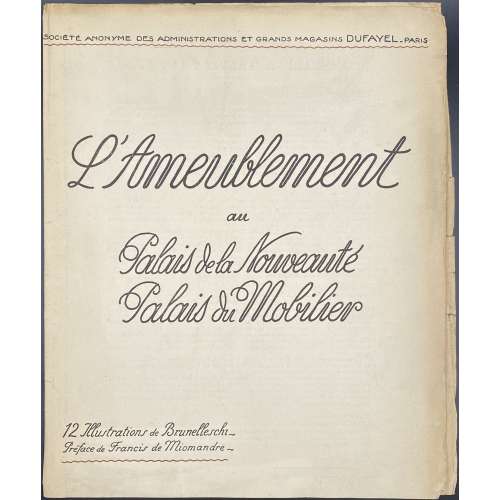 A set of 12 photomechanically reproduced illustrations after gouaches by Umberto Brunelleschi (Italian, 1879 – 1949), in colour; b/w photographs reproductions on verso, in a paper folder without the outer wrappers (b/w with birds, insects, and flowers). Text on the folder by French novelist Francis de Miomandre (French, 1880 – 1959); published by Grands Magasins Dufayel (1856 – 1930), a Parisian department store, run by Georges Dufayel (French, 1855 – 1916). Size: 29 x 24 cm. Images printed on cream paper within a beige frame, lettered above the frame in beige: "Societé Anonyme des Administrations et Grands Magasins DUFAYEL — Paris —", under the frame: "Palais de la Nouveauté ~ Palais du Mobilier | Entrée principale 7 Bould BARBES"; at the bottom of the frame lettered black on each image: Le Style Chinois, Le Style Empire, Le Style Japonais, Le Style Louis XIV, Le Style Louis XV, Le Style Louis XVI, Le Style Moderne (2), Le Style Moyen Age, Le Style Renaissance, Le Style Vénitien, Le Style Persian.
A set of 12 photomechanically reproduced illustrations after gouaches by Umberto Brunelleschi (Italian, 1879 – 1949), in colour; b/w photographs reproductions on verso, in a paper folder without the outer wrappers (b/w with birds, insects, and flowers). Text on the folder by French novelist Francis de Miomandre (French, 1880 – 1959); published by Grands Magasins Dufayel (1856 – 1930), a Parisian department store, run by Georges Dufayel (French, 1855 – 1916). Size: 29 x 24 cm. Images printed on cream paper within a beige frame, lettered above the frame in beige: "Societé Anonyme des Administrations et Grands Magasins DUFAYEL — Paris —", under the frame: "Palais de la Nouveauté ~ Palais du Mobilier | Entrée principale 7 Bould BARBES"; at the bottom of the frame lettered black on each image: Le Style Chinois, Le Style Empire, Le Style Japonais, Le Style Louis XIV, Le Style Louis XV, Le Style Louis XVI, Le Style Moderne (2), Le Style Moyen Age, Le Style Renaissance, Le Style Vénitien, Le Style Persian. -
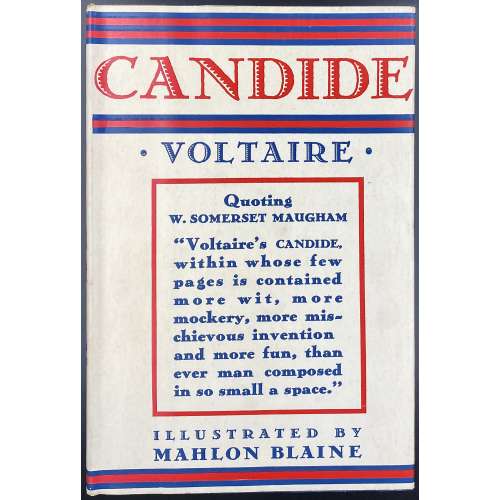 Title (chain border): CANDIDE | VOLTAIRE | ILLUSTRATIONS BY | MAHLON BLAINE | {vignette} | NEW YORK | Illustrated Editions Company | 220 FOURTH AVENUE || Title verso: (top) COPYRIGHT, 1930, BY WILLIAMS, BELASCO & MEYERS || (bottom) PRINTED IN THE UNITED STATES OF AMERICA | BY J. J. LITTLE & IVES COMPANY, NEW YORK || Pagination:[1-7] 8-144, headpiece, frontispiece and 5 plates after Blaine’s pen drawings, within the pagination; tailpieces by A. Zaidenberg. Binding: 21 x 14 cm; quarter beige buckram over blue cloth, stamped-gilt and red lettering and vignette to front board and spine. Binding in a way similar to Sterne's A sentimental journey published by Three Sirens Press in c. 1930 [LIB-2784.2021]. Not only that: tailpieces in this Illustrated Editions Company edition are the same as in Cameo Classic edition, with the only difference – here the name of the artist is stated, whether in the Cameo Classic it is not; see [LIB-2777.2021]. Bear in mind that Cameo Classic does not belong to Williams, Belasco and Meyers, it is a Grosset and Dunlap series; a cream dust-jacket lettered in red and blue, and with a citation from W. Somerset Maugham; all edges red. Compare with LIB-2791.2021. Illustrations in the current copy are exactly the same. Compare Williams, Belasco and Meyers Candide and Illustrated Editions Company Candide title pages:
Title (chain border): CANDIDE | VOLTAIRE | ILLUSTRATIONS BY | MAHLON BLAINE | {vignette} | NEW YORK | Illustrated Editions Company | 220 FOURTH AVENUE || Title verso: (top) COPYRIGHT, 1930, BY WILLIAMS, BELASCO & MEYERS || (bottom) PRINTED IN THE UNITED STATES OF AMERICA | BY J. J. LITTLE & IVES COMPANY, NEW YORK || Pagination:[1-7] 8-144, headpiece, frontispiece and 5 plates after Blaine’s pen drawings, within the pagination; tailpieces by A. Zaidenberg. Binding: 21 x 14 cm; quarter beige buckram over blue cloth, stamped-gilt and red lettering and vignette to front board and spine. Binding in a way similar to Sterne's A sentimental journey published by Three Sirens Press in c. 1930 [LIB-2784.2021]. Not only that: tailpieces in this Illustrated Editions Company edition are the same as in Cameo Classic edition, with the only difference – here the name of the artist is stated, whether in the Cameo Classic it is not; see [LIB-2777.2021]. Bear in mind that Cameo Classic does not belong to Williams, Belasco and Meyers, it is a Grosset and Dunlap series; a cream dust-jacket lettered in red and blue, and with a citation from W. Somerset Maugham; all edges red. Compare with LIB-2791.2021. Illustrations in the current copy are exactly the same. Compare Williams, Belasco and Meyers Candide and Illustrated Editions Company Candide title pages: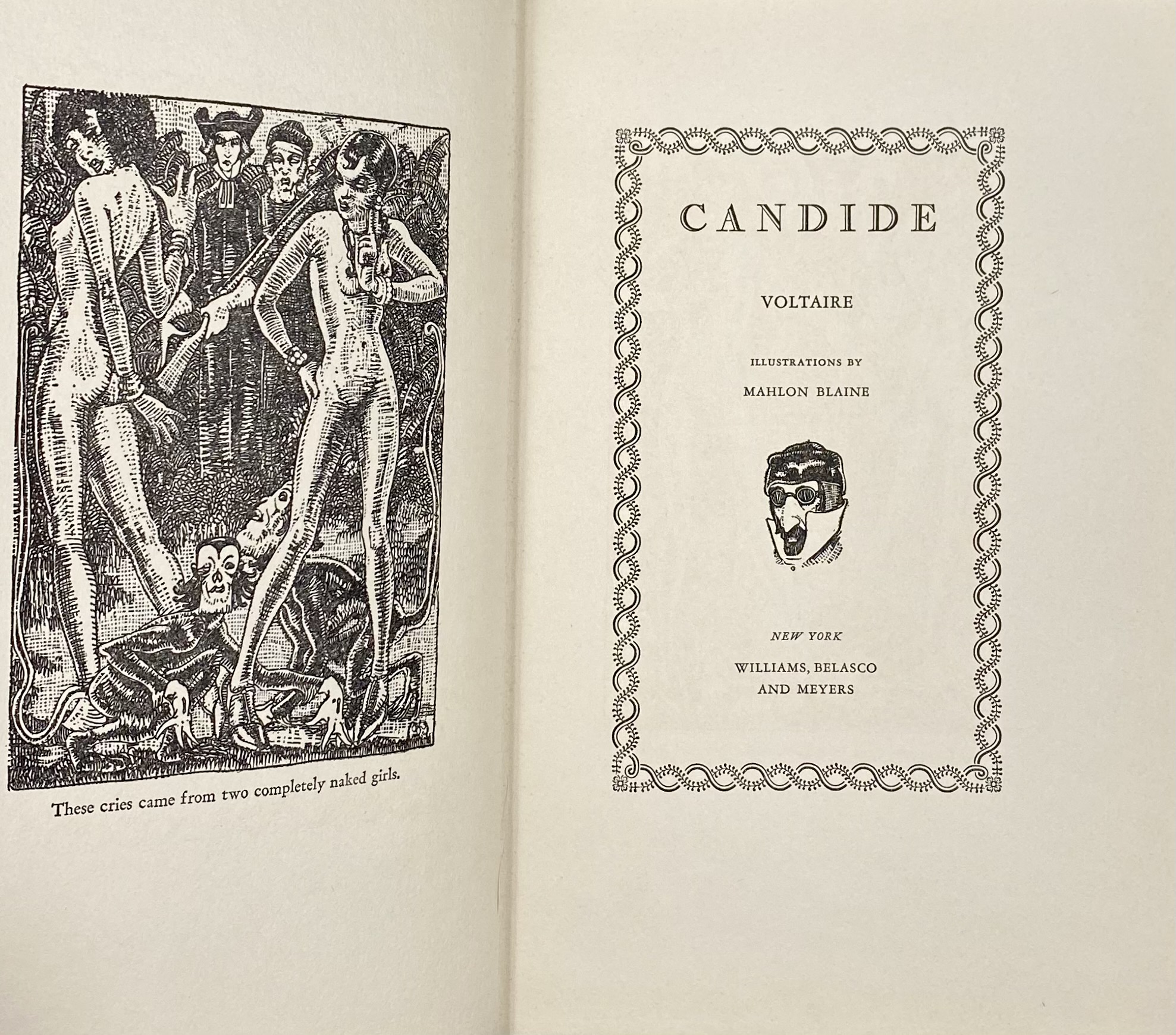
Williams, Belasco and Meyers
Arouet, François-Marie [Voltaire] (French, 1694 – 1778)– author. Woolf, Herman Irwell [Chambers, Dorset] (British, 1890 – 1958) – translator. Blaine, Mahlon [Hudson, G. Christopher] (American, 1894 – 1969) – illustrator. Zaidenberg, Arthur (American, 1902 – 1990) – illustrator. Williams, Belasco and Meyers (NY) – copyright holder. Illustrated Editions Company (1929-1942) – publisher. J. J. Little & Ives Company (NY) – printer. See the Cameo Classic reprint [LIB-2777.2021].
Illustrated Editions Company
-
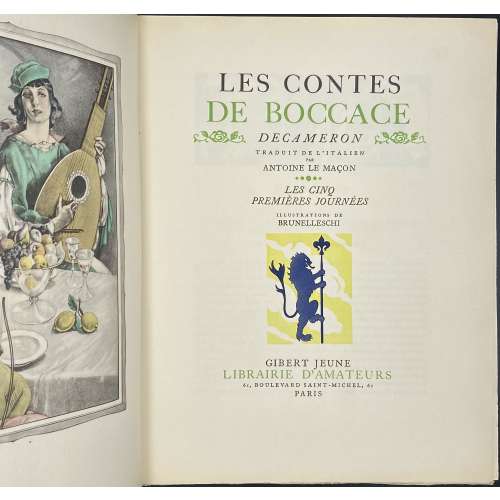 Vol. 1: Front cover and title page: LES CONTES | DE BOCCACE | ☙ DECAMERON ❧ | TRADUIT DE L'ITALIEN | PAR | ANTOINE LE MAÇON | LES CINQ | PREMIÈRES JOURNÉES | ILLUSTRATIONS DE | BRUNELLESCHI | {vignette} | GIBERT JEUNE | LIBRAIRIE D'AMATEURS | 61, BOULEVARD SAINT-MICHEL, 61 | PARIS || Pagination: [6] 1-342 [343-4] [10], 16 colour plates and 70 b/w head- and tailpieces after Umberto Brunelleschi. Vol. 2: Front cover and title page: LES CONTES | DE BOCCACE | ☙ DECAMERON ❧ | TRADUIT DE L'ITALIEN | PAR | ANTOINE LE MAÇON | LES CINQ | DERNIÈRES JOURNÉES | ILLUSTRATIONS DE | BRUNELLESCHI | {vignette} | GIBERT JEUNE | LIBRAIRIE D'AMATEURS | 61, BOULEVARD SAINT-MICHEL, 61 | PARIS || Pagination: [6] 1-281 [282] [10], 16 colour plates and 68 b/w head- and tailpieces after Umberto Brunelleschi. Edition: Limited to 2,500 copies, of which this is № 1. Edition supplemented with two full extra sets of plates, 32 in black and white, and 32 in colour. Printed on June 25, 1934. Binding: 26.5 x 20.5 cm; cream flapped wrappers (French softcover) with green and black lettering and vignettes to front cover and spine, publisher’s device on the back; uncut copy. Paper: Vélin de Navarre (wove paper), size: 260 x 200 mm. Contributors: Giovanni Boccaccio (Italian, 1313 – 1375) – author. Antoine Le Maçon (French, c. 1500 – 1559) – translator. Umberto Brunelleschi (Italian, 1879 – 1949) – artist. Malexis, Louis (French, 20 century) – mise en page. Coulouma, Robert (French, 1887 – 1976), Imprimerie Coulouma (Argenteuil) – printer, H. Barthélemy – director. Dantan, A. – engraver (probably from the family of Edouard Joseph Dantan (French, 1848 – 1897) Charpentier, E. – colour au pochoir. Compare this copy with a small one-volume reprint of 1941: [LIB-2773.2021]. Description of the stensil (au pochoir) technique.
Vol. 1: Front cover and title page: LES CONTES | DE BOCCACE | ☙ DECAMERON ❧ | TRADUIT DE L'ITALIEN | PAR | ANTOINE LE MAÇON | LES CINQ | PREMIÈRES JOURNÉES | ILLUSTRATIONS DE | BRUNELLESCHI | {vignette} | GIBERT JEUNE | LIBRAIRIE D'AMATEURS | 61, BOULEVARD SAINT-MICHEL, 61 | PARIS || Pagination: [6] 1-342 [343-4] [10], 16 colour plates and 70 b/w head- and tailpieces after Umberto Brunelleschi. Vol. 2: Front cover and title page: LES CONTES | DE BOCCACE | ☙ DECAMERON ❧ | TRADUIT DE L'ITALIEN | PAR | ANTOINE LE MAÇON | LES CINQ | DERNIÈRES JOURNÉES | ILLUSTRATIONS DE | BRUNELLESCHI | {vignette} | GIBERT JEUNE | LIBRAIRIE D'AMATEURS | 61, BOULEVARD SAINT-MICHEL, 61 | PARIS || Pagination: [6] 1-281 [282] [10], 16 colour plates and 68 b/w head- and tailpieces after Umberto Brunelleschi. Edition: Limited to 2,500 copies, of which this is № 1. Edition supplemented with two full extra sets of plates, 32 in black and white, and 32 in colour. Printed on June 25, 1934. Binding: 26.5 x 20.5 cm; cream flapped wrappers (French softcover) with green and black lettering and vignettes to front cover and spine, publisher’s device on the back; uncut copy. Paper: Vélin de Navarre (wove paper), size: 260 x 200 mm. Contributors: Giovanni Boccaccio (Italian, 1313 – 1375) – author. Antoine Le Maçon (French, c. 1500 – 1559) – translator. Umberto Brunelleschi (Italian, 1879 – 1949) – artist. Malexis, Louis (French, 20 century) – mise en page. Coulouma, Robert (French, 1887 – 1976), Imprimerie Coulouma (Argenteuil) – printer, H. Barthélemy – director. Dantan, A. – engraver (probably from the family of Edouard Joseph Dantan (French, 1848 – 1897) Charpentier, E. – colour au pochoir. Compare this copy with a small one-volume reprint of 1941: [LIB-2773.2021]. Description of the stensil (au pochoir) technique. -
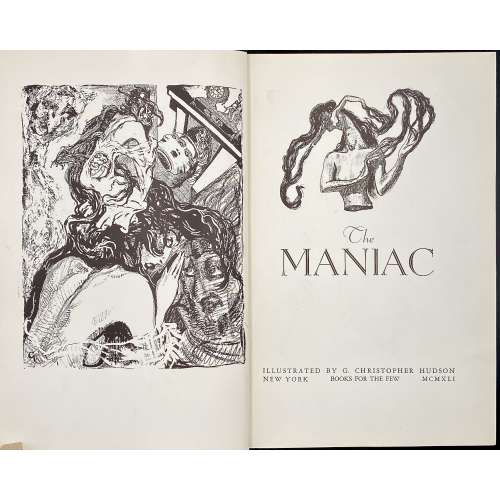 Title page: {vignette} | The | MANIAC | ILLUSTRATED BY G. CHRISTOPHER HUDSON | NEW YORK BOOKS FOR THE FEW MCMXLI || Pagination: [1-6] 7-245 [246], full-page plates and in-text vignettes after Mahlon Blaine drawings. Edition: Limited edition of 1050 copies, this one unnumbered. Text – a reprint of the 1909 edition by Rebman (London); 1st edition, thus. Binding: 24 x 16 cm, black moire cloth, green label with black lettering “THE | MANIAC” to spine. Ink stamp “Charles M. Collins, Jr” to front pastedown. Contributors: E. Thelmar (British, fl. c. 1909) – author; a British journalist, who had been committed to an asylum in 1905; nothing else is known. G. Christopher Hudson [Mahlon Blaine] (American, 1894 – 1969) – artist. Books for the Few (NY) – publisher. Ref: TAYLOR, NICK. “Mahlon Blaine, John Steinbeck, and ‘The Maniac’ (1941).” The Steinbeck Review 9, no. 1 (2012): 73–84. http://www.jstor.org/stable/41582924.
Title page: {vignette} | The | MANIAC | ILLUSTRATED BY G. CHRISTOPHER HUDSON | NEW YORK BOOKS FOR THE FEW MCMXLI || Pagination: [1-6] 7-245 [246], full-page plates and in-text vignettes after Mahlon Blaine drawings. Edition: Limited edition of 1050 copies, this one unnumbered. Text – a reprint of the 1909 edition by Rebman (London); 1st edition, thus. Binding: 24 x 16 cm, black moire cloth, green label with black lettering “THE | MANIAC” to spine. Ink stamp “Charles M. Collins, Jr” to front pastedown. Contributors: E. Thelmar (British, fl. c. 1909) – author; a British journalist, who had been committed to an asylum in 1905; nothing else is known. G. Christopher Hudson [Mahlon Blaine] (American, 1894 – 1969) – artist. Books for the Few (NY) – publisher. Ref: TAYLOR, NICK. “Mahlon Blaine, John Steinbeck, and ‘The Maniac’ (1941).” The Steinbeck Review 9, no. 1 (2012): 73–84. http://www.jstor.org/stable/41582924. -
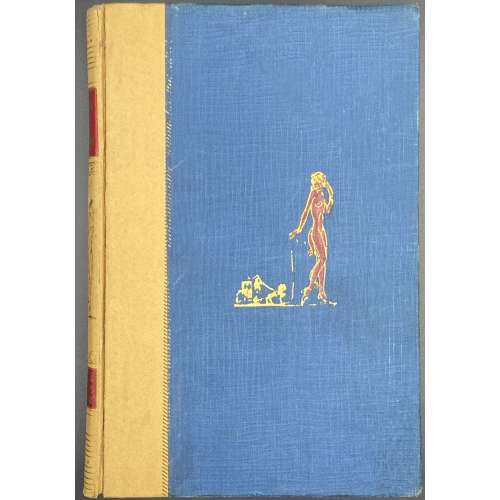 Title (chain border): CANDIDE | VOLTAIRE | ILLUSTRATIONS BY | MAHLON BLAINE | {vignette} | NEW YORK | Illustrated Editions Company | 220 FOURTH AVENUE || Title verso: (top) COPYRIGHT, 1930, BY WILLIAMS, BELASCO & MEYERS || (bottom) PRINTED IN THE UNITED STATES OF AMERICA | BY J. J. LITTLE & IVES COMPANY, NEW YORK || Pagination:[1-10] 11-144, headpiece, frontispiece and 5 plates after Blaine’s pen drawings, within the pagination; tailpieces by A. Zaidenberg. Binding: 21 x 14 cm; quarter beige buckram over blue cloth, stamped-gilt and red lettering and vignette to front board and spine. Binding in a way similar to Sterne's A sentimental journey published by Three Sirens Press in c. 1930 [LIB-2784.2021]. Not only that: tailpieces in this Illustrated Editions Company edition are the same as in Cameo Classic edition, with the only difference – here the name of the artist is stated, whether in the Cameo Classic it is not; see [LIB-2777.2021]. Bear in mind that Cameo Classic does not belong to Williams, Belasco and Meyers, it is a Grosset and Dunlap series. Compare Williams, Belasco and Meyers Candide and Illustrated Editions Company Candide title pages:
Title (chain border): CANDIDE | VOLTAIRE | ILLUSTRATIONS BY | MAHLON BLAINE | {vignette} | NEW YORK | Illustrated Editions Company | 220 FOURTH AVENUE || Title verso: (top) COPYRIGHT, 1930, BY WILLIAMS, BELASCO & MEYERS || (bottom) PRINTED IN THE UNITED STATES OF AMERICA | BY J. J. LITTLE & IVES COMPANY, NEW YORK || Pagination:[1-10] 11-144, headpiece, frontispiece and 5 plates after Blaine’s pen drawings, within the pagination; tailpieces by A. Zaidenberg. Binding: 21 x 14 cm; quarter beige buckram over blue cloth, stamped-gilt and red lettering and vignette to front board and spine. Binding in a way similar to Sterne's A sentimental journey published by Three Sirens Press in c. 1930 [LIB-2784.2021]. Not only that: tailpieces in this Illustrated Editions Company edition are the same as in Cameo Classic edition, with the only difference – here the name of the artist is stated, whether in the Cameo Classic it is not; see [LIB-2777.2021]. Bear in mind that Cameo Classic does not belong to Williams, Belasco and Meyers, it is a Grosset and Dunlap series. Compare Williams, Belasco and Meyers Candide and Illustrated Editions Company Candide title pages:
Williams, Belasco and Meyers
Arouet, François-Marie [Voltaire] (French, 1694 – 1778)– author. Woolf, Herman Irwell [Chambers, Dorset] (British, 1890 – 1958) – translator. Blaine, Mahlon [Hudson, G. Christopher] (American, 1894 – 1969) – illustrator. Zaidenberg, Arthur (American, 1902 – 1990) – illustrator. Williams, Belasco and Meyers (NY) – copyright holder. Illustrated Editions Company (1929-1942) – publisher. J. J. Little & Ives Company (NY) – printer. See the Cameo Classic reprint [LIB-2777.2021].
Illustrated Editions Company
-
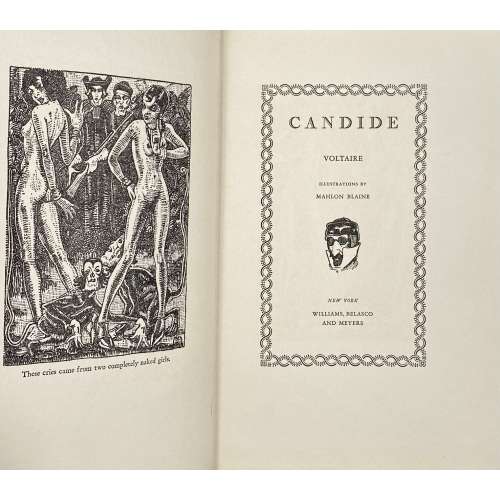 Title (chain border): CANDIDE | VOLTAIRE | ILLUSTRATIONS BY | MAHLON BLAINE | {vignette} | NEW YORK | WILLIAMS, BELASCO | AND MEYERS || Title verso: (top) COPYRIGHT, 1930, BY WILLIAMS, BELASCO & MEYERS || (bottom) PRINTED IN THE UNITED STATES OF AMERICA | BY J. J. LITTLE & IVES COMPANY, NEW YORK || Pagination:[1-6] 7-144, headpiece, frontispiece and 5 plates after Blaine’s pen drawings, within the pagination. Binding: 25 x 16.5 cm; blue cloth, blind-stamped frame, stamped-gilt lettering to front board and spine, thick wove paper, upper edge blue, fore-edge untrimmed, yellow vergé endpapers. Arouet, François-Marie [Voltaire] (French, 1694 – 1778)– author. Woolf, Herman Irwell [Chambers, Dorset] (British, 1890 – 1958) – translator. Blaine, Mahlon [Hudson, G. Christopher] (American, 1894 – 1969) – illustrator. Williams, Belasco and Meyers (NY) – publisher. J. J. Little & Ives Company (NY) – printer. See the Cameo Classic reprint [LIB-2777.2021].
Title (chain border): CANDIDE | VOLTAIRE | ILLUSTRATIONS BY | MAHLON BLAINE | {vignette} | NEW YORK | WILLIAMS, BELASCO | AND MEYERS || Title verso: (top) COPYRIGHT, 1930, BY WILLIAMS, BELASCO & MEYERS || (bottom) PRINTED IN THE UNITED STATES OF AMERICA | BY J. J. LITTLE & IVES COMPANY, NEW YORK || Pagination:[1-6] 7-144, headpiece, frontispiece and 5 plates after Blaine’s pen drawings, within the pagination. Binding: 25 x 16.5 cm; blue cloth, blind-stamped frame, stamped-gilt lettering to front board and spine, thick wove paper, upper edge blue, fore-edge untrimmed, yellow vergé endpapers. Arouet, François-Marie [Voltaire] (French, 1694 – 1778)– author. Woolf, Herman Irwell [Chambers, Dorset] (British, 1890 – 1958) – translator. Blaine, Mahlon [Hudson, G. Christopher] (American, 1894 – 1969) – illustrator. Williams, Belasco and Meyers (NY) – publisher. J. J. Little & Ives Company (NY) – printer. See the Cameo Classic reprint [LIB-2777.2021]. -
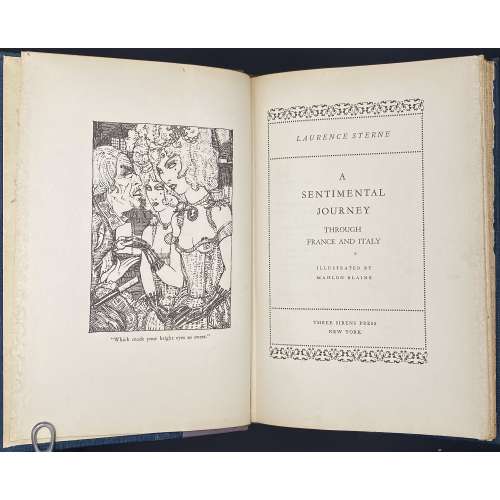 Title page (frame, three compartments: LAURENCE STERNE |—| A | SENTIMENTAL | JOURNEY | THROUGH | FRANCE AND ITALY | ILLUSTRATED BY | MAHLON BLAINE |—| THREE SIRENS PRESS | NEW YORK || Title verso: (top) COPYRIGHT, 1930, BY WILLIAMS, BELASCO & MEYERS | PRINTED IN THE UNITED STATES OF AMERICA | (bottom) BY J. J. LITTLE & IVES COMPANY, NEW YORK || Pagination: [1-6] 7-192, frontispiece, headpiece, and 4 plates within collation (pp. 45, 85, 141, and 185) after Blaine’s pen drawings in the woodcut manner. Binding: quarter lilac morocco with stamped brown lettering over blue cloth, design elements and lettering to spine, top edge gilt, fore-edge untrimmed. Size: 24.5 x 16 cm Edition: presumably 1st edition with plates after Blaine. Contributors: Sterne, Laurence (British-Irish, 1713 – 1768) – author of the text. Blaine, Mahlon (American, 1894 – 1969) – illustrator (pseudonym: G. Christopher Hudson). Three Sirens Press (NY); Williams, Belasco, and Meyers (NY) – publishers. J. J. Little & Ives Company (NY) – printer. Compare to the re-printed edition by Halcyon House, [c. 1950] in the collection [LIB-2783.2021].
Title page (frame, three compartments: LAURENCE STERNE |—| A | SENTIMENTAL | JOURNEY | THROUGH | FRANCE AND ITALY | ILLUSTRATED BY | MAHLON BLAINE |—| THREE SIRENS PRESS | NEW YORK || Title verso: (top) COPYRIGHT, 1930, BY WILLIAMS, BELASCO & MEYERS | PRINTED IN THE UNITED STATES OF AMERICA | (bottom) BY J. J. LITTLE & IVES COMPANY, NEW YORK || Pagination: [1-6] 7-192, frontispiece, headpiece, and 4 plates within collation (pp. 45, 85, 141, and 185) after Blaine’s pen drawings in the woodcut manner. Binding: quarter lilac morocco with stamped brown lettering over blue cloth, design elements and lettering to spine, top edge gilt, fore-edge untrimmed. Size: 24.5 x 16 cm Edition: presumably 1st edition with plates after Blaine. Contributors: Sterne, Laurence (British-Irish, 1713 – 1768) – author of the text. Blaine, Mahlon (American, 1894 – 1969) – illustrator (pseudonym: G. Christopher Hudson). Three Sirens Press (NY); Williams, Belasco, and Meyers (NY) – publishers. J. J. Little & Ives Company (NY) – printer. Compare to the re-printed edition by Halcyon House, [c. 1950] in the collection [LIB-2783.2021].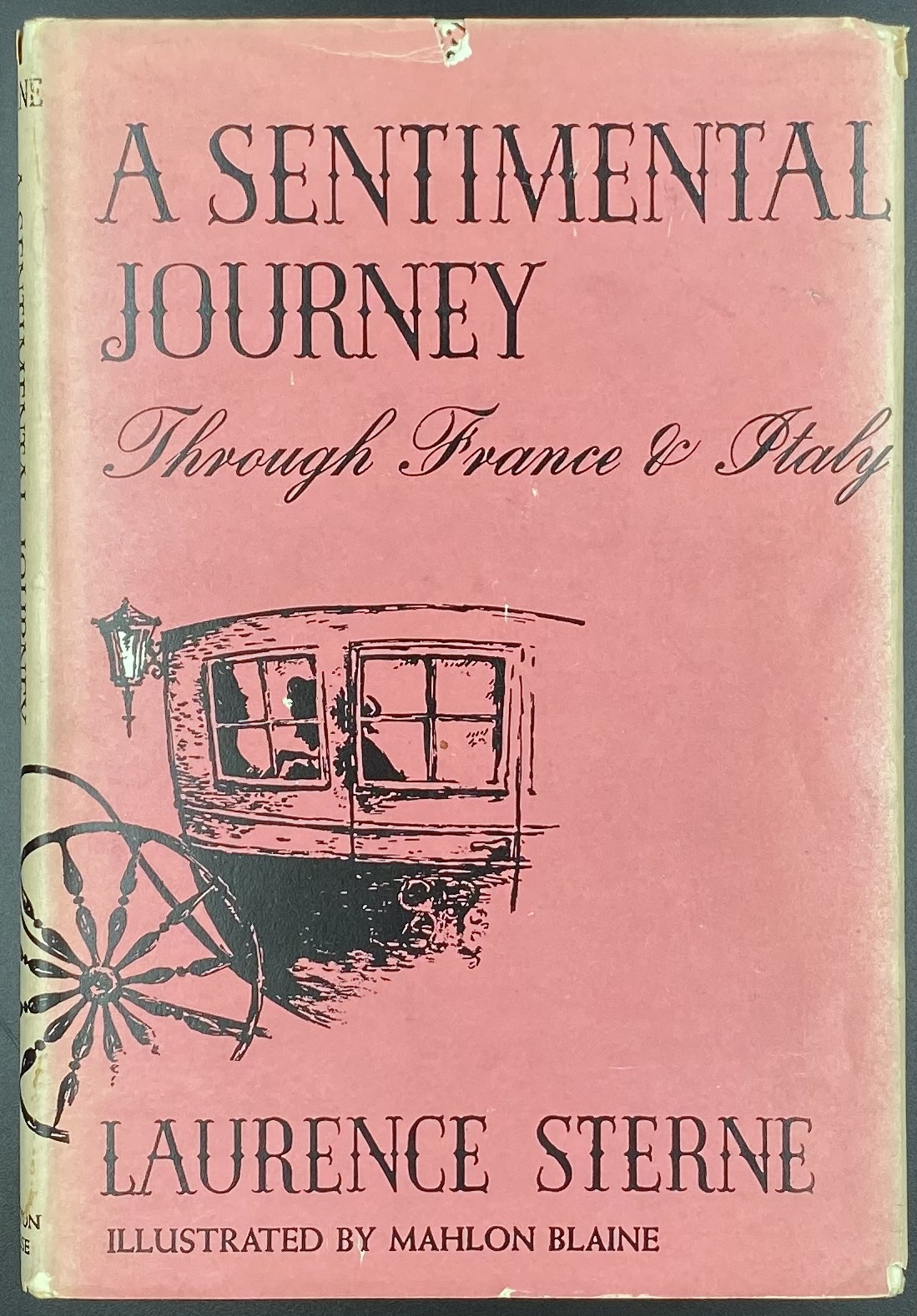 As stated, the copyright is held by Williams, Belasco, and Meyers, who are: Joseph Meyers (c. 1898 – 1957), his sister Edna Williams, and David Belasco (1853 – 1931). "Joseph Meyers was described by Bennet Cerf (Modern Library, Random House) as a “notorious pirate” in Gertzman’s book Bookleggers and Smuthounds, and the trio of presses allegedly indulged in reprinting numerous books without holding the copyright to those titles. By not paying copyright fees, Meyers and Williams were able to print and sell good quality illustrated books at prices that were below typical smaller, unillustrated reprint series of the 1930s." [cit.]
As stated, the copyright is held by Williams, Belasco, and Meyers, who are: Joseph Meyers (c. 1898 – 1957), his sister Edna Williams, and David Belasco (1853 – 1931). "Joseph Meyers was described by Bennet Cerf (Modern Library, Random House) as a “notorious pirate” in Gertzman’s book Bookleggers and Smuthounds, and the trio of presses allegedly indulged in reprinting numerous books without holding the copyright to those titles. By not paying copyright fees, Meyers and Williams were able to print and sell good quality illustrated books at prices that were below typical smaller, unillustrated reprint series of the 1930s." [cit.]
-
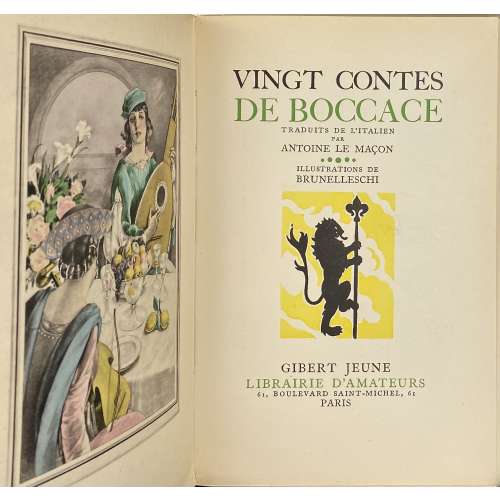 Cover and title, in green and black: VINGT CONTES | DE BOCCACE / TRADUITS DE L’ITALIEN |PAR | ANTOINE LE MAÇON | ILLUSTRATIONS DE | BRUNELLESCHI | {vignette} | GIBERT JEUNE | LIBRAIRIE D’AMATEURS | 61, BOULEVARD SAINT-MICHEL, 61 | PARIS || Pagination : [4] 1-165 [7] with 19 black head- and tailpieces, plus 16 colour plates extraneous to collation, incl. frontispiece, printed by J. Dumoulin and stencil-coloured (au pochoir) by E. Charpentier after gouache and watercolour drawings by Umberto Brunelleschi, plus 2 blank flyleaves; total 106 leaves. Limited edition of 3,000 copies, this is № 1630. Printed by Louis Malexis at Imprimerie J. Dumoulin, Paris (H. Barthélemy, director) on May 28, 1941. Binding: 20.5 x 13.5 cm, publisher’s pictorial wrappers, vignettes and lettering to front wrapper and spine, publisher’s device to back wrapper. Contributors: Giovanni Boccaccio (Italian, 1313 – 1375) – author Antoine Le Maçon (French, c. 1500 – 1559) – translator Umberto Brunelleschi (Italian, 1879 – 1949) – artist Joseph Dumoulin (French, 1875 – 1953) – printer The first, 2-volume limited edition (2,500 copies) of Les Contes de Boccace Decameron (les cinq premières journées, les cinq dernières journées) was published by Gibert Jeune, Librairie d’Amateurs in 1934 with 70 black and 32 colour designs after Brunelleschi – see [LIB-2813.2021]. Description of the stensil (au pochoir) technique.
Cover and title, in green and black: VINGT CONTES | DE BOCCACE / TRADUITS DE L’ITALIEN |PAR | ANTOINE LE MAÇON | ILLUSTRATIONS DE | BRUNELLESCHI | {vignette} | GIBERT JEUNE | LIBRAIRIE D’AMATEURS | 61, BOULEVARD SAINT-MICHEL, 61 | PARIS || Pagination : [4] 1-165 [7] with 19 black head- and tailpieces, plus 16 colour plates extraneous to collation, incl. frontispiece, printed by J. Dumoulin and stencil-coloured (au pochoir) by E. Charpentier after gouache and watercolour drawings by Umberto Brunelleschi, plus 2 blank flyleaves; total 106 leaves. Limited edition of 3,000 copies, this is № 1630. Printed by Louis Malexis at Imprimerie J. Dumoulin, Paris (H. Barthélemy, director) on May 28, 1941. Binding: 20.5 x 13.5 cm, publisher’s pictorial wrappers, vignettes and lettering to front wrapper and spine, publisher’s device to back wrapper. Contributors: Giovanni Boccaccio (Italian, 1313 – 1375) – author Antoine Le Maçon (French, c. 1500 – 1559) – translator Umberto Brunelleschi (Italian, 1879 – 1949) – artist Joseph Dumoulin (French, 1875 – 1953) – printer The first, 2-volume limited edition (2,500 copies) of Les Contes de Boccace Decameron (les cinq premières journées, les cinq dernières journées) was published by Gibert Jeune, Librairie d’Amateurs in 1934 with 70 black and 32 colour designs after Brunelleschi – see [LIB-2813.2021]. Description of the stensil (au pochoir) technique. -
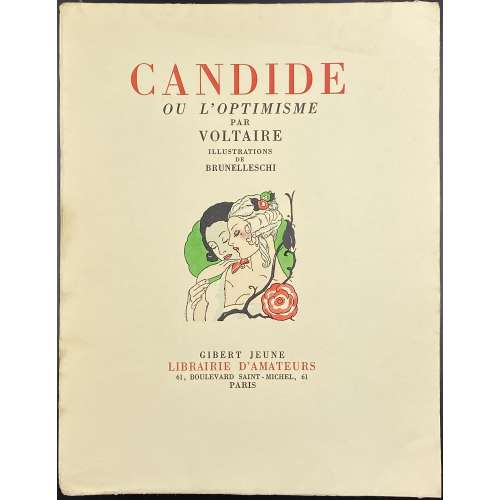 Title (in red and black): CANDIDE | OU L'OPTIMISME | PAR | VOLTAIRE | ILLUSTRATIONS | DE | BRUNELLESCHI | {vignette} | GIBERT JEUNE | LIBRAIRIE D'AMATEURS | 61, BOULEVARD SAINT-MICHEL, 61 | PARIS || Pagination : [6] 1-163 [164][2], with 23 black tailpieces, plus 16 colour plates extraneous to collation, incl. frontispiece, printed by A. Dantan and stencil-coloured (au pochoir) by E. Charpentier after gouache and watercolour drawings by Umberto Brunelleschi; total 102 leaves. Limited edition of 2500 copies, this is № 39. Printed at Imprimerie Coulouma, Argenteuil (H. Barthélemy, director) on July 15, 1933. Binding: 26.5 x 20.5 cm, publisher’s pictorial wrappers, vignettes and lettering to front wrapper and spine, publisher’s device to back wrapper. Description of the stensil (au pochoir) technique.
Title (in red and black): CANDIDE | OU L'OPTIMISME | PAR | VOLTAIRE | ILLUSTRATIONS | DE | BRUNELLESCHI | {vignette} | GIBERT JEUNE | LIBRAIRIE D'AMATEURS | 61, BOULEVARD SAINT-MICHEL, 61 | PARIS || Pagination : [6] 1-163 [164][2], with 23 black tailpieces, plus 16 colour plates extraneous to collation, incl. frontispiece, printed by A. Dantan and stencil-coloured (au pochoir) by E. Charpentier after gouache and watercolour drawings by Umberto Brunelleschi; total 102 leaves. Limited edition of 2500 copies, this is № 39. Printed at Imprimerie Coulouma, Argenteuil (H. Barthélemy, director) on July 15, 1933. Binding: 26.5 x 20.5 cm, publisher’s pictorial wrappers, vignettes and lettering to front wrapper and spine, publisher’s device to back wrapper. Description of the stensil (au pochoir) technique. -
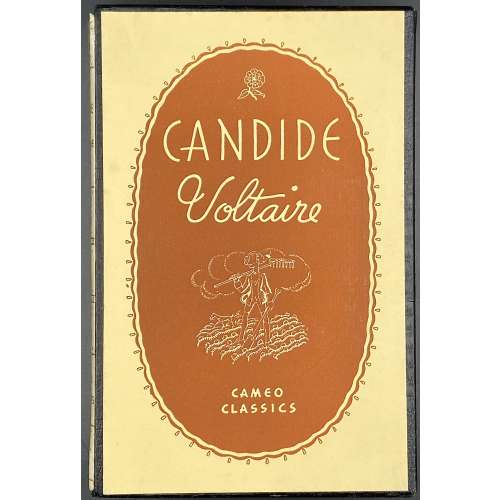 Title (historiated border, three-compartment): CAMEO CLASSICS | {rule} | CANDIDE | BY | Voltaire | WITH ILLUSTRATIONS | BY | Mahlon Blaine | {rule} | GROSSET AND DUNLAP | NEW YORK || Pagination: [1-6] 7-144, total 144 pages; frontispiece plus 4 plates within collation, head- and tailpieces – reproductions of Mahlon Blaine’s pen drawings. Binding: 21 x 14 cm, cream cloth with the cameo of Johann Gutenberg to front cover, gilt lettering to front cover and spine, in acetate dust jacket, in a pictorial slipcase. Arouet, François-Marie [Voltaire] (French, 1694 – 1778)– author. Woolf, Herman Irwell [Chambers, Dorset] (British, 1890 – 1958) – translator. Blaine, Mahlon [Hudson, G. Christopher] (American, 1894 – 1969) – illustrator. Grosset and Dunlap (NY) – publisher. J. J. Little & Ives Company (NY) – printer. Cameo Classics series was published by Grosset & Dunlap (New York) in 1935 – 1948 as a cheap reprint of illustrated classic editions, in this case – of Williams, Belasco and Meyers publication of Candide in 1930 (see LIB-2792.2021). The Cameo Classics books had a clear, acetate dust jacket and were boxed in a buckram alligator skin patterned slipcase with an illustrated cover. The price per volume started at 69 cents and was gradually lowered to 59 and 50 cents per volume by the late 1930s. Candide was translated into English quite a few times, starting from Tobias George Smollett (British-Scottish, 1721 – 1771) and up to today's translators. For some reason, the translator's name is almost never indicated. This translation, published by Williams, Belasco and Meyers in 1930 and reprinted by Grosset and Dunlap in c. 1935, was performed by Herman Irwell Woolf under the pseudonym of Dorset Chambers and first published in London by F.B. Neumayer in 1919. This edition was mentioned in the letter from Joseph Conrad to his son Borys in 1922, May 10.
Title (historiated border, three-compartment): CAMEO CLASSICS | {rule} | CANDIDE | BY | Voltaire | WITH ILLUSTRATIONS | BY | Mahlon Blaine | {rule} | GROSSET AND DUNLAP | NEW YORK || Pagination: [1-6] 7-144, total 144 pages; frontispiece plus 4 plates within collation, head- and tailpieces – reproductions of Mahlon Blaine’s pen drawings. Binding: 21 x 14 cm, cream cloth with the cameo of Johann Gutenberg to front cover, gilt lettering to front cover and spine, in acetate dust jacket, in a pictorial slipcase. Arouet, François-Marie [Voltaire] (French, 1694 – 1778)– author. Woolf, Herman Irwell [Chambers, Dorset] (British, 1890 – 1958) – translator. Blaine, Mahlon [Hudson, G. Christopher] (American, 1894 – 1969) – illustrator. Grosset and Dunlap (NY) – publisher. J. J. Little & Ives Company (NY) – printer. Cameo Classics series was published by Grosset & Dunlap (New York) in 1935 – 1948 as a cheap reprint of illustrated classic editions, in this case – of Williams, Belasco and Meyers publication of Candide in 1930 (see LIB-2792.2021). The Cameo Classics books had a clear, acetate dust jacket and were boxed in a buckram alligator skin patterned slipcase with an illustrated cover. The price per volume started at 69 cents and was gradually lowered to 59 and 50 cents per volume by the late 1930s. Candide was translated into English quite a few times, starting from Tobias George Smollett (British-Scottish, 1721 – 1771) and up to today's translators. For some reason, the translator's name is almost never indicated. This translation, published by Williams, Belasco and Meyers in 1930 and reprinted by Grosset and Dunlap in c. 1935, was performed by Herman Irwell Woolf under the pseudonym of Dorset Chambers and first published in London by F.B. Neumayer in 1919. This edition was mentioned in the letter from Joseph Conrad to his son Borys in 1922, May 10. -
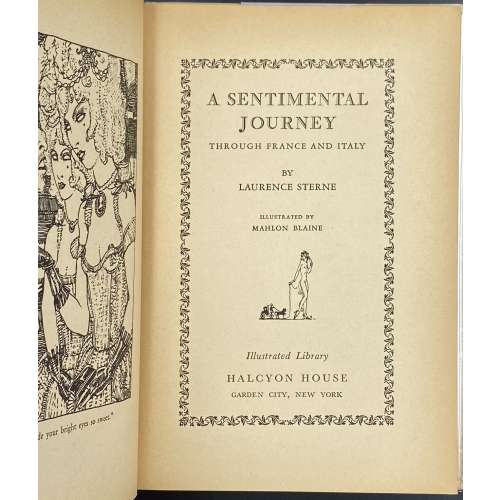 Title: A SENTIMENTAL | JOURNEY | THROUGH FRANCE AND ITALY | BY | LAURENCE STERNE | ILLUSTRATED BY | MAHLON BLAINE | {vignette} | Illustrated library | HALCYON HOUSE | GARDEN CITY, NEW YORK || Pagination: [1-6] – first leaf blank, h.t., t.p., 7-192, total 192 pages; frontispiece plus 4 plates within collation, and a headpiece, all photomechanical reproductions of Mahlon Blaine’s pen drawings. Binding: 20.5 x 14 cm, off-white pictorial paper boards decorated with black ivy-clad pink lattice, black lettering in a pink frame to spine, pink pictorial dust jacket with spine sunned to beige. Contributors: Sterne, Laurence (British-Irish, 1713 – 1768) – author of the text. Blaine, Mahlon (American, 1894 – 1969) – illustrator (pseudonym: G. Christopher Hudson). The Illustrated library series was started by Halcyon House, a reprint division of Doubleday Publishers, in 1950. This edition of Sterne with Blaine’s illustrations is a reprint of the same, published by Three Sirens Press of New York in 1930. Blaine's illustrations of this kind are pen drawings, not wood engravings.
Title: A SENTIMENTAL | JOURNEY | THROUGH FRANCE AND ITALY | BY | LAURENCE STERNE | ILLUSTRATED BY | MAHLON BLAINE | {vignette} | Illustrated library | HALCYON HOUSE | GARDEN CITY, NEW YORK || Pagination: [1-6] – first leaf blank, h.t., t.p., 7-192, total 192 pages; frontispiece plus 4 plates within collation, and a headpiece, all photomechanical reproductions of Mahlon Blaine’s pen drawings. Binding: 20.5 x 14 cm, off-white pictorial paper boards decorated with black ivy-clad pink lattice, black lettering in a pink frame to spine, pink pictorial dust jacket with spine sunned to beige. Contributors: Sterne, Laurence (British-Irish, 1713 – 1768) – author of the text. Blaine, Mahlon (American, 1894 – 1969) – illustrator (pseudonym: G. Christopher Hudson). The Illustrated library series was started by Halcyon House, a reprint division of Doubleday Publishers, in 1950. This edition of Sterne with Blaine’s illustrations is a reprint of the same, published by Three Sirens Press of New York in 1930. Blaine's illustrations of this kind are pen drawings, not wood engravings. -
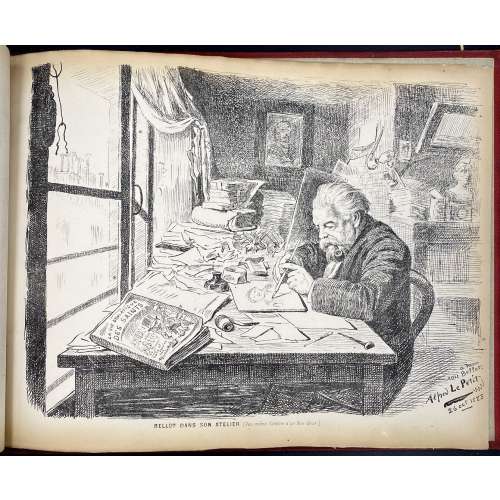 An album of the "Le Bon-Bock" dinners for the year 1884. Author, designer and publisher – Emile Bellot (French, 1831 – 1886), a Parisian artist and engraver. "Le Bon-Bock" was a monthly dinner of artists and men of letters, who gathered in Paris for good food, good company, and artistic performances, from 1875 to at least 1925. The story behind these gatherings as told by Emile Bellot, the founder, is this:
An album of the "Le Bon-Bock" dinners for the year 1884. Author, designer and publisher – Emile Bellot (French, 1831 – 1886), a Parisian artist and engraver. "Le Bon-Bock" was a monthly dinner of artists and men of letters, who gathered in Paris for good food, good company, and artistic performances, from 1875 to at least 1925. The story behind these gatherings as told by Emile Bellot, the founder, is this:In February 1875, Pierre Cottin1 came to me and said: 'I discovered a poet and tragedian of immense talent and who interprets the poems of the Great Victor Hugo in an astonishing way. Monsieur Gambini. I promised him that I would make it heard by an audience of artists and men of letters. I am counting on you who have many connections to keep my promise to him'. I gathered about 25 of my friends and acquaintances in a picnic dinner which took place at a restaurant 'Krauteimer' on the rue Rochechouart in Montmartre. They heard from Mr Gambini first, then my friends Étienne Carjat2, J. Gros3, Adrien Dézamy4, etc. performed. These gentlemen completed the evening so brilliantly that it was unanimously decided that we would start a similar dinner every month. Poets, musicians, men of letters, singers would be invited to this dinner. I was in charge of the organization of this little party and as it was the dream of my life to bring together old comrades, I was careful not to refuse and I pursued this good idea. Cottin and René Tener5 were kind enough to help me in this joyous task and especially my old friend Carjat. The following March began our 1st monthly dinner.
The name "Le Bon-Bock" means "The Good Bock", whilst Bock is a kind of beer, a dark, malty, lightly hopped ale. The dinner was named "Le Bon-Bock" in honour of the Éduard Manet painting (1873), a famous portrait of Emile Bellot, called "Le Bon-Bock".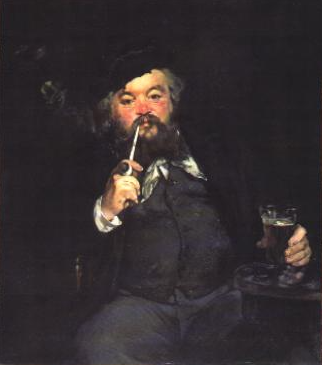 The invitations to the dinner were also produced by the artists and looked like this one by Alexandre Ferdinandus (October 3, 1883).
The invitations to the dinner were also produced by the artists and looked like this one by Alexandre Ferdinandus (October 3, 1883).
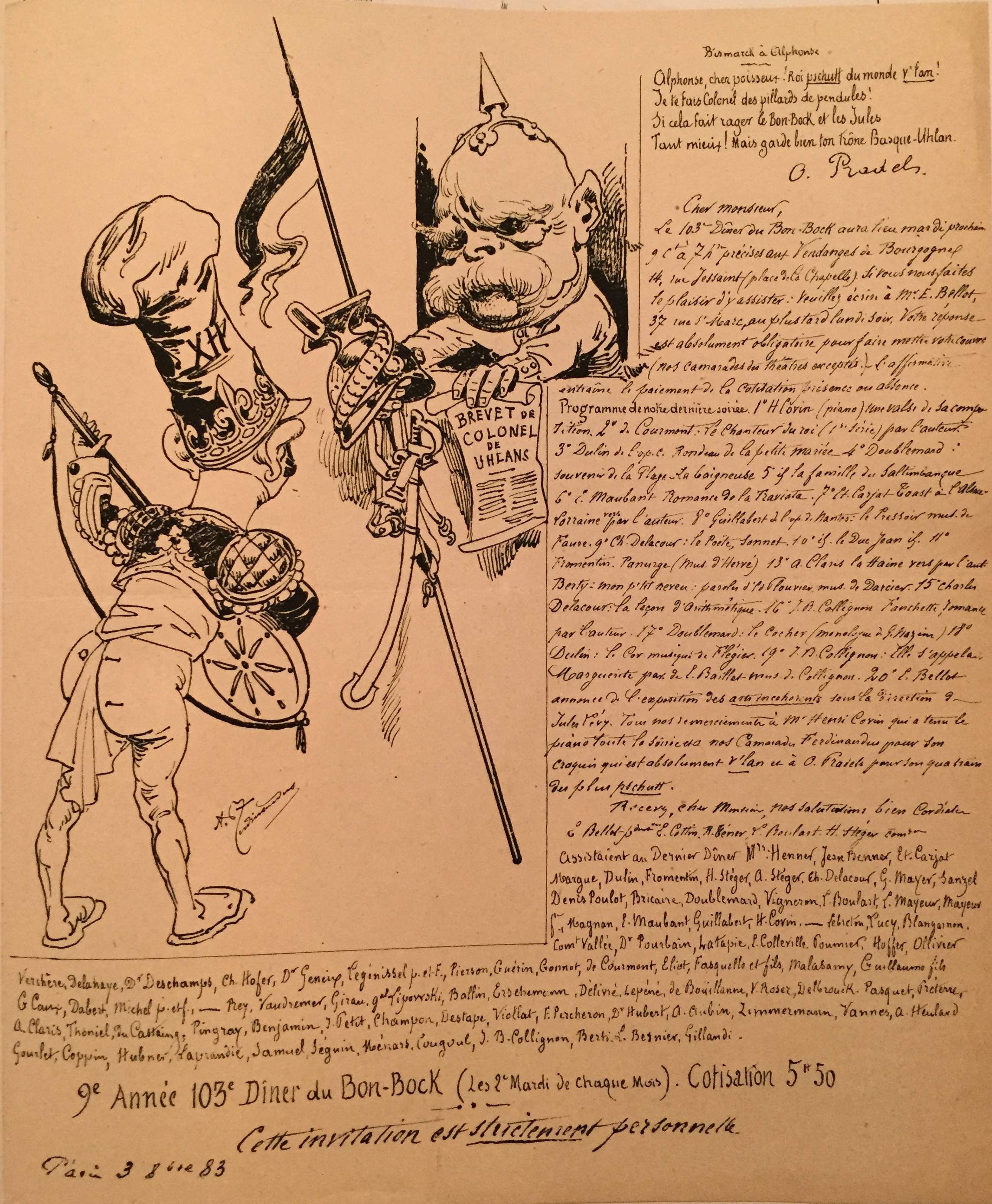 Besides this sketch of the Parisian social and artistic life at the end of the 19th century, the provenance of the album in our collection generates additional interest. The ink stamp to the front flyleaf reads: "Docteur Henry Uzan, 29 Avenue Perrichont, Paris XVI".
Doctor Henry Uzan was Jewish. He was arrested by the Pétain police on October 1, 1941, and interned in Drancy. With the few means at his disposal, he undertook to treat the sick whom he then saw leaving, week after week, towards their terrible destiny in the extermination camps. In October 1943 doctor Uzan was deported to the island of Alderney. After the Normandy Landing of June 6, 1944, Nazis evacuated the island detainees and transfer them to the Neuengamme camp, via northern France and Belgium. During the transfer, doctor Uzan managed to escape from the train on the night of September 3 to 4 around Dixmude in Flanders. He was taken in by the Belgian Resistance, which he joined before being repatriated to France.
In France, he continued working as a physician and was one of the founders of Association des internés et déportés politiques (AIDP). In 1945, together with his friends, the doctor designed the symbol for the Fédération nationale des déportés et internés résistants et patriotes:
Besides this sketch of the Parisian social and artistic life at the end of the 19th century, the provenance of the album in our collection generates additional interest. The ink stamp to the front flyleaf reads: "Docteur Henry Uzan, 29 Avenue Perrichont, Paris XVI".
Doctor Henry Uzan was Jewish. He was arrested by the Pétain police on October 1, 1941, and interned in Drancy. With the few means at his disposal, he undertook to treat the sick whom he then saw leaving, week after week, towards their terrible destiny in the extermination camps. In October 1943 doctor Uzan was deported to the island of Alderney. After the Normandy Landing of June 6, 1944, Nazis evacuated the island detainees and transfer them to the Neuengamme camp, via northern France and Belgium. During the transfer, doctor Uzan managed to escape from the train on the night of September 3 to 4 around Dixmude in Flanders. He was taken in by the Belgian Resistance, which he joined before being repatriated to France.
In France, he continued working as a physician and was one of the founders of Association des internés et déportés politiques (AIDP). In 1945, together with his friends, the doctor designed the symbol for the Fédération nationale des déportés et internés résistants et patriotes:
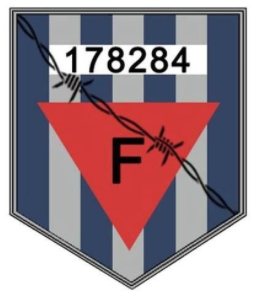 The story behind the number on the emblem (178284) is fascinating but it is out of the scope of this material.
The story behind the number on the emblem (178284) is fascinating but it is out of the scope of this material.
1. Pierre Cottin (French, 1823 – c. 1887) – Engraver, mezzotinter, genre and landscape painter; born in Chappelle-Saint-Denis (near Paris), a pupil of Jazet. Exhibited at the Salon from 1845, also in London from 1876 to 1879.↩ 2. Étienne Carjat (French, 1828 – 1906) – Journalist, caricaturist and photographer. ↩ 3. Jean Baptiste Louis Gros (French, 1793 – 1870) – Painter. ↩ 4. Adrien Dézamy (French, 1844 – 1891) – Writer, poet, general secretary of the Théâtre des Bouffes in Paris. ↩ 5. Rene Tener (French, 1846 – 1925) – Painter. ↩ Sources:Auguste Lepage. Les dîners artistiques et littéraires de Paris / Bibliothèque des Deux mondes (2e éd.) – Paris: Frinzine, Klein et Cie., 1884. [Accession № LIB-2606.2021 in this collection]
-
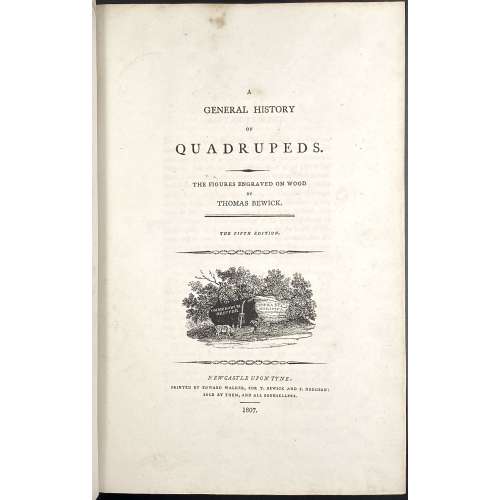 Title: A | GENERAL HISTORY | OF | QUADRUPEDS. | – | THE FIGURES ENGRAVED ON WOOD | BY | THOMAS BEWICK. | — | THE FIFTH EDITION | {vignette} | NEWCASTLE UPON TYNE: | PRINTED BY EDWARD WALKER, FOR T. BEWICK AND S. HODGSON: | SOLD BY THEM, AND ALL BOOKSELLERS. | 1807. Pagination: [2 blanks], [i, ii] – t.p. / blank], [iii, iv] – advertisement, [v] vi-x – index, [1] 2-525 [526 advert. of British Birds] [2 blanks]. Collation: Royal 8vo in fours; π (engraved title), a4 A-3T4 χ3T3. F2 signed 2F, 2E2 unsigned, p. 131 numbered correctly, p. 257 numbered 572. Size: 26 x 17 cm; page 24.5 x 16 cm (royal). Woodcuts: 302 descriptions of quadrupeds, 225 figures and 112 vignettes, tail-pieces, etc. Binding: Full diced brown calf, embossed blind corner fleurons, gilt-tooled border inside and outside, AEG, spine with raised bands, gilt in compartments, lettering; binding restored; armorial bookplate "Thorpe" to front pastedown. Likely to be Thomas Thorpe (1791 – 1851), a prominent bookseller in London: Bedford Street, Covent Garden; started in 1818, went bankrupt on Dec. 31, 1825. Thorpe's family coat of arms: stag standing on a crown and a lion rampant. Catalogue raisonné: S. Roscoe (1953): pp. 23-27. Hugo (1866): pp. 22-24.
Title: A | GENERAL HISTORY | OF | QUADRUPEDS. | – | THE FIGURES ENGRAVED ON WOOD | BY | THOMAS BEWICK. | — | THE FIFTH EDITION | {vignette} | NEWCASTLE UPON TYNE: | PRINTED BY EDWARD WALKER, FOR T. BEWICK AND S. HODGSON: | SOLD BY THEM, AND ALL BOOKSELLERS. | 1807. Pagination: [2 blanks], [i, ii] – t.p. / blank], [iii, iv] – advertisement, [v] vi-x – index, [1] 2-525 [526 advert. of British Birds] [2 blanks]. Collation: Royal 8vo in fours; π (engraved title), a4 A-3T4 χ3T3. F2 signed 2F, 2E2 unsigned, p. 131 numbered correctly, p. 257 numbered 572. Size: 26 x 17 cm; page 24.5 x 16 cm (royal). Woodcuts: 302 descriptions of quadrupeds, 225 figures and 112 vignettes, tail-pieces, etc. Binding: Full diced brown calf, embossed blind corner fleurons, gilt-tooled border inside and outside, AEG, spine with raised bands, gilt in compartments, lettering; binding restored; armorial bookplate "Thorpe" to front pastedown. Likely to be Thomas Thorpe (1791 – 1851), a prominent bookseller in London: Bedford Street, Covent Garden; started in 1818, went bankrupt on Dec. 31, 1825. Thorpe's family coat of arms: stag standing on a crown and a lion rampant. Catalogue raisonné: S. Roscoe (1953): pp. 23-27. Hugo (1866): pp. 22-24. -
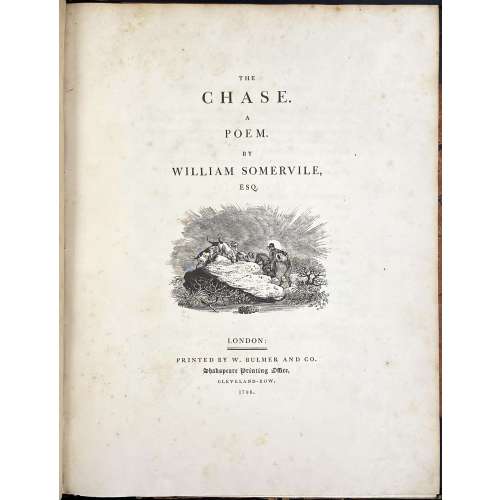 Royal 4to, 29.8 x 23.5 cm, contemporary half brown morocco, marbled boards gilt ruled, spine with gilt-ruled raised bands, gilt title lettering; "William Gore" armorial bookplate to front pastedown. Title page: THE | CHASE. | A | POEM. | BY | WILLIAM SOMERVILLE, | ESQ. | [VIGNETTE] | LONDON : | PRINTED BY W. BULMER AND CO. | Shakespeare Printing Office, | CLEVELAND-ROW. | 1796. Collation: without signatures. — Pagination: [i-v] vi-xv [xvi], [i] ii-vii [viii], [1-5] 6-126; illustrations: engraved title, 4 running titles, 4 headpieces, 4 tailpieces – 13 altogether, all drafted by John Bewick, 12 executed by Thomas Bewick and the last one by Charlton Nesbit. Catalogue Raisonné: Thomas Hugo. The Bewick Collector, vol. 1 (1866): p. 38, № 94: "The first edition... was printed in royal 4to". John Bewick made all the drawing on the blocks but was not able to execute the engravings himself "because of ill-health. They were engraved by Thomas Bewick, with the exception of the tail-piece at the end of the volume, which was engraved by Nesbit". Thomas Bewick (c. 11 August 1753 – 8 November 1828); John Bewick (1760 – 1795), the younger brother of Thomas, died at the age of 35. Christie's, who sold a similar copy on 29 Oct 2012, provides for the size 2°.
Royal 4to, 29.8 x 23.5 cm, contemporary half brown morocco, marbled boards gilt ruled, spine with gilt-ruled raised bands, gilt title lettering; "William Gore" armorial bookplate to front pastedown. Title page: THE | CHASE. | A | POEM. | BY | WILLIAM SOMERVILLE, | ESQ. | [VIGNETTE] | LONDON : | PRINTED BY W. BULMER AND CO. | Shakespeare Printing Office, | CLEVELAND-ROW. | 1796. Collation: without signatures. — Pagination: [i-v] vi-xv [xvi], [i] ii-vii [viii], [1-5] 6-126; illustrations: engraved title, 4 running titles, 4 headpieces, 4 tailpieces – 13 altogether, all drafted by John Bewick, 12 executed by Thomas Bewick and the last one by Charlton Nesbit. Catalogue Raisonné: Thomas Hugo. The Bewick Collector, vol. 1 (1866): p. 38, № 94: "The first edition... was printed in royal 4to". John Bewick made all the drawing on the blocks but was not able to execute the engravings himself "because of ill-health. They were engraved by Thomas Bewick, with the exception of the tail-piece at the end of the volume, which was engraved by Nesbit". Thomas Bewick (c. 11 August 1753 – 8 November 1828); John Bewick (1760 – 1795), the younger brother of Thomas, died at the age of 35. Christie's, who sold a similar copy on 29 Oct 2012, provides for the size 2°. -
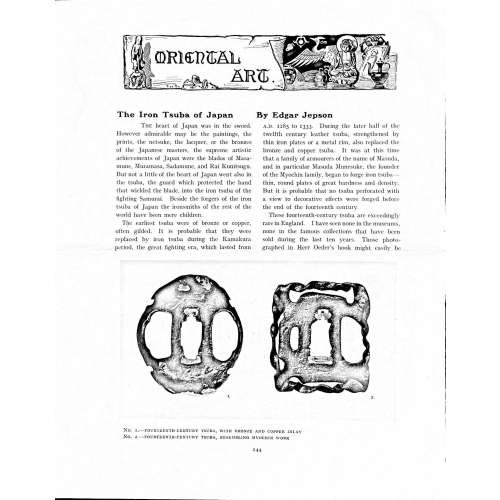 Magazine article by Edgar Jepson: The Iron Tsuba of Japan (Section: Oriental Art), published in volume Vol. 70 (September–December) of The Connoisseur: An Illustrated Magazine for Collectors, Vol. 70 (September–December); pp. 143-152 / C. Reginald Grundy [ed.] — London: Published by the Proprietor, W. CLAUSE JOHNSON, at the Editorial and Advertisement Offices of The Connoisseur, 1924. Owner's half black morocco, gilt lettering to spine, blue cloth boards. Two volumes bound together without original covers. Size 28.5 x 22 cm. Vol. 1: The Connoisseur | An Illustrated Magazine | For Collectors | Edited by C. Reginald Grundy | Vol. LXIX. | (MAY—AUGUST, 1924) | LONDON | Published by the Proprietor, W. CLAUSE JOHNSON, at the | Editorial and Advertisement Offices of The Connoisseur, | at 1, Duke Street, St. James's, S.W. 1 | 1924 || Pp.: [i-ii] iii-xviii [xix] [1, 2 - plate] 3-249 [250]. Vol. 2: The Connoisseur | An Illustrated Magazine | For Collectors | Edited by C. Reginald Grundy | Vol. LXX. | (SEPTEMBER—DECEMBER, 1924) | LONDON | Published by the Proprietor, W. CLAUSE JOHNSON, at the | Editorial and Advertisement Offices of The Connoisseur, | at 1, Duke Street, St. James's, S.W. 1 | 1924 || Pp.: [i-ii] iii-xxii [2 blanks] [1, 2 - plate] 3-261 [262]. The Iron Tsuba of Japan by Edgar Jepson The heart of Japan was in the sword. However admirable may be the paintings, the prints, the netsuke, the lacquer, or the bronzes of the Japanese masters, the supreme artistic achievements of Japan were the blades of Masamune, Muramasa, Sadamune, and Rai Kunitsugu. But not a little of the heart of Japan went also in the tsuba, the guard which protected the hand that wielded the blade, into the iron tsuba of the fighting Samurai. Beside the forgers of the iron tsuba of Japan the ironsmiths of the rest of the world have been mere children. The earliest tsuba were of bronze or copper, often gilded. It is probable that they were replaced by iron tsuba during the Kamakura period, the great fighting era, which lasted from A.D. 1185 to 1333. During the later half of the twelfth century leather tsuba, strengthened by thin iron plates or a metal rim, also replaced the bronze and copper tsuba. It was at this time that a family of armourers of the name of Masuda, and in particular Masuda Munesuke, the founder of the Myochin family, began to forge iron tsuba — thin, round plates of great hardness and density. But it is probable that no tsuba perforated with a view to decorative effects were forged before the end of the fourteenth century. These fourteenth-century tsuba are exceedingly rare in England. I have seen none in the museums, none in the famous collections that have been sold during the last ten years. Those photographed in Herr Oeder's book might easily be the fifteenth century. No. 1 is a curious cup-shape tsuba decorated with a bronze and copper inlay. No. 2, with its edges curiously twisted in the forging, looks like Myochin work. But it is not of the Myochin iron. The Myochin family produced some of the greatest ironsmiths of Japan. Armourers first of all, tsubasmiths, forgers of sake-kettles, articulated reptiles, crustacea, and insects — everything that can be done with iron they did; they pushed their medium to its limit. They were forging iron tsuba in 1160, and they were still forging them in 1860. And it was their own iron, or rather their own steel. They discovered the secret of it early, and they kept that secret in the family for all those hundreds of years. There is no mistaking a Myochin tsuba: balance it on your finger and tap it with a piece of metal, always it gives forth a clear bell-like ring that you get from the work of no other ironsmith, Japanese or European. Always the Myochin tsuba is before everything a protection to the hand of the swordsman; to that everything is, as it should be, subordinated. No. 3 is a Myochin tsuba of the fifteenth century, and probably of the early fifteenth century. No. 4, by Myochin Munetaka, perforated with a grotesque figure, is an example of that twisting and twisting of the iron in the forging till it forms a pattern like the grain of wood. The Myochin smiths invented these wood-grain tsuba, and no other smiths equalled them in their forging. In the sixteenth century, the fighting tsuba was probably at its best. It was a century of great tsubasmiths. Then the first Nobuiye, whose tsuba fetched £100 apiece, circa 1800, in Japan, and the first Kaneiye flourished. No. 5 is a tsuba forged by a great smith, Iyesada of Sotome, in the manner of Nobuiye I, decorated with the karakusa tendrils that Nobuiye delighted in, with lightning and clouds. No. 6 is a guard of Sanada Tembo, the chief smith of the Tembo family, stamped, punning fashion, with the character Tembo. Akin to the Tembo tsuba were those of the Kiami and Hoan smiths. Then also the Heianjo smiths and the Owari smiths, especially those of Nagoya and the Yamakichi family, forged their strongest tsuba. Those of the Yamakichi were tested after the forging by being pounded in iron mortars — at least, so the legend runs. But they were a sternly utilitarian family, and I have never seen a Yamakichi tsuba of any beauty. In the later half of the fifteenth century arose the fashion of decorating tsuba with an inlay, zogan, of bronze. The Heianjo tsuba, forged at Kyoto in the latter half of the fifteenth and the beginning of the sixteenth century, were often thus inlaid. The earliest of them were called "Onin", of which No. 7 is an example. In addition to the bronze inlay around the edge, it is inlaid with a representation, some say, of snow; others say, of the duckweed on a pond. No. 8 is probably a Heianjo tsuba, but I am not quite sure about it. The inlaid acacia branches might be very early Shoami work. But to judge by the iron, it is a fifteenth-century tsuba; and the authorities place the beginning of the Shoami school not later than early in the sixteenth century. No. 10 is an example of the Fushimi-zogan, a flat inlay of a light-coloured bronze. These tsuba took their name from the fact that they were first forged at Fushimi, in Yamashiro, in the sixteenth century. It is of the type known as Mon-zukashi, perforated with crests (mon) à jour. The Yoshiro-zogan tsuba were also first forged at Fushimi by Yoshiro Naomasa. They were distinguished from the Fushimi-zogan by the fact that their inlay was generally a little raised-not always-for the inlay of No. 9, a tsuba forged by a later nineteenth-century Yoshiro, is quite flat. It is an interesting tsuba, for, with its decoration grown florid and excessive, it marks the intermediate stage between the simple and delightful designs of the genuine fighting tsuba and the elaborate pictures in gold and silver on the tsuba of the eighteenth-century smiths of Awa and Kyoto, which have become mere ornaments of the goldsmith. The Gomoku-zogan (No. 11) tsuba were probably first forged earlier than the Fushimi and Yoshiro-zogan tsuba. This inlay, in slight relief, is a representation in a light-coloured bronze and copper of twigs caught in the eddies of streams. The seventeenth century and early eighteenth century were the great periods of perforated tsuba. The designs, and they are often admirable, are for the most part in plain fretwork; but they are also chased. No. 12, a crane under an acacia, is a tsuba of a Higo smith, great forgers of fighting tsuba during this period. These smiths also excelled in nunome zogan, a very thin gold and silver inlay, with which they further decorated their perforated guards. The smiths of the Umetada and Shoami families also forged iron tsuba during this period; but their designs, though sometimes pleasing enough, are rarely fine. The best work of Myoju Umetada is in sentoku, not iron. The Choshu smiths, coming later, surpass the perforated guards of both the Umetada and Shoami smiths in beauty of design. No. 13, a lotus in the round, not only fretwork, but also engraved, is a good example of the admirable balance they so often attained in their designs. It is a sufficiently realistic lotus, but yet of a delightful simplicity. In considerable contrast is No. 14, the dragon by Soheishi Soten — one of the only two authentic tsuba of his forging known — the first forger of hikone-bori tsuba, which were in extraordinary favour in Japan during the eighteenth century, and illustrated every important event in Japanese history. It is on the elaborate side, but fine, strong work, and an excellent guard to the hand, for the lighter and more open part, which gives the design its admirable balance, is on the inside, and not exposed to the full swing of an opponent's blade. A few years ago there was a tendency to decry the Namban tsuba as having sprung too directly from foreign sources. But though the original suggestion may have been Chinese, or, as some say, Portuguese, the Japanese made it entirely their own, as characteristically Japanese as anything can well be, but, it must be admitted, of a decadent period. The school took its rise at the beginning of the seventeenth century, and the early tsuba were forged of a specially hard iron, the Wootz, imported from Southern India. No. 15, the signs of the Zodiac, is an excellent tsuba from the fighting point of view. Both it and No. 16 are of quite charming, if elaborate, design, and both of them, with their delicate scroll-work, so astonishingly undercut, are the very last word in the work of the ironsmith-veritable iron lace. To return to the simpler perforated tsuba, the smiths of Akasaka, a suburb of Tokyo, produced probably the most charming designs. Their style derives considerably from the Higo smiths, and their earlier fighting tsuba are very like the Higo tsuba. But always their work was just a little lighter than that of the Higo smiths, and in the end they moved right away from them and became the forgers of very light guards indeed. No. 17, is a representation of the Hiyokudori, the fabulous double bird, in which were reincarnated the souls of the two lovers, Gompachi and Komurasaki; and No. 18, “the tsuba of a hundred ducks "— there are about forty — are characteristic designs of the school. In the work of the Akasaka smiths the balance, which makes the design of a good tsuba so admirable and delightful, attains its height. This admirable balance seems often to be obtained by a deliberate sacrifice of symmetry. About nine hundred and ninety-nine European ironsmiths out of a thousand would have made the right and left sides of the Hiyoku-dori line by line, and perforation by perforation, exactly alike; he would have cut out exactly as many ducks on the one side of “the tsuba of a hundred ducks” as on the other, and made each duck on the right side correspond exactly in position and attitude with a duck on the left side. By variations the tsubasmith attained a finer balance, almost a higher symmetry. No. 19, often called by collectors the "rose-window" tsuba, but really a stylised chrysanthemum, is a favourite design of the Akasaka smiths, but Hizen work and inlaid in the Hizen manner with gold nunome. No. 20 is a Satsuma tsuba of the middle period. The Satsuma smiths of the nineteenth century produced probably the most ornate of all the iron guards, for the most part calibashes and beans with their leaves and tendrils realistic in the extreme, but of charming design. Few crafts have been carried further than that of the tsubasmith; few crafts working in a difficult medium have handled more subjects with greater feeling for beauty or greater liveliness of fancy. It is interesting to note again and again how school influences school, and smith influences smith. But, as in all the applied arts, the finest tsuba were forged by men who never lost sight of the purpose of a tsuba, that it is before everything a protection to the hand, and never subjected that purpose to a passion for virtuosity. Illustrations: No 1. FOURTEENTH-CENTURY TSUBA, WITH BRONZE AND COPPER INLAY No. 2. FOURTEENTH-CENTURY TSUBA, RESEMBLING MYOCHIN WORK No. 3. MYOCHIN TSUBA, FIFTEENTH CENTURY No. 4. MYOCHIN TSUBA, NINETEENTH CENTURY No. 5. SIXTEENTH-CENTURY TSUBA No. 6. SIXTEENTH-CENTURY TSUBA BY IYESADA OF SOTOME BY SANADA TEMBO No. 7. ONIN TSUBA No. 8. HEIANJO (?) TSUBA No. 9. YOSHIRO TSUBA, NINETEENTH CENTURY No. 10. FUSHIMI-ZOGAN, NINETEENTH CENTURY No. 11.- GOMOKU-ZOGAN, SIXTEENTH CENTURY No. 12. HIGO TSUBA, SEVENTEENTH CENTURY No. 13. CHOSHU TSUBA, SEVENTEENTH CENTURY No. 14. SOTEN TSUBA, SEVENTEENTH CENTURY No. 15. NAMBAN TSUBA, EIGHTEENTH CENTURY No. 16. NAMBAN TSUBA, NINETEENTH CENTURY Nos. 17. AND 18. AKASAKA TSUBA, EIGHTEENTH CENTURY No. 19. HIZEN TSUBA, EIGHTEENTH CENTURY No. 20. SATSUMA TSUBA, EIGHTEENTH CENTURY
Magazine article by Edgar Jepson: The Iron Tsuba of Japan (Section: Oriental Art), published in volume Vol. 70 (September–December) of The Connoisseur: An Illustrated Magazine for Collectors, Vol. 70 (September–December); pp. 143-152 / C. Reginald Grundy [ed.] — London: Published by the Proprietor, W. CLAUSE JOHNSON, at the Editorial and Advertisement Offices of The Connoisseur, 1924. Owner's half black morocco, gilt lettering to spine, blue cloth boards. Two volumes bound together without original covers. Size 28.5 x 22 cm. Vol. 1: The Connoisseur | An Illustrated Magazine | For Collectors | Edited by C. Reginald Grundy | Vol. LXIX. | (MAY—AUGUST, 1924) | LONDON | Published by the Proprietor, W. CLAUSE JOHNSON, at the | Editorial and Advertisement Offices of The Connoisseur, | at 1, Duke Street, St. James's, S.W. 1 | 1924 || Pp.: [i-ii] iii-xviii [xix] [1, 2 - plate] 3-249 [250]. Vol. 2: The Connoisseur | An Illustrated Magazine | For Collectors | Edited by C. Reginald Grundy | Vol. LXX. | (SEPTEMBER—DECEMBER, 1924) | LONDON | Published by the Proprietor, W. CLAUSE JOHNSON, at the | Editorial and Advertisement Offices of The Connoisseur, | at 1, Duke Street, St. James's, S.W. 1 | 1924 || Pp.: [i-ii] iii-xxii [2 blanks] [1, 2 - plate] 3-261 [262]. The Iron Tsuba of Japan by Edgar Jepson The heart of Japan was in the sword. However admirable may be the paintings, the prints, the netsuke, the lacquer, or the bronzes of the Japanese masters, the supreme artistic achievements of Japan were the blades of Masamune, Muramasa, Sadamune, and Rai Kunitsugu. But not a little of the heart of Japan went also in the tsuba, the guard which protected the hand that wielded the blade, into the iron tsuba of the fighting Samurai. Beside the forgers of the iron tsuba of Japan the ironsmiths of the rest of the world have been mere children. The earliest tsuba were of bronze or copper, often gilded. It is probable that they were replaced by iron tsuba during the Kamakura period, the great fighting era, which lasted from A.D. 1185 to 1333. During the later half of the twelfth century leather tsuba, strengthened by thin iron plates or a metal rim, also replaced the bronze and copper tsuba. It was at this time that a family of armourers of the name of Masuda, and in particular Masuda Munesuke, the founder of the Myochin family, began to forge iron tsuba — thin, round plates of great hardness and density. But it is probable that no tsuba perforated with a view to decorative effects were forged before the end of the fourteenth century. These fourteenth-century tsuba are exceedingly rare in England. I have seen none in the museums, none in the famous collections that have been sold during the last ten years. Those photographed in Herr Oeder's book might easily be the fifteenth century. No. 1 is a curious cup-shape tsuba decorated with a bronze and copper inlay. No. 2, with its edges curiously twisted in the forging, looks like Myochin work. But it is not of the Myochin iron. The Myochin family produced some of the greatest ironsmiths of Japan. Armourers first of all, tsubasmiths, forgers of sake-kettles, articulated reptiles, crustacea, and insects — everything that can be done with iron they did; they pushed their medium to its limit. They were forging iron tsuba in 1160, and they were still forging them in 1860. And it was their own iron, or rather their own steel. They discovered the secret of it early, and they kept that secret in the family for all those hundreds of years. There is no mistaking a Myochin tsuba: balance it on your finger and tap it with a piece of metal, always it gives forth a clear bell-like ring that you get from the work of no other ironsmith, Japanese or European. Always the Myochin tsuba is before everything a protection to the hand of the swordsman; to that everything is, as it should be, subordinated. No. 3 is a Myochin tsuba of the fifteenth century, and probably of the early fifteenth century. No. 4, by Myochin Munetaka, perforated with a grotesque figure, is an example of that twisting and twisting of the iron in the forging till it forms a pattern like the grain of wood. The Myochin smiths invented these wood-grain tsuba, and no other smiths equalled them in their forging. In the sixteenth century, the fighting tsuba was probably at its best. It was a century of great tsubasmiths. Then the first Nobuiye, whose tsuba fetched £100 apiece, circa 1800, in Japan, and the first Kaneiye flourished. No. 5 is a tsuba forged by a great smith, Iyesada of Sotome, in the manner of Nobuiye I, decorated with the karakusa tendrils that Nobuiye delighted in, with lightning and clouds. No. 6 is a guard of Sanada Tembo, the chief smith of the Tembo family, stamped, punning fashion, with the character Tembo. Akin to the Tembo tsuba were those of the Kiami and Hoan smiths. Then also the Heianjo smiths and the Owari smiths, especially those of Nagoya and the Yamakichi family, forged their strongest tsuba. Those of the Yamakichi were tested after the forging by being pounded in iron mortars — at least, so the legend runs. But they were a sternly utilitarian family, and I have never seen a Yamakichi tsuba of any beauty. In the later half of the fifteenth century arose the fashion of decorating tsuba with an inlay, zogan, of bronze. The Heianjo tsuba, forged at Kyoto in the latter half of the fifteenth and the beginning of the sixteenth century, were often thus inlaid. The earliest of them were called "Onin", of which No. 7 is an example. In addition to the bronze inlay around the edge, it is inlaid with a representation, some say, of snow; others say, of the duckweed on a pond. No. 8 is probably a Heianjo tsuba, but I am not quite sure about it. The inlaid acacia branches might be very early Shoami work. But to judge by the iron, it is a fifteenth-century tsuba; and the authorities place the beginning of the Shoami school not later than early in the sixteenth century. No. 10 is an example of the Fushimi-zogan, a flat inlay of a light-coloured bronze. These tsuba took their name from the fact that they were first forged at Fushimi, in Yamashiro, in the sixteenth century. It is of the type known as Mon-zukashi, perforated with crests (mon) à jour. The Yoshiro-zogan tsuba were also first forged at Fushimi by Yoshiro Naomasa. They were distinguished from the Fushimi-zogan by the fact that their inlay was generally a little raised-not always-for the inlay of No. 9, a tsuba forged by a later nineteenth-century Yoshiro, is quite flat. It is an interesting tsuba, for, with its decoration grown florid and excessive, it marks the intermediate stage between the simple and delightful designs of the genuine fighting tsuba and the elaborate pictures in gold and silver on the tsuba of the eighteenth-century smiths of Awa and Kyoto, which have become mere ornaments of the goldsmith. The Gomoku-zogan (No. 11) tsuba were probably first forged earlier than the Fushimi and Yoshiro-zogan tsuba. This inlay, in slight relief, is a representation in a light-coloured bronze and copper of twigs caught in the eddies of streams. The seventeenth century and early eighteenth century were the great periods of perforated tsuba. The designs, and they are often admirable, are for the most part in plain fretwork; but they are also chased. No. 12, a crane under an acacia, is a tsuba of a Higo smith, great forgers of fighting tsuba during this period. These smiths also excelled in nunome zogan, a very thin gold and silver inlay, with which they further decorated their perforated guards. The smiths of the Umetada and Shoami families also forged iron tsuba during this period; but their designs, though sometimes pleasing enough, are rarely fine. The best work of Myoju Umetada is in sentoku, not iron. The Choshu smiths, coming later, surpass the perforated guards of both the Umetada and Shoami smiths in beauty of design. No. 13, a lotus in the round, not only fretwork, but also engraved, is a good example of the admirable balance they so often attained in their designs. It is a sufficiently realistic lotus, but yet of a delightful simplicity. In considerable contrast is No. 14, the dragon by Soheishi Soten — one of the only two authentic tsuba of his forging known — the first forger of hikone-bori tsuba, which were in extraordinary favour in Japan during the eighteenth century, and illustrated every important event in Japanese history. It is on the elaborate side, but fine, strong work, and an excellent guard to the hand, for the lighter and more open part, which gives the design its admirable balance, is on the inside, and not exposed to the full swing of an opponent's blade. A few years ago there was a tendency to decry the Namban tsuba as having sprung too directly from foreign sources. But though the original suggestion may have been Chinese, or, as some say, Portuguese, the Japanese made it entirely their own, as characteristically Japanese as anything can well be, but, it must be admitted, of a decadent period. The school took its rise at the beginning of the seventeenth century, and the early tsuba were forged of a specially hard iron, the Wootz, imported from Southern India. No. 15, the signs of the Zodiac, is an excellent tsuba from the fighting point of view. Both it and No. 16 are of quite charming, if elaborate, design, and both of them, with their delicate scroll-work, so astonishingly undercut, are the very last word in the work of the ironsmith-veritable iron lace. To return to the simpler perforated tsuba, the smiths of Akasaka, a suburb of Tokyo, produced probably the most charming designs. Their style derives considerably from the Higo smiths, and their earlier fighting tsuba are very like the Higo tsuba. But always their work was just a little lighter than that of the Higo smiths, and in the end they moved right away from them and became the forgers of very light guards indeed. No. 17, is a representation of the Hiyokudori, the fabulous double bird, in which were reincarnated the souls of the two lovers, Gompachi and Komurasaki; and No. 18, “the tsuba of a hundred ducks "— there are about forty — are characteristic designs of the school. In the work of the Akasaka smiths the balance, which makes the design of a good tsuba so admirable and delightful, attains its height. This admirable balance seems often to be obtained by a deliberate sacrifice of symmetry. About nine hundred and ninety-nine European ironsmiths out of a thousand would have made the right and left sides of the Hiyoku-dori line by line, and perforation by perforation, exactly alike; he would have cut out exactly as many ducks on the one side of “the tsuba of a hundred ducks” as on the other, and made each duck on the right side correspond exactly in position and attitude with a duck on the left side. By variations the tsubasmith attained a finer balance, almost a higher symmetry. No. 19, often called by collectors the "rose-window" tsuba, but really a stylised chrysanthemum, is a favourite design of the Akasaka smiths, but Hizen work and inlaid in the Hizen manner with gold nunome. No. 20 is a Satsuma tsuba of the middle period. The Satsuma smiths of the nineteenth century produced probably the most ornate of all the iron guards, for the most part calibashes and beans with their leaves and tendrils realistic in the extreme, but of charming design. Few crafts have been carried further than that of the tsubasmith; few crafts working in a difficult medium have handled more subjects with greater feeling for beauty or greater liveliness of fancy. It is interesting to note again and again how school influences school, and smith influences smith. But, as in all the applied arts, the finest tsuba were forged by men who never lost sight of the purpose of a tsuba, that it is before everything a protection to the hand, and never subjected that purpose to a passion for virtuosity. Illustrations: No 1. FOURTEENTH-CENTURY TSUBA, WITH BRONZE AND COPPER INLAY No. 2. FOURTEENTH-CENTURY TSUBA, RESEMBLING MYOCHIN WORK No. 3. MYOCHIN TSUBA, FIFTEENTH CENTURY No. 4. MYOCHIN TSUBA, NINETEENTH CENTURY No. 5. SIXTEENTH-CENTURY TSUBA No. 6. SIXTEENTH-CENTURY TSUBA BY IYESADA OF SOTOME BY SANADA TEMBO No. 7. ONIN TSUBA No. 8. HEIANJO (?) TSUBA No. 9. YOSHIRO TSUBA, NINETEENTH CENTURY No. 10. FUSHIMI-ZOGAN, NINETEENTH CENTURY No. 11.- GOMOKU-ZOGAN, SIXTEENTH CENTURY No. 12. HIGO TSUBA, SEVENTEENTH CENTURY No. 13. CHOSHU TSUBA, SEVENTEENTH CENTURY No. 14. SOTEN TSUBA, SEVENTEENTH CENTURY No. 15. NAMBAN TSUBA, EIGHTEENTH CENTURY No. 16. NAMBAN TSUBA, NINETEENTH CENTURY Nos. 17. AND 18. AKASAKA TSUBA, EIGHTEENTH CENTURY No. 19. HIZEN TSUBA, EIGHTEENTH CENTURY No. 20. SATSUMA TSUBA, EIGHTEENTH CENTURY -
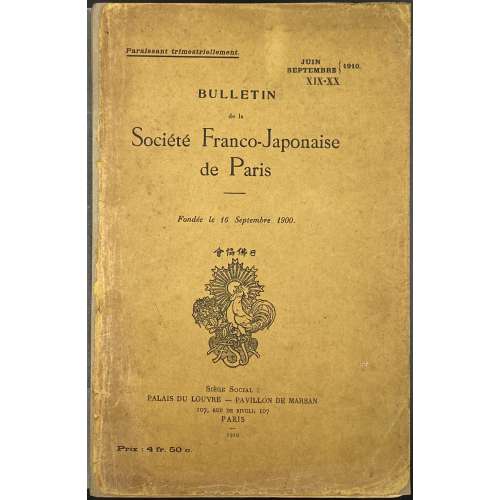 Comte de Tressan. L'évolution de la garde de sabre japonaise de la fin du XVe siècle au commencement du XVIIe (suite), 34 illustr. – pp. 7-35. // Bulletin de la Société Franco-Japonaise de Paris; №№ 19-20, Juin–Septembre 1910, 216 p. — Paris: Société Franco-Japonaise de Paris, Siège Social, 1910. Publisher's original green wrappers with black lettering: On top: Paraissant trimestriellement. | JUIN | SEPTEMBRE | } 1920 | XIX-XX | In the middle: BULLETIN | de la | Société Franco-Japonaise | de Paris | [—] Fondée le 16 Septembre 1900 | [device] | Bottom: Siège Social : | PALAIS DU LOUVRE — PAVILLON DE MARSAN | 107, RUE DE RIVOLI, 107 | Paris | 1910 | Prix : 4 fr 50 c || — Pp.: [4] [1-5] 6-216 [2 - errata / blank] [2 - imprim./ blank] [6]. Size: 27 x 17.5 cm.
Comte de Tressan. L'évolution de la garde de sabre japonaise de la fin du XVe siècle au commencement du XVIIe (suite), 34 illustr. – pp. 7-35. // Bulletin de la Société Franco-Japonaise de Paris; №№ 19-20, Juin–Septembre 1910, 216 p. — Paris: Société Franco-Japonaise de Paris, Siège Social, 1910. Publisher's original green wrappers with black lettering: On top: Paraissant trimestriellement. | JUIN | SEPTEMBRE | } 1920 | XIX-XX | In the middle: BULLETIN | de la | Société Franco-Japonaise | de Paris | [—] Fondée le 16 Septembre 1900 | [device] | Bottom: Siège Social : | PALAIS DU LOUVRE — PAVILLON DE MARSAN | 107, RUE DE RIVOLI, 107 | Paris | 1910 | Prix : 4 fr 50 c || — Pp.: [4] [1-5] 6-216 [2 - errata / blank] [2 - imprim./ blank] [6]. Size: 27 x 17.5 cm. -
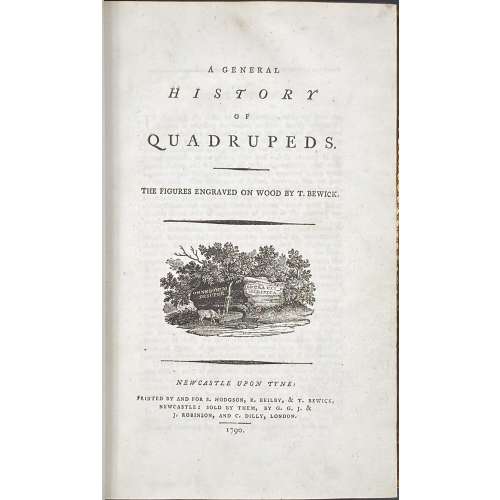 Title: A GENERAL | HISTORY | OF | QUADRUPEDS. | – | THE FIGURES ENGRAVED ON WOOD BY THOMAS BEWICK. | {vignette} | — | NEWCASTLE UPON TYNE : | PRINTED BY AND FOR S. HODGSON, R. BEILBY, & T. BEWICK, | NEWCASTLE: SOLD BY THEM, BY G. G. J. & | J. ROBINSON, AND C. DILLY, LONDON. | 1790. Pagination: [4 blanks], [i, ii] – t.p. / blank, [iii, iv] – advertisement / index, v-viii – index, [1] 2-456 [4 blanks]. Collation: demi 8vo; a⁴ A-Ee⁸ Ff⁴. A3 unsigned, catchword at p.375 THE instead of WE. Variant A (with a fly facing upward). Size: 21.8 x 14 cm; page 21.2 x 13 cm. Woodcuts: 260 descriptions of quadrupeds; 200 figures of quadrupeds, 104 vignettes, tailpieces, etc. Binding: Full marbled calf, gilt double border, black label with gilt lettering to flat spine. There were 1,500 copies Demy copies printed. Catalogue raisonné: S. Roscoe (1953): pp. 5-11; Hugo (1866): pp. 22-23.
Title: A GENERAL | HISTORY | OF | QUADRUPEDS. | – | THE FIGURES ENGRAVED ON WOOD BY THOMAS BEWICK. | {vignette} | — | NEWCASTLE UPON TYNE : | PRINTED BY AND FOR S. HODGSON, R. BEILBY, & T. BEWICK, | NEWCASTLE: SOLD BY THEM, BY G. G. J. & | J. ROBINSON, AND C. DILLY, LONDON. | 1790. Pagination: [4 blanks], [i, ii] – t.p. / blank, [iii, iv] – advertisement / index, v-viii – index, [1] 2-456 [4 blanks]. Collation: demi 8vo; a⁴ A-Ee⁸ Ff⁴. A3 unsigned, catchword at p.375 THE instead of WE. Variant A (with a fly facing upward). Size: 21.8 x 14 cm; page 21.2 x 13 cm. Woodcuts: 260 descriptions of quadrupeds; 200 figures of quadrupeds, 104 vignettes, tailpieces, etc. Binding: Full marbled calf, gilt double border, black label with gilt lettering to flat spine. There were 1,500 copies Demy copies printed. Catalogue raisonné: S. Roscoe (1953): pp. 5-11; Hugo (1866): pp. 22-23. -
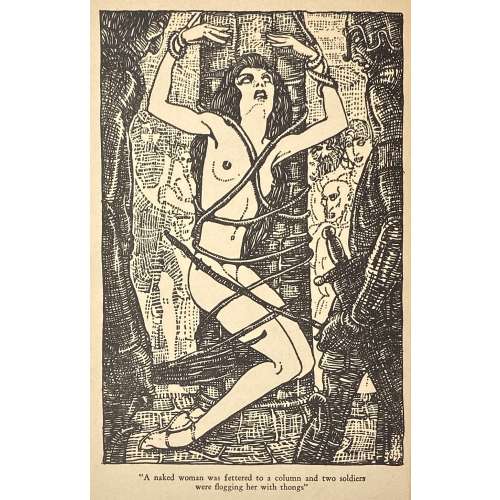 Title (in a frame): THE TEMPTATION | OF ST. ANTHONY | BY | GUSTAVE FLAUBERT | TRANSLATED BY | LAFCADIO HEARN | ILLUSTRATED BY | MAHLON BLAINE | {vignette} | NEW YORK | WILLIAMS, BELASCO | AND MEYERS || Pagination: ffl, [1, 2 - ht, blank] [2 - blank, frontis.] [3, 4 - t.p., colophon] [5, 6 - plate, blank] [7, 8 - list of ill., blank] [9 'argument'] 10-189 [190] bfl; frontispiece and 4 plates reproduced from Blaine's pen drawings in "woodcut" manner. Binding:25.5 x 17 cm., original black cloth, front cover and spine stamped in gilt; printed on thick paper, margins trimmed unevenly; pink pictorial DJ. Contributors: Gustave Flaubert (French, 1821 – 1880) – author. Mahlon Blaine (American, 1894 – 1969) – artist. Patrick Lafcadio Hearn [Koizumi Yakumo; 小泉 八雲] ( Greek-Irish, 1850 – 1904) – translator. Williams, Belasco and Meyers – publisher. J. J. Little & Ives, Co., NY – printer.
Title (in a frame): THE TEMPTATION | OF ST. ANTHONY | BY | GUSTAVE FLAUBERT | TRANSLATED BY | LAFCADIO HEARN | ILLUSTRATED BY | MAHLON BLAINE | {vignette} | NEW YORK | WILLIAMS, BELASCO | AND MEYERS || Pagination: ffl, [1, 2 - ht, blank] [2 - blank, frontis.] [3, 4 - t.p., colophon] [5, 6 - plate, blank] [7, 8 - list of ill., blank] [9 'argument'] 10-189 [190] bfl; frontispiece and 4 plates reproduced from Blaine's pen drawings in "woodcut" manner. Binding:25.5 x 17 cm., original black cloth, front cover and spine stamped in gilt; printed on thick paper, margins trimmed unevenly; pink pictorial DJ. Contributors: Gustave Flaubert (French, 1821 – 1880) – author. Mahlon Blaine (American, 1894 – 1969) – artist. Patrick Lafcadio Hearn [Koizumi Yakumo; 小泉 八雲] ( Greek-Irish, 1850 – 1904) – translator. Williams, Belasco and Meyers – publisher. J. J. Little & Ives, Co., NY – printer. -
 A two-volume set: (1) Thomas Hugo. The Bewick Collector. A Descriptive Catalogue of the Works of Thomas and John Bewick; Including cuts, in various states, for Books and Pamphlets, Private Gentlemen, Public Companies, Exhibitions, Races, Newspapers, Shop Cards, Invoice Heads, Bar Bills, Coal Certificates, Broadsides, and other miscellaneous purposes, and Wood Blocks. With an Appendix of Portraits, Autographs, Works of Pupils, etc., etc. The whole described from the Originals contained in the largest and most perfect collection ever formed, and illustrated with a hundred and twelve cuts. — London: Lovell Reeve and Co., MDCCCLXVI [1866]. — [Printed by] J. E. Taylor and Co., printers. — pp.: [i-v] vi-xxiii [xxiv], [1] 2-562. (2) Thomas Hugo. The Bewick Collector. A Supplement to a Descriptive Catalogue of the Works of Thomas and John Bewick; Consisting of additions to the various divisions of cuts, wood blocks. etc., enumerated in that work. The whole described from the Originals contained in the largest and most perfect collection ever formed, and illustrated with a hundred and eighty cuts. — London: L. Reeve and Co, MDCCCLXVIII [1868]. — [Printed by] J. E. Taylor and Co., printers. — pp.: [i-vii] viii-xxxii, [1] 2-353. Both volumes in 8vo, 22.5 x 14.5 cm, hardcover. Contemporary dark brown half morocco, gilt-ruled, with 5 raised bands, gilt titles and decoration to spine, and marbled paper over boards. Top edge gilt; marbled endpapers. Binding splitting at pp.80/81 of the 1st volume. Armorial bookplate of Ralph Hart Tweddle to front pastedown. Ralph Hart Tweddle (1843 – 1895) was a British mechanical engineer, known particularly for inventing the portable hydraulic riveter, which greatly facilitated the construction of boilers, bridges and ships.
A two-volume set: (1) Thomas Hugo. The Bewick Collector. A Descriptive Catalogue of the Works of Thomas and John Bewick; Including cuts, in various states, for Books and Pamphlets, Private Gentlemen, Public Companies, Exhibitions, Races, Newspapers, Shop Cards, Invoice Heads, Bar Bills, Coal Certificates, Broadsides, and other miscellaneous purposes, and Wood Blocks. With an Appendix of Portraits, Autographs, Works of Pupils, etc., etc. The whole described from the Originals contained in the largest and most perfect collection ever formed, and illustrated with a hundred and twelve cuts. — London: Lovell Reeve and Co., MDCCCLXVI [1866]. — [Printed by] J. E. Taylor and Co., printers. — pp.: [i-v] vi-xxiii [xxiv], [1] 2-562. (2) Thomas Hugo. The Bewick Collector. A Supplement to a Descriptive Catalogue of the Works of Thomas and John Bewick; Consisting of additions to the various divisions of cuts, wood blocks. etc., enumerated in that work. The whole described from the Originals contained in the largest and most perfect collection ever formed, and illustrated with a hundred and eighty cuts. — London: L. Reeve and Co, MDCCCLXVIII [1868]. — [Printed by] J. E. Taylor and Co., printers. — pp.: [i-vii] viii-xxxii, [1] 2-353. Both volumes in 8vo, 22.5 x 14.5 cm, hardcover. Contemporary dark brown half morocco, gilt-ruled, with 5 raised bands, gilt titles and decoration to spine, and marbled paper over boards. Top edge gilt; marbled endpapers. Binding splitting at pp.80/81 of the 1st volume. Armorial bookplate of Ralph Hart Tweddle to front pastedown. Ralph Hart Tweddle (1843 – 1895) was a British mechanical engineer, known particularly for inventing the portable hydraulic riveter, which greatly facilitated the construction of boilers, bridges and ships. -
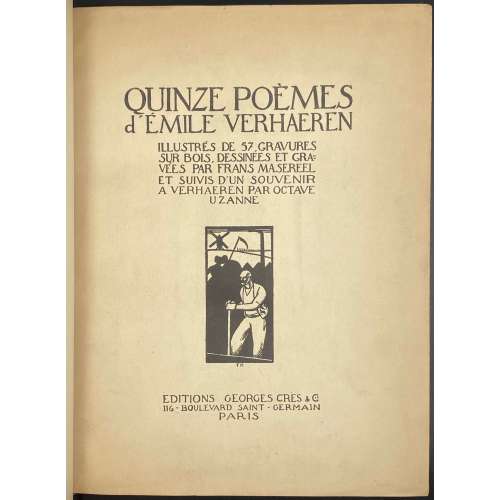 Quinze poèmes d'Emile Verhaeren. Illustrés de 57 gravures sur bois dessinées et gravées par Frans Masereel et suivis d'un 'Souvenir à Verhaeren' par Octave Uzanne. — Paris: Éditions Georges Crès, 1917. Authors: Emile Verhaeren (text), Frans Masereel (illustrations), Octave Uzanne (text). Publisher: Éditions Georges Crès. [Georges-Célestin Crès (1875 - 1935) was a French publisher and bookseller. Address: 116 boulevard Saint-Germain, Paris]. Printer: Sonor S.A. - Geneve, under the direction of Auguste Jordanis. The number of copies printed: 1555 of which 15 (1-15) on Japan paper, 190 (16-205) on Fabriano paper, and 1350 (206-1555) on English paper (1506-1555 not for trade). This copy № 1312. Pagination: [i] - front cover, [ii] - half-title, [iii] - title, [iv] - printrun justification, [v] - table of contents, [vi] - blank, [i-vii] viii-ciii, [civ] - printer statement, [cv] - back cover; one-side (recto) printing and pagination. Owner's contemporary red half-Morocco with marbled boards; spine with four raised bands, gilt lettering and design elements. Original printed paper wrappers preserved. Marbled endpapers. Trimmed unevenly.
Quinze poèmes d'Emile Verhaeren. Illustrés de 57 gravures sur bois dessinées et gravées par Frans Masereel et suivis d'un 'Souvenir à Verhaeren' par Octave Uzanne. — Paris: Éditions Georges Crès, 1917. Authors: Emile Verhaeren (text), Frans Masereel (illustrations), Octave Uzanne (text). Publisher: Éditions Georges Crès. [Georges-Célestin Crès (1875 - 1935) was a French publisher and bookseller. Address: 116 boulevard Saint-Germain, Paris]. Printer: Sonor S.A. - Geneve, under the direction of Auguste Jordanis. The number of copies printed: 1555 of which 15 (1-15) on Japan paper, 190 (16-205) on Fabriano paper, and 1350 (206-1555) on English paper (1506-1555 not for trade). This copy № 1312. Pagination: [i] - front cover, [ii] - half-title, [iii] - title, [iv] - printrun justification, [v] - table of contents, [vi] - blank, [i-vii] viii-ciii, [civ] - printer statement, [cv] - back cover; one-side (recto) printing and pagination. Owner's contemporary red half-Morocco with marbled boards; spine with four raised bands, gilt lettering and design elements. Original printed paper wrappers preserved. Marbled endpapers. Trimmed unevenly. -
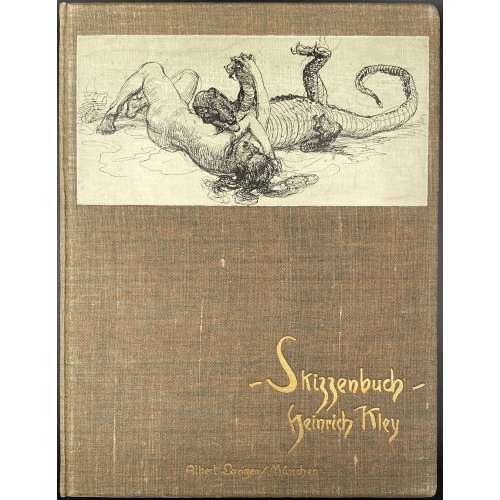
The edition consists of two albums:
1) Skizzenbuch: Hundert Federzeichnungen von Heinrich Kley. — München: Albert Langen, [1909]. — pp.: [1-4] 5-63 [64], illustr. Printed by Hesse & Becker in Leipzig. Bound in the original brown moire covered boards, with a paste-down drawing on the front, gilt cover titles, original patterned endpapers.
2) Skizzenbuch II. Hundert Federzeichnungen von Heinrich Kley. — München: Albert Langen, [1910]. — pp.: [1-4] 5-64, illustr. Printed by Hesse & Becker in Leipzig; paper by Bohnenberger & Cie.; binding by E. A. Enders, Leipzig. Bound in the original bluish-gray moire covered boards, with a paste-down drawing on the front, gilt cover titles, original patterned endpapers.
The number of printed copies unknown. Reproduction of ink drawings by Heinrich Kley, 1st edition.
Dimensions of each album: 32 x 24.5 cm; Quarto. Heinrich Kley (April 15, 1863 in Karlsruhe – 1945? in Munich) was a German illustrator, editorial illustrator and painter. -
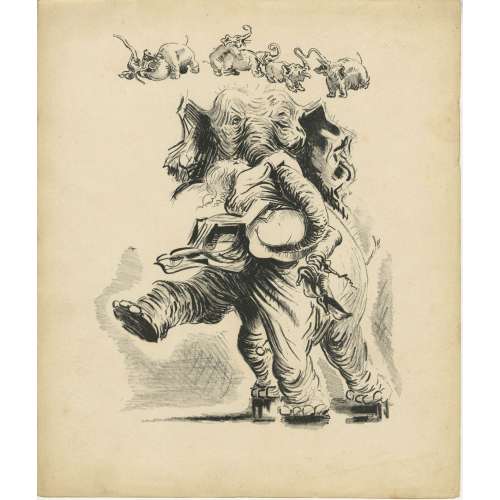
Album of 20 hand-coloured lithographs with a title page and a 'justification du tirage' page in an original snakeskin-clothed cardboard binder. Drawn on stone by Anonymous, attributed to Santippa. The theme of these pictures can be described as erotic humour.
Edition: 200 copies printed in Bruxelles, c. 1938; this copy without a number.
Watermarked wove paper: Word "Marais" and a flower.
Dimensions: 24.3 x 29.3 cm According to J.-P. Dutel, the author of these images is Georges Hoffmann under the pseudonym Santippa. Honesterotica provides a different name: Gaston Hoffmann [Santippa] (French, 1883 – 1977), which seems adequate. Catalogue raisonné: Dutel (1920-70): 2496.


